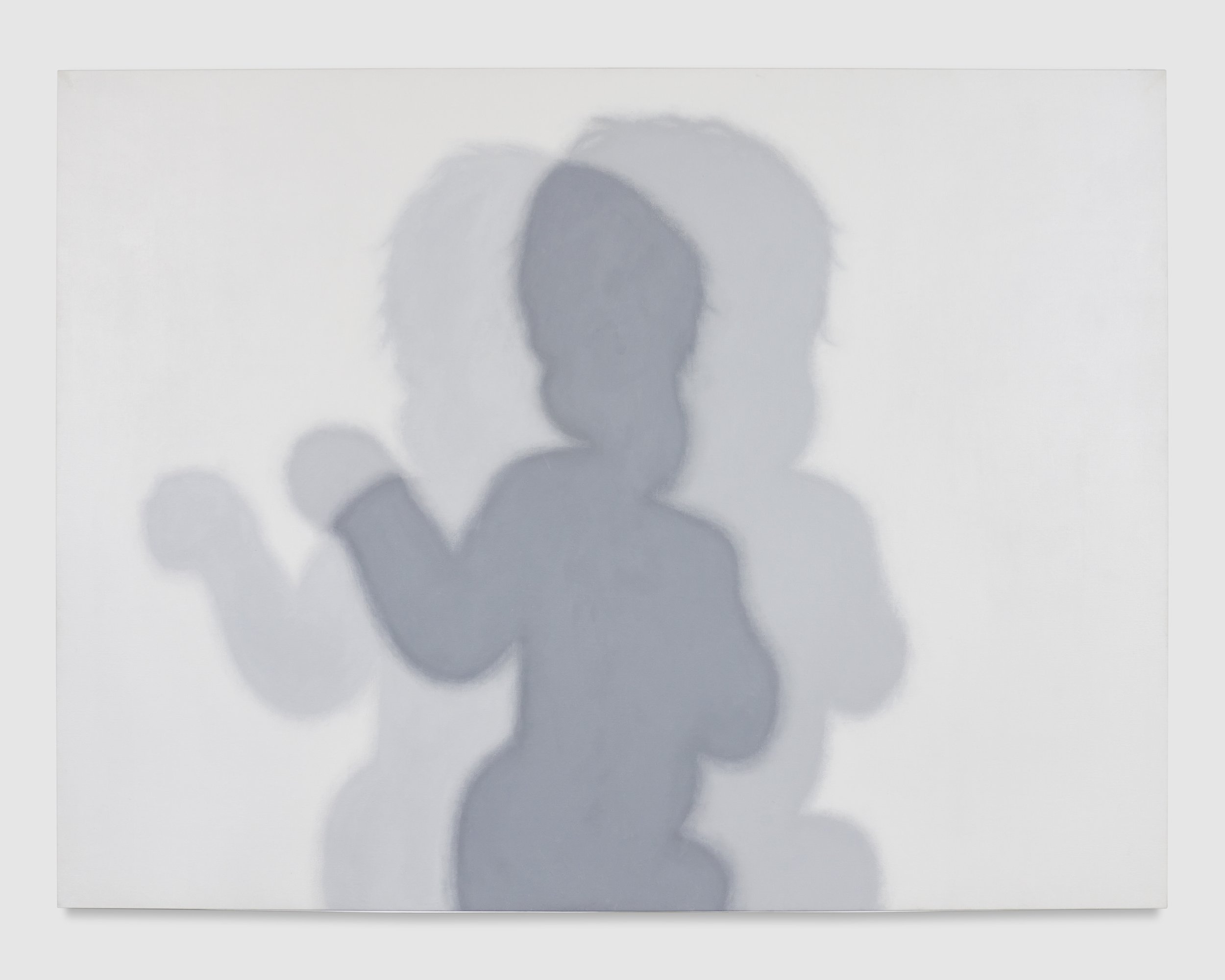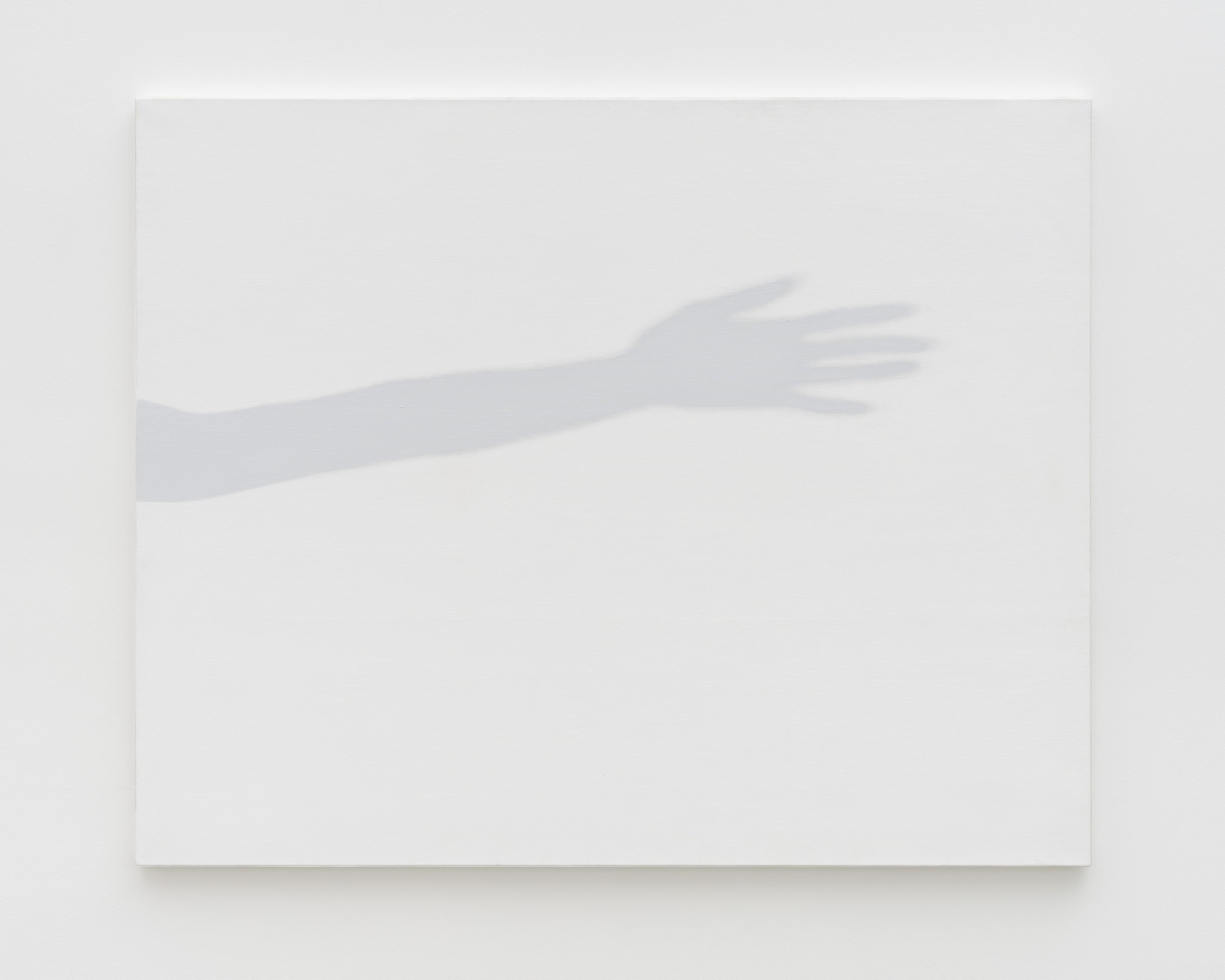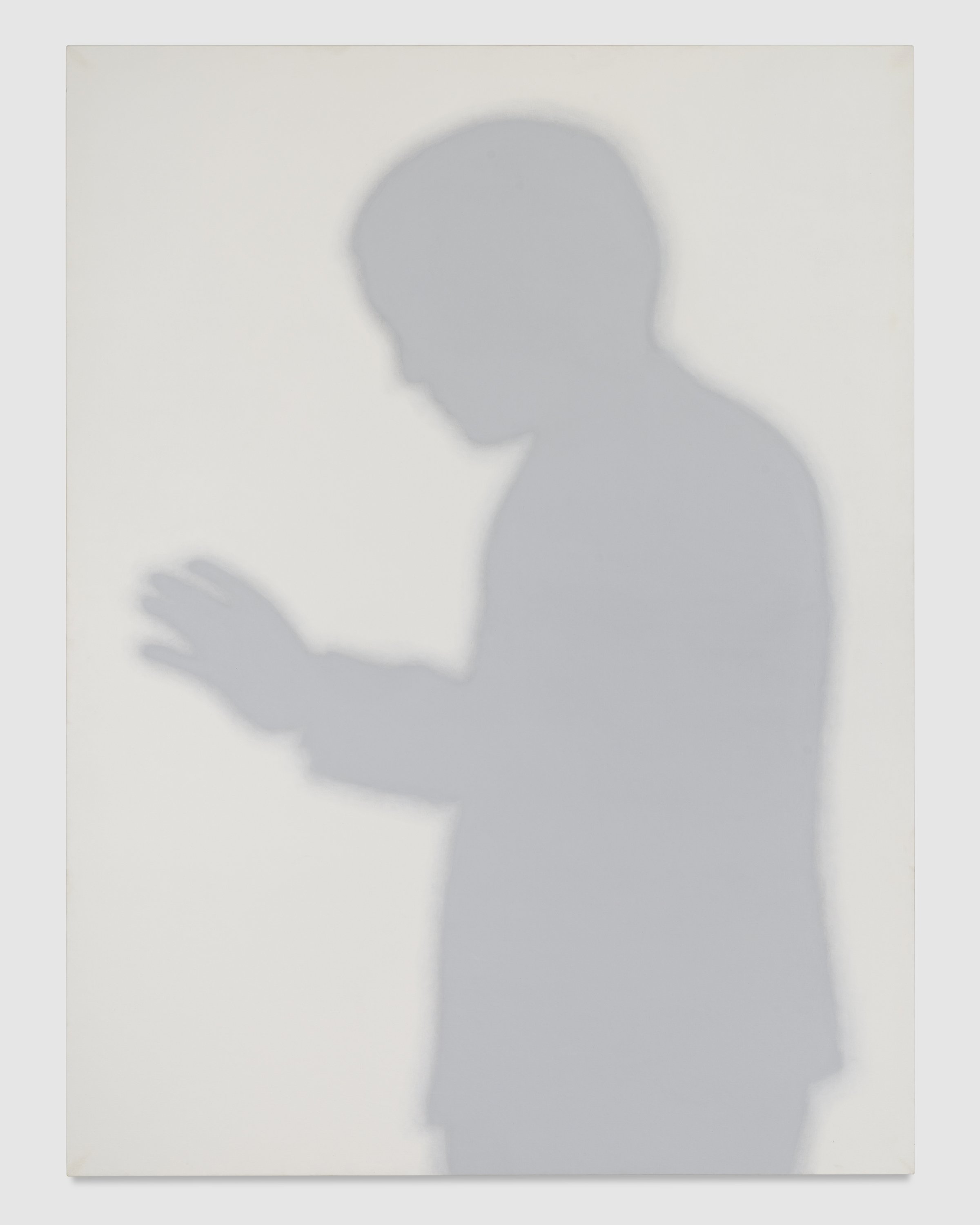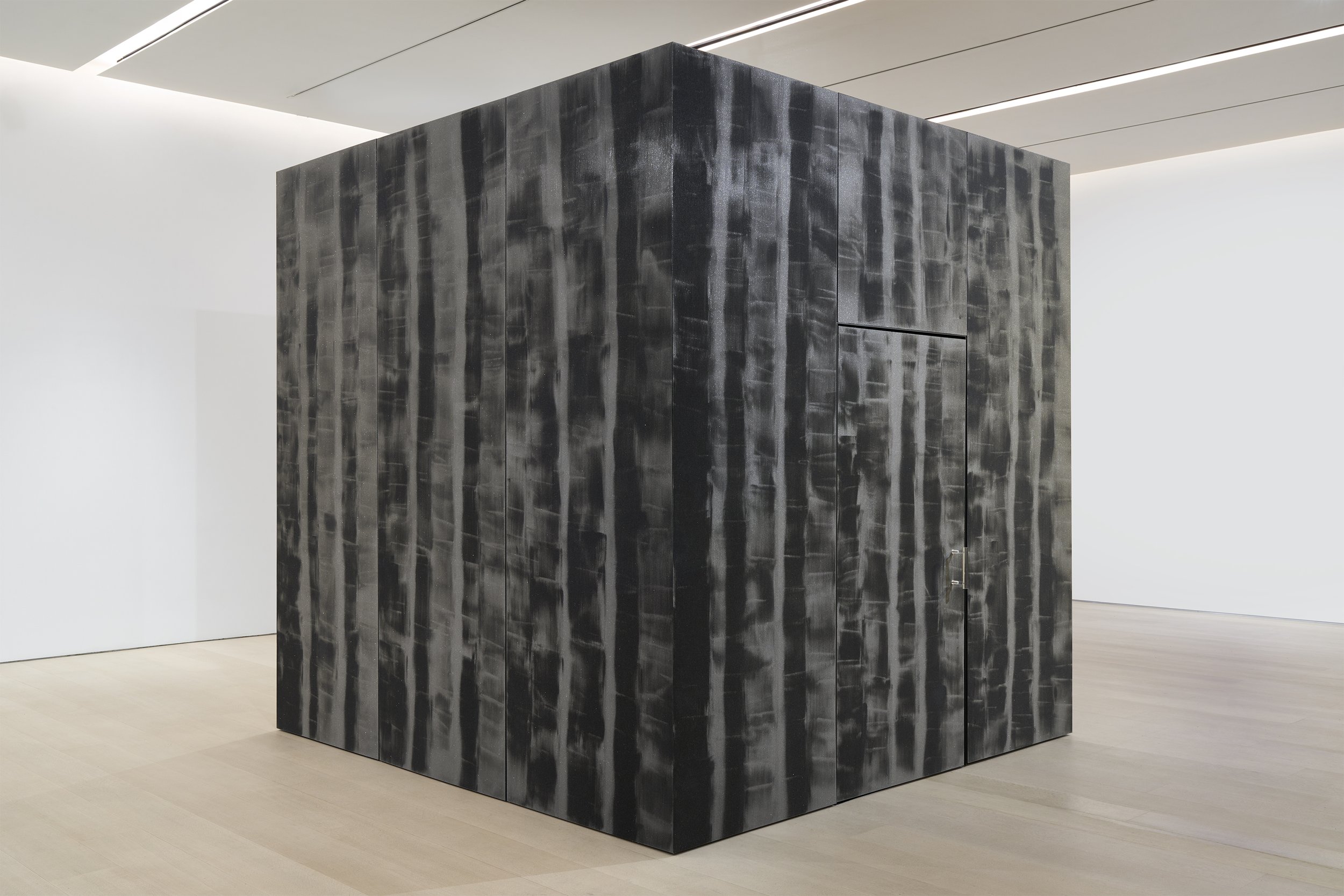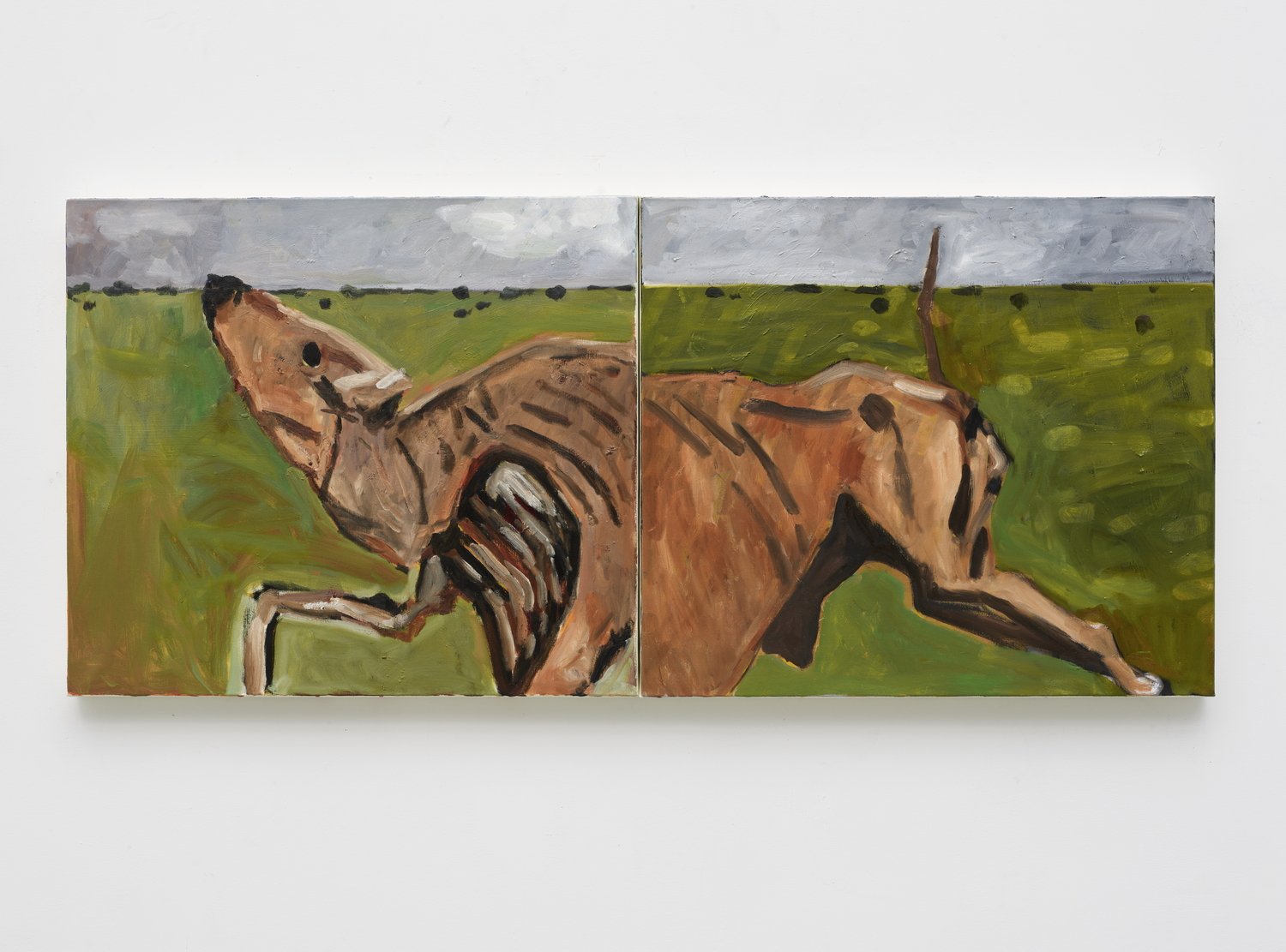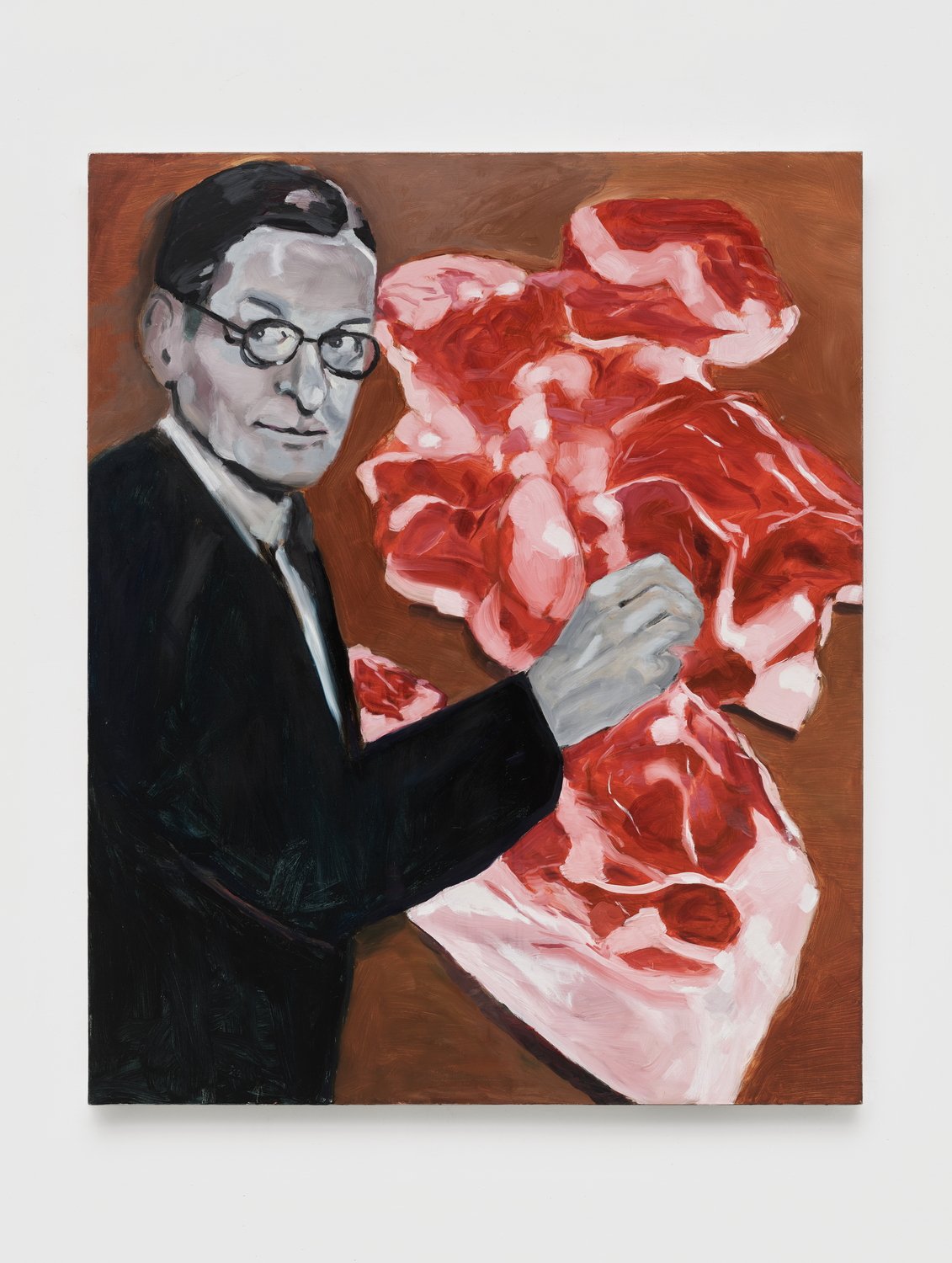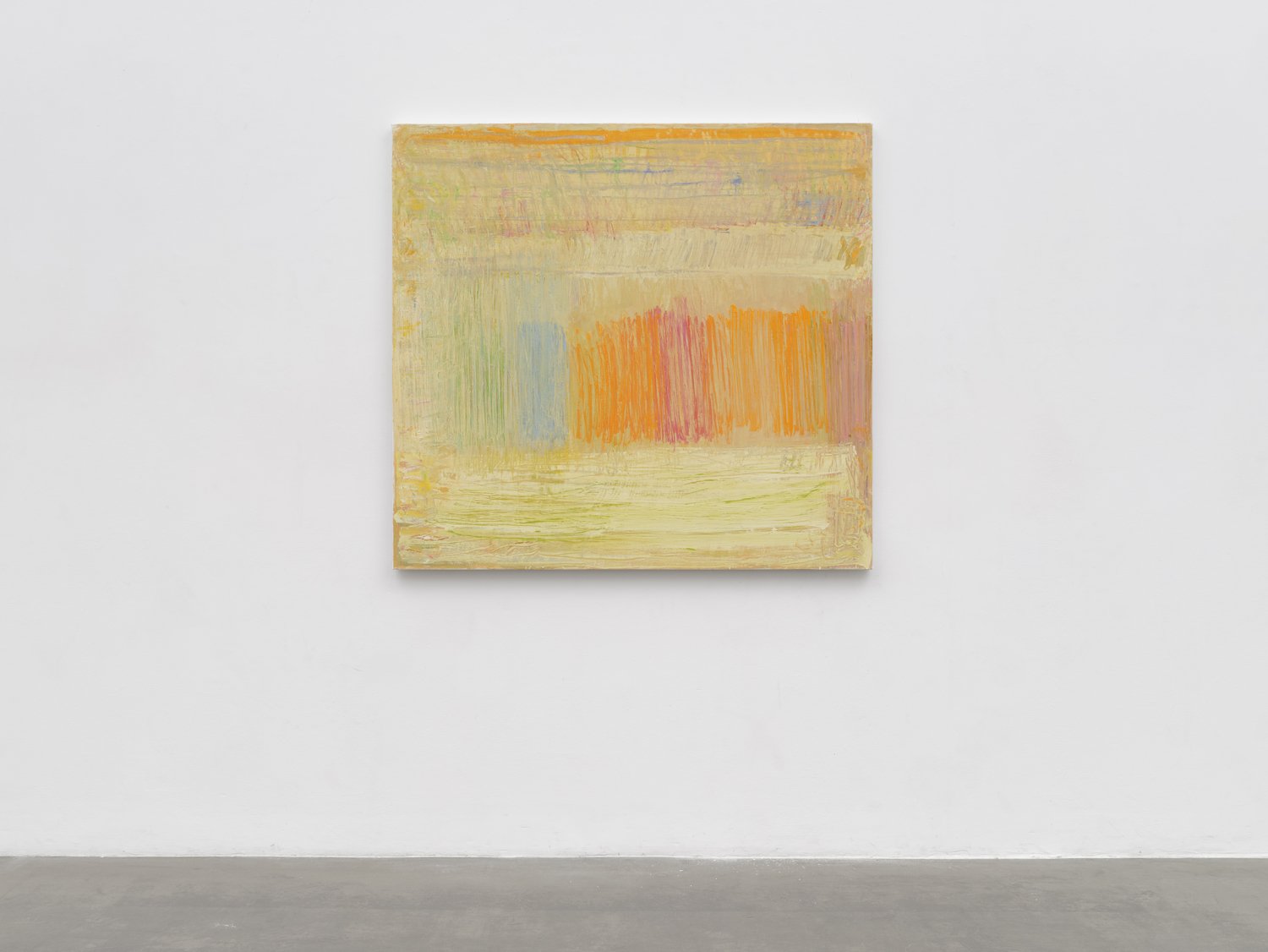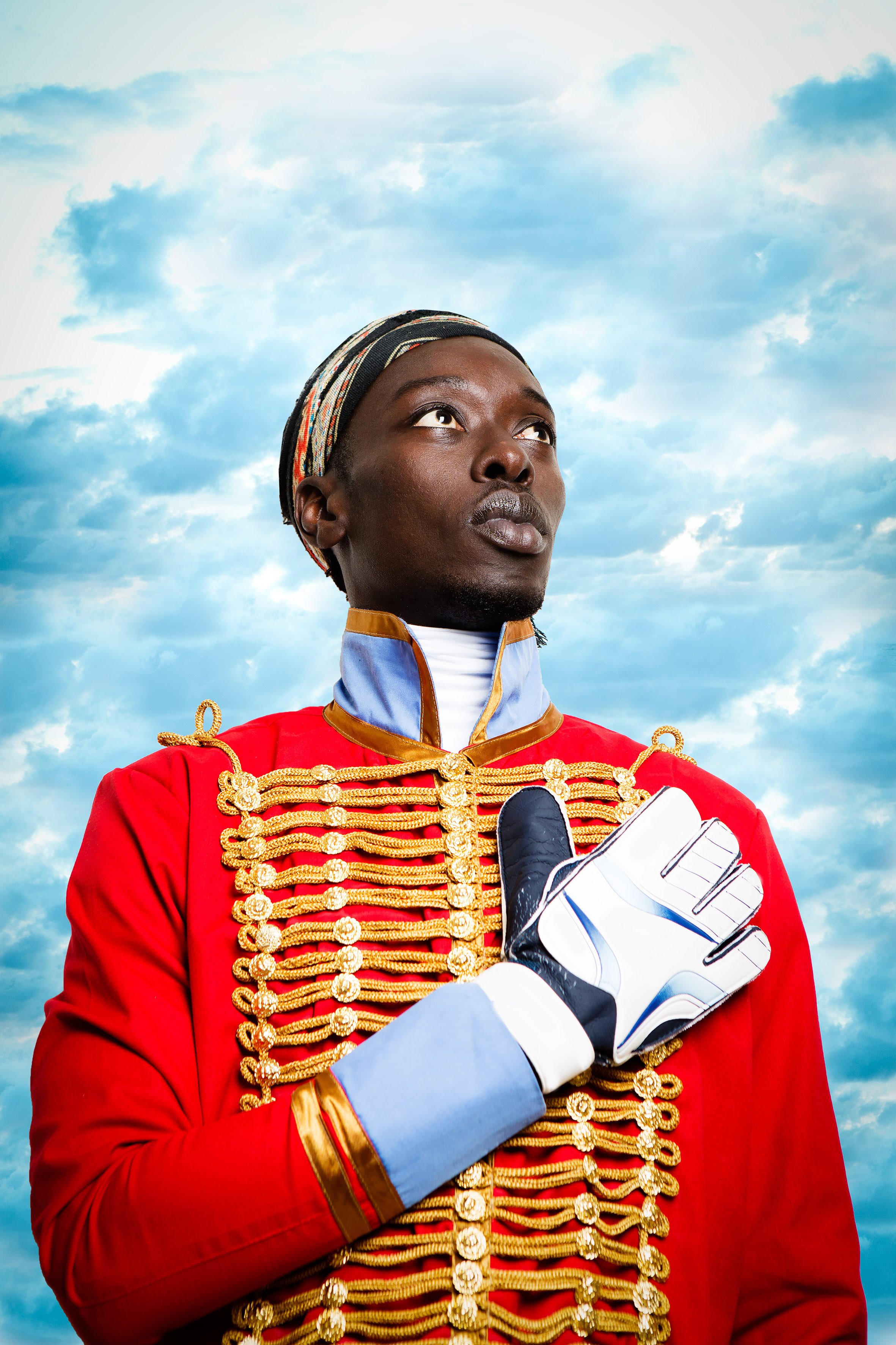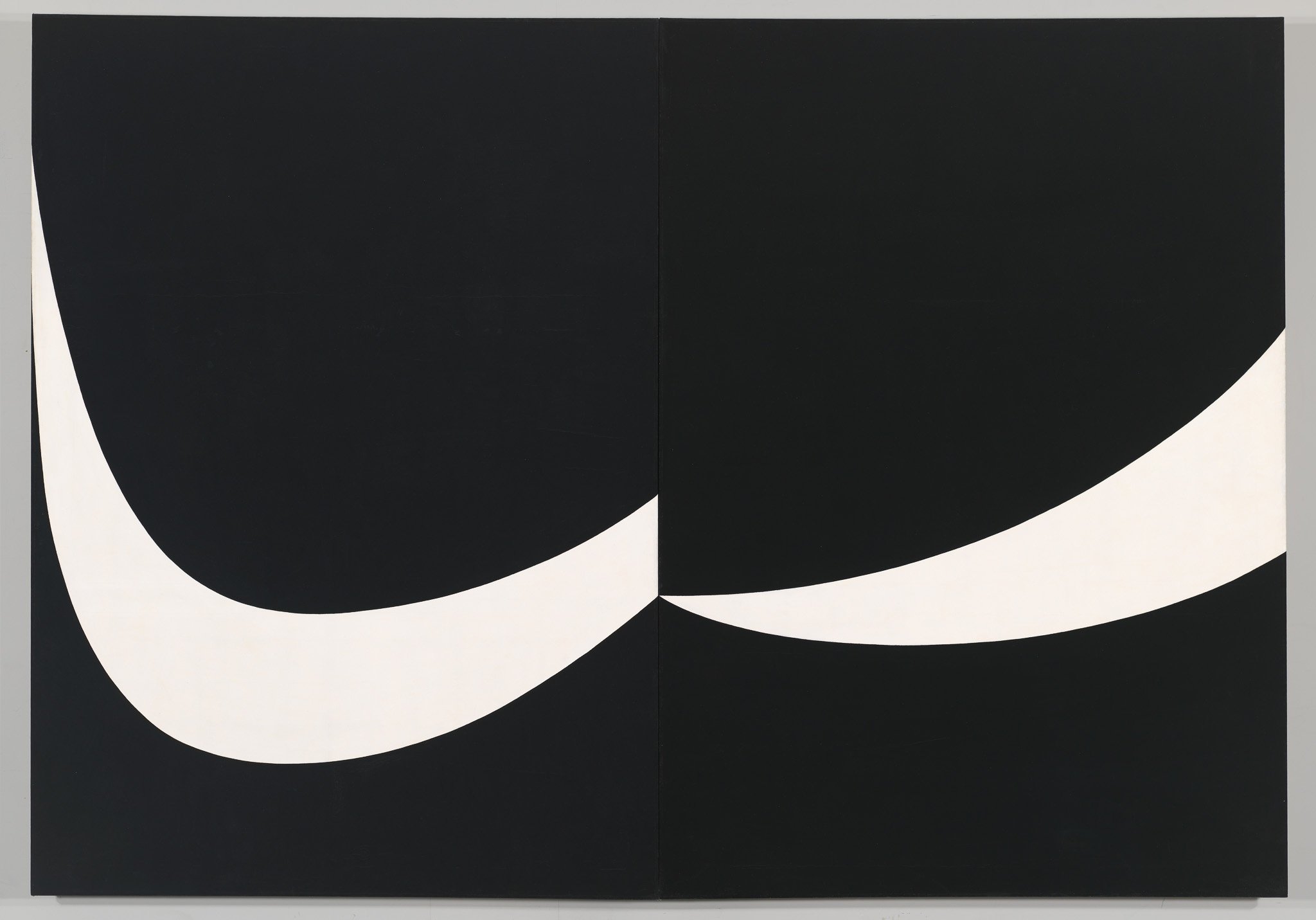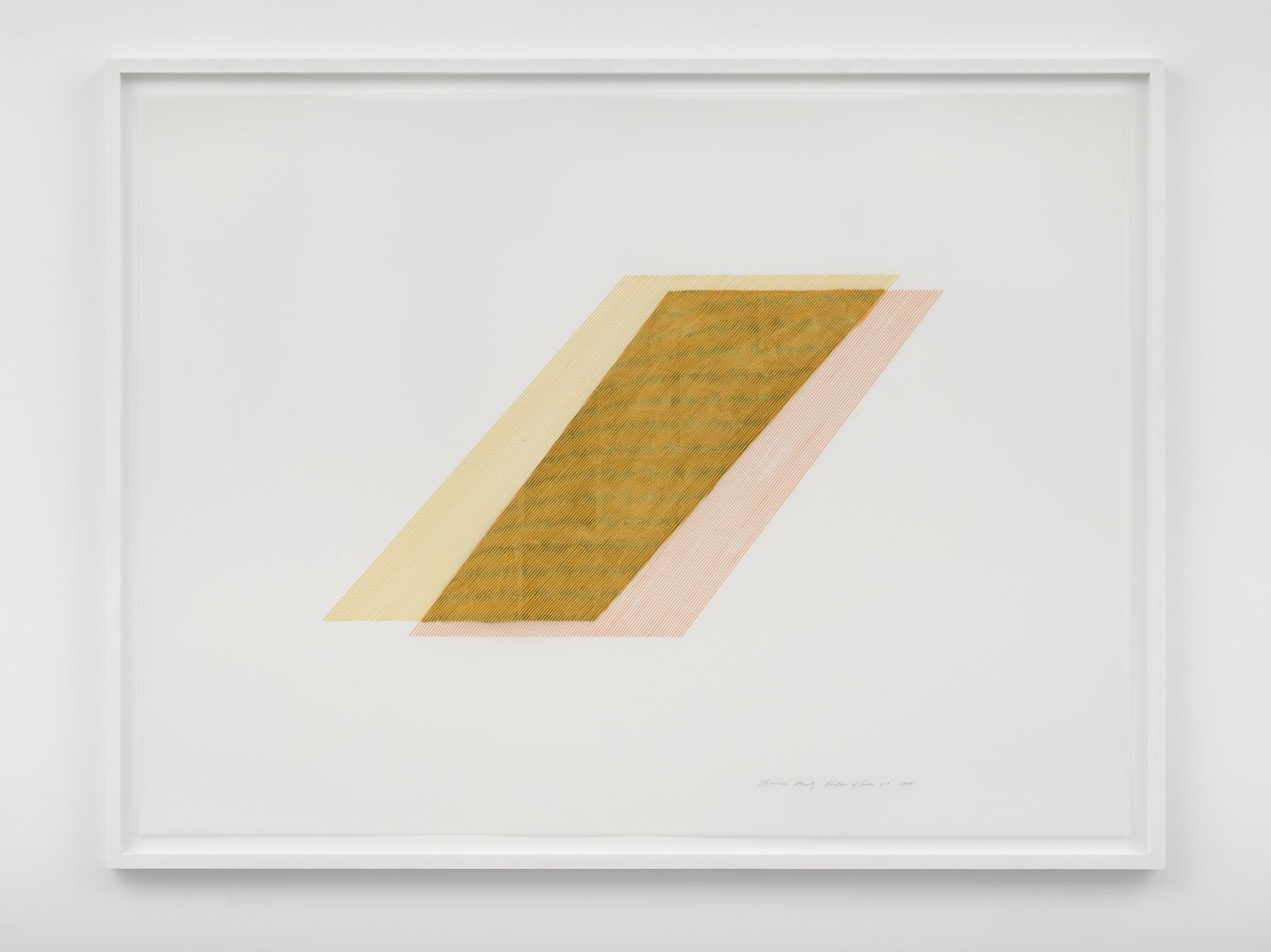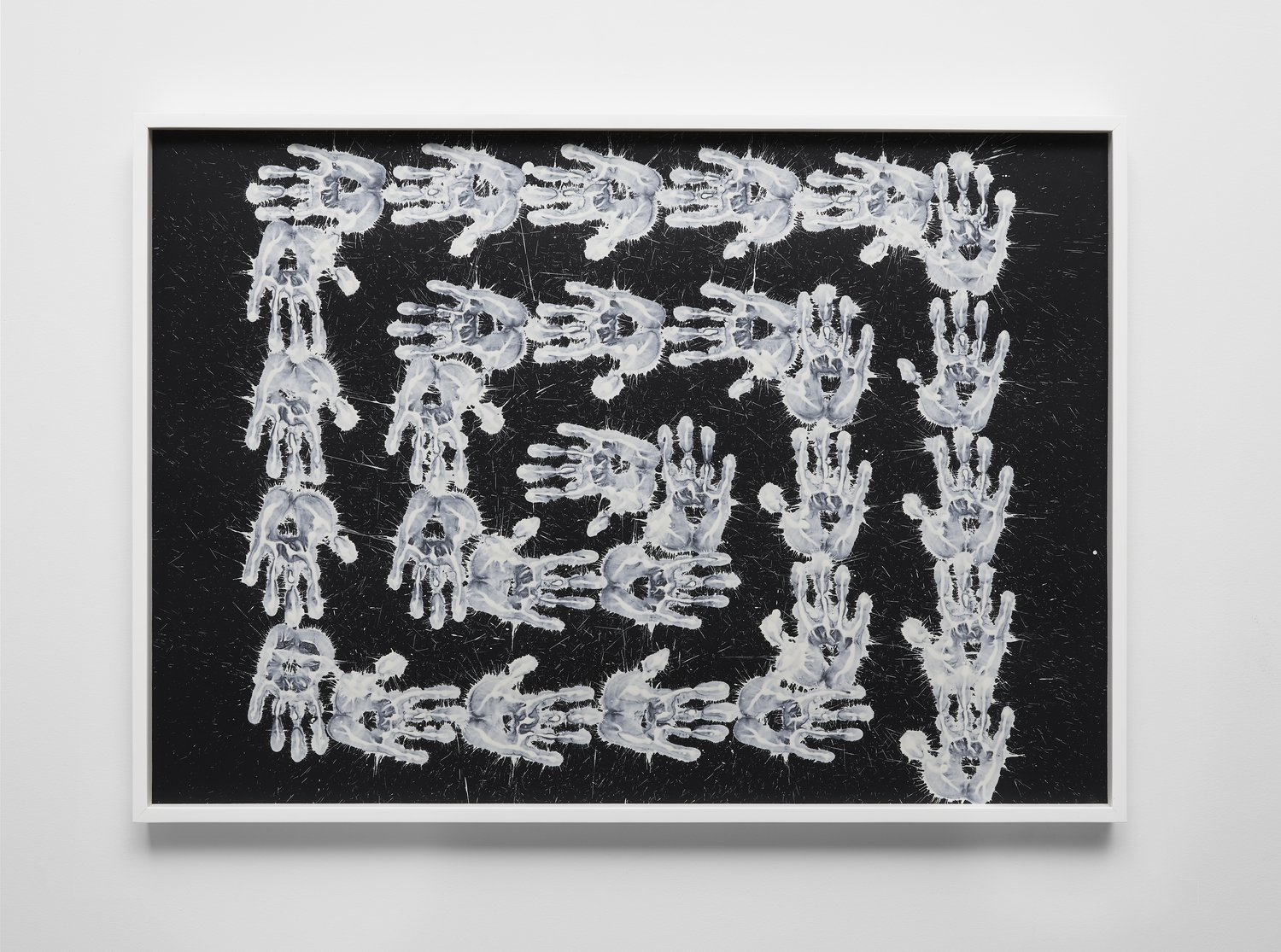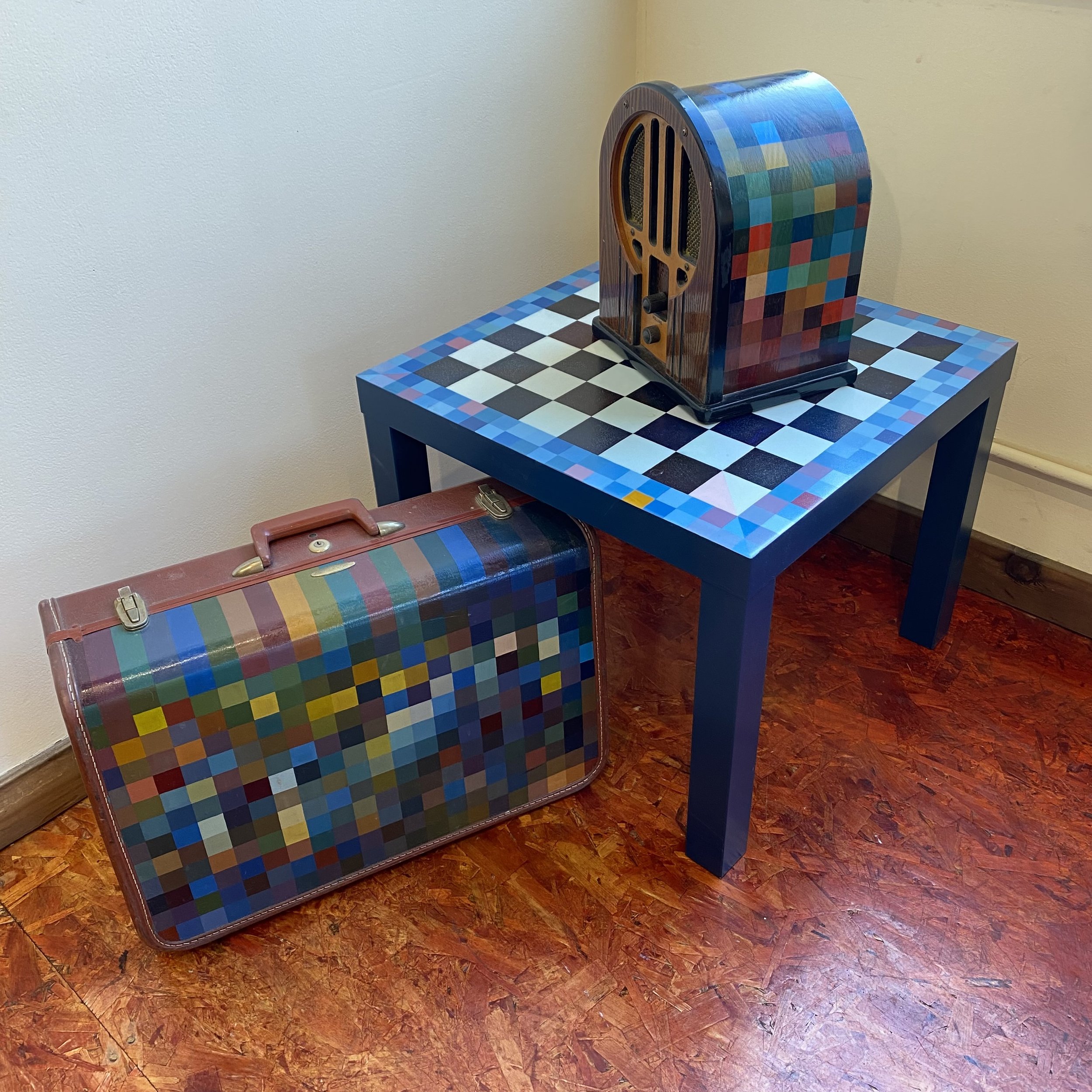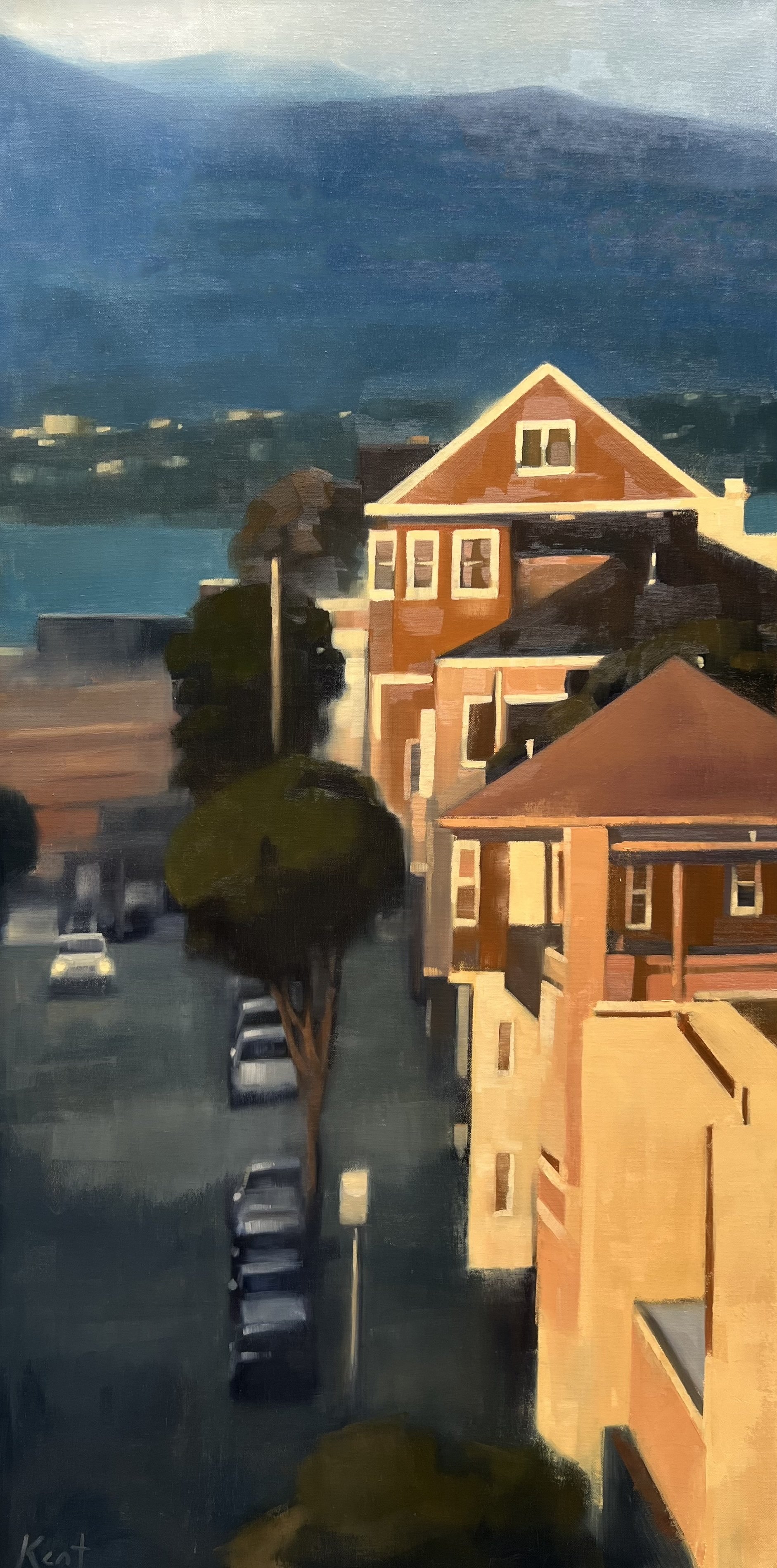Sarah Blaustein : Overture
Installation View SARAH BLAUSTEIN: Overture, 2276 E. 16th Street, Los Angeles, California 90021, September 14 — October 19, 2024 Photography courtesy Ed Mumford and Night Gallery.
Night Gallery is pleased to announce Overture, an exhibition of new paintings by Sarah Blaustein. This is the artist’s debut solo exhibition in Los Angeles and follows her participation in the group show The Big Picture, 2023.
Painter Sarah Blaustein captures fleeting moments of creativity and collision. The artist’s studio labors remain unseen, while her paintings record the blossoming of ink and acrylic across wet canvas. Domestic tools such as rags, sponges, and house painters’ brushes aid the artist as she applies paint, and water gives the marks new life. Her canvases encourage viewers to focus on the here and now, to feel more human and alive.
Sarah Blaustein Press Play R-10, 2023 ink and acrylic on canvas 95 1/2 x 75 1/2 in (242.6 x 191.8 cm) (SBS013) Photo Credit : Nik Massey
Blaustein conceives of her Night Gallery show as an overture: an introductory piece of music that produces a powerful sense of movement. The composer (here, the artist) guides the audience from the chaos of life into a focused, intentional place of being. The exhibition title also positions Blaustein as an artist confident in her rhythms, at the threshold of extended composition.
Blaustein made her Overture paintings in the San Francisco Bay Area, where she lives and works, and at the American Academy of Rome, where she was a 2023 Visiting Artist. In Rome, the artist listened to Beethoven’s “Coriolan Overture,” took inspiration from the city’s operatic fountains, and began working with Italian canvases that held water for twice as long as their American counterparts. The new substrate allowed Blaustein time to re-enter her paintings, to begin working over strokes she’d previously considered finished at first touch.




Installation, View SARAH BLAUSTEIN: Overture, 2276 E. 16th Street, Los Angeles, California 90021, September 14 — October 19, 2024 Photography courtesy Ed Mumford and Night Gallery.
This new approach is evident in works such as Press Play IT-14 (2023), a dynamic composition of jagged marks and softer featherings that appear to simultaneously erupt from the bottom of the canvas and to move back towards an unspecified origin. To further the symphonic effect, Blaustein sets bright blues, purples, and pinks against an alternately soft and acidic yellow background. As in many of her Press Play IT canvases, beauty emerges from turmoil and revision
Elsewhere, the artist’s marks radiate from her paintings’ centers to suggest feminine forms and budding flowers. If Blaustein’s paintings evoke O’Keeffe’s ecologies and Frankenthaler’s soak- stains, they also demonstrate a contemporary dilemma: the desire to turn inward while contending with an inescapably violent, disordered world.
Photo Credit : Cayce Clifford
Sarah Blaustein (b. 1982, San Francisco East Bay, CA). Blaustein is a visual artist living and working in the San Francisco Bay Area. Recent solo exhibitions include Night Gallery, Los Angeles, CA; Berggruen Gallery, San Francisco, CA; Institute of Contemporary Art San José, San José, CA; private showing and salon at PACE Gallery, Palo Alto, CA; and Hesse Flatow Gallery, New York, NY. Her work has been included in group shows at Night Gallery, Los Angeles, CA; Berggruen Gallery, San Francisco, CA; Paul Thiebaud Gallery, San Francisco, CA; Berry Campbell Gallery, New York, NY; and Hesse Flatow East Gallery, Amagansett, NY. In January 2023, art historian Alexander Nemerov (Stanford University, Palo Alto, CA) spoke about her work at a private exhibition The Call and salon hosted by Jennifer Stockman (New York, NY). In September 2023, Blaustein showed her work at a private salon To Radiate hosted by Berggruen Gallery at Casa Cipriani (New York, NY) where art historian Laura D. Corey (Metropolitan Museum of Art, New York, NY), spoke about her work and Helen Hatch (MOMA, New York, NY) moderated the talk. In June and December 2023, she painted at the American Academy of Rome through their Artist and Scholars Program (Rome, Italy). Blaustein has exhibited her work at The Armory Show (New York, NY), Art Basel Miami Beach (Miami, FL), Dallas Art Fair (Dallas, TX) and Fog Design + Art (San Francisco, CA). In 2023, she exhibited her work in Trodden Path a group show at Hesse Flatow East (Amagansett, NY) and The Big Picture a group show at Night Gallery (Los Angeles, CA). In 2024, she showed her work in Abstract Perspectives and California Gold group shows at Berggruen Gallery (San Francisco, CA).
Overture opened on September 14 and will be on view until October 19 of this year at Night Gallery, located at 2276 E. 16th Street, Los Angeles, California 90021; the gallery’s website can be found here for more information about this exhibit and others. Sarah’s interview with the magazine can be found here.
Jiro Takamatsu: The World Expands
Jiro Takamatsu: The World Expands 540 West 25th Street, New York, NY 10001 September 20 – November 2, 2024 Photography courtesy Pace Gallery
New York – Pace is pleased to present its first exhibition of Jiro Takamatsu—a profoundly influential artist, theorist, and teacher who emerged in postwar Japan in the early 1960s—since its representation of the artist’s estate this year. The exhibition opened on September 20 and will be open until November 2; the presentation at the gallery’s 540 West 25th Street flagship in New York will focus on Takamatsu’s Shadow and Perspective concepts—throughout his entire oeuvre, Takamatsu used the term “concept” to denote certain ideas or phenomena. Bringing together a selection of his paintings, drawings, and sculptural objects dating from 1966 to 1997, this exhibition will showcase his inventive, deeply philosophical practice and his important role in the development of Conceptual Art.
A prolific artist who produced thousands of works over the course of his 40-year career, Takamatsu worked across painting, sculpture, drawing, photography, and performance, exploring questions about perception, space, existence, and absence. Early in his practice, during the 1960s, he staged performative interventions in public spaces around Tokyo as part of the artist collective Hi Red Center, liberating art from its traditional context and shaking the foundations of the Japanese art world at the time. Presenting politically minded actions in public spaces throughout postwar Tokyo, Hi Red Center sought to dissolve boundaries between art and life—producing what the group called a “descent into the everyday”—through experimental and unorthodox approaches to making. It was also during this decade, in 1968, that Takamatsu represented Japan at the 34th Venice Biennale, cementing his status as a key figure within the international avant-garde.
Jiro Takamatsu Double Shadow of a Baby, 1969- 1997 Acrylic on canvas 85-7/8" × 9' 6" (218.1 cm × 289.6 cm) No. 92867 © The Estate of Jiro Takamatsu, Courtesy Yumiko Chiba Associates, Tokyo, Pace Gallery, New York and Stephen Friedman Gallery, London. Photo by Richard Gary.
Viewing the act of creating as an intensely intellectual endeavor, Takamatsu adopted a somewhat reclusive, solitary lifestyle as part of his practice. Grounded by his thoughts about and observations of the world around him, the artist’s highly conceptual works often examine ideas about reality and the self, matter and space, and presence and absence. Producing diverse bodies of work simultaneously, he examined these concepts through various mediums and forms. In one of Takamatsu’s best-known bodies of work—his iconic Shadow paintings, which he created from 1964 up until his death in 1998—he explored questions of perception and dimension as they relate to our experience of matter. In these illusionistic paintings depicting shadows of figures and objects, he presents a visual summation of the complex relationships between that which is at once existent and nonexistent, tangible and intangible, in both physical and metaphysical terms.
Jiro Takamatsu: The World Expands 540 West 25th Street, New York, NY 10001 September 20 – November 2, 2024 Photography courtesy Pace Gallery
A selection of the artist’s Shadow paintings and drawings will figure in Pace’s upcoming presentation in New York, alongside works from his lesser-known Perspective series. Takamatsu began creating his Perspective paintings, drawings, and sculptures in the mid-1960s in tandem with his Shadow works, and the relationship between these two concepts hinges on the illusionistic potential of space, when perspective is bent by human intervention. While many of his two-dimensional, mathematically minded Perspective works depict silhouetted figures occupying geometric structures within different planes, some of these compositions are devoid of figures, focusing instead on the ways that combinations of shapes can imply interiority, exteriority, and depth. Several material objects from the Perspective series on view in the gallery’s show will shed light on the ways in which Takamatsu extended these inquiries into three dimensions, imbuing his painted abstractions with a physicality that makes them all the more surreal.
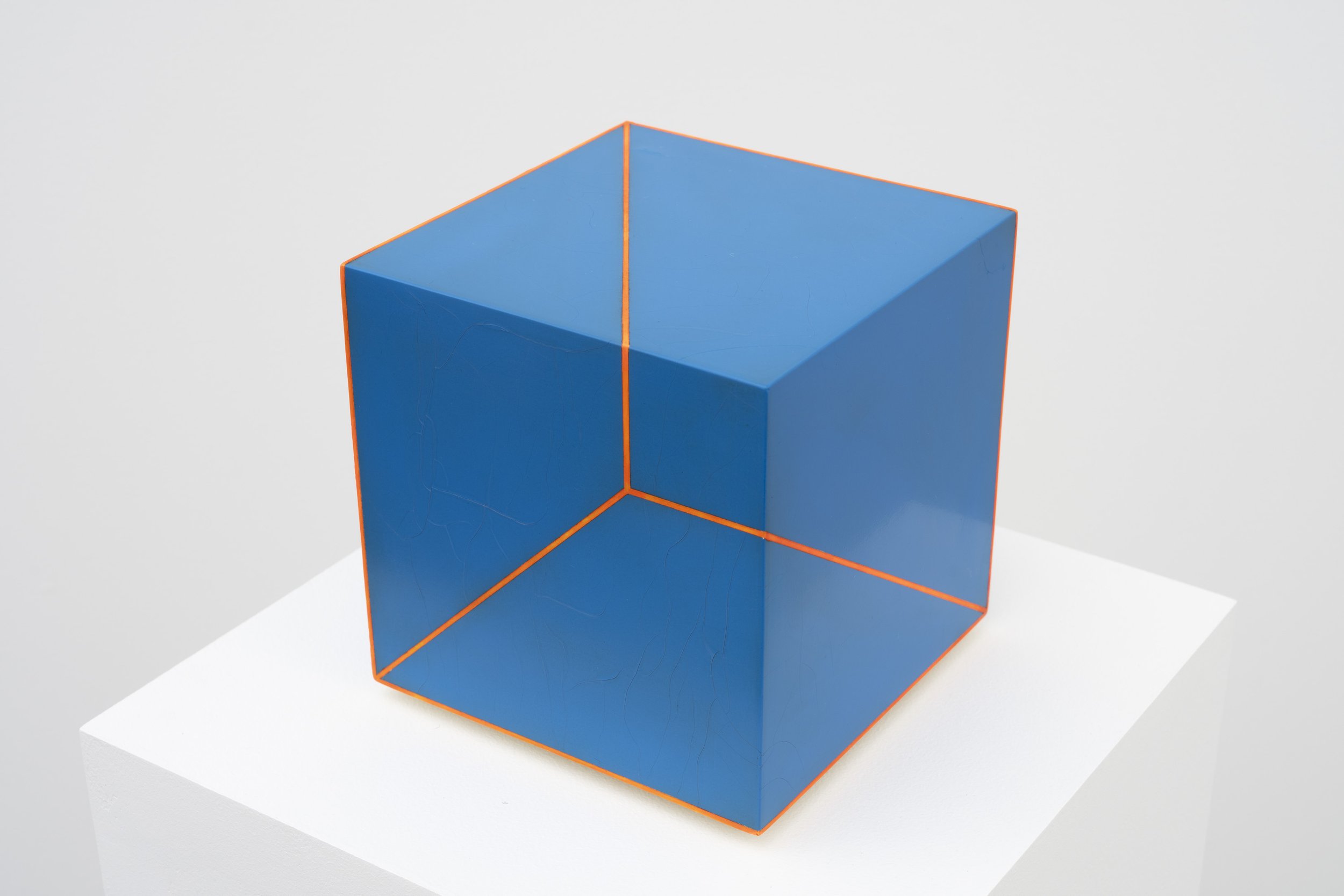

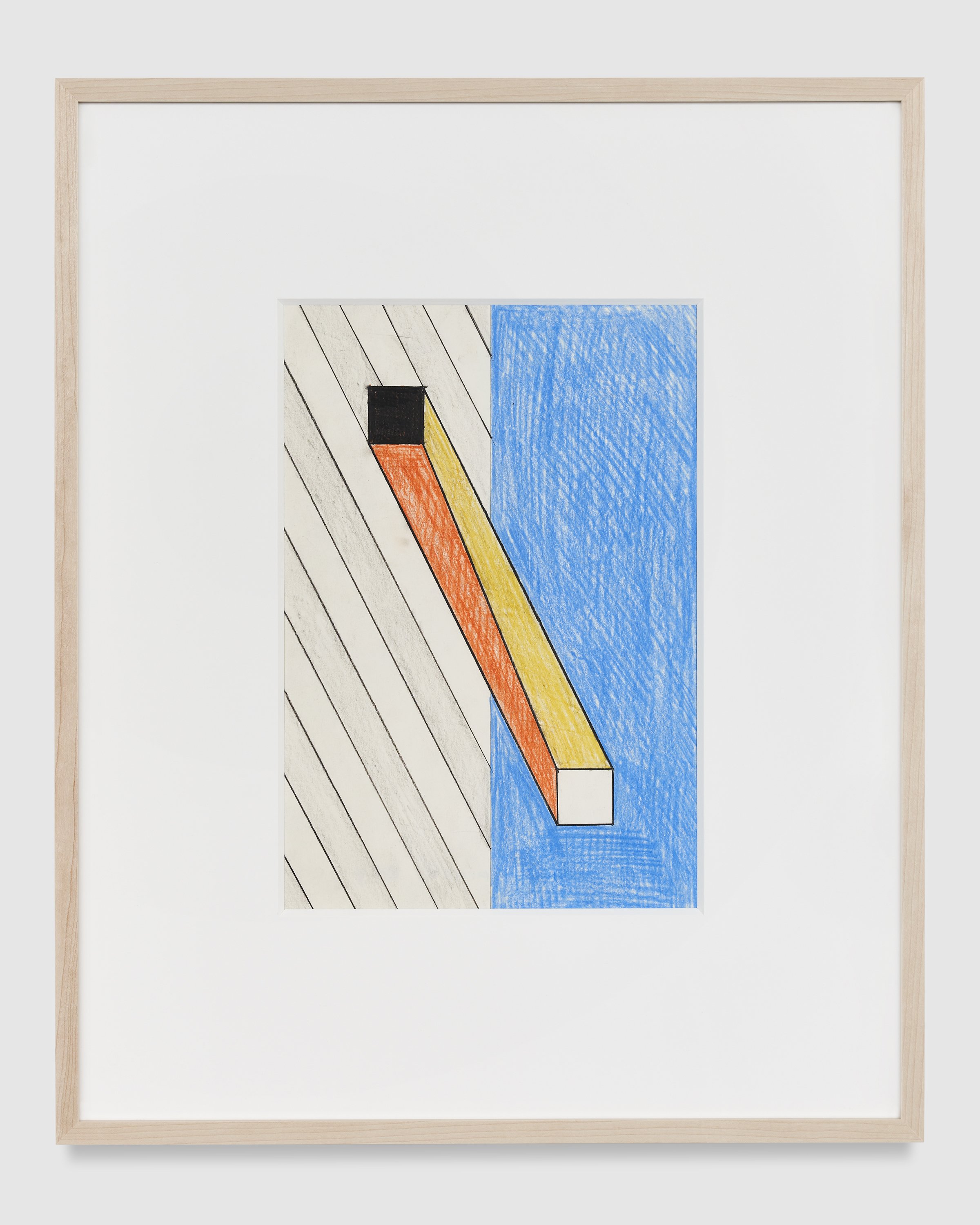
Engaging with histories of Dadaism and Surrealism through a minimalist visual language. Jiro Takamatsu’s (b. 1936, Tokyo; d. 1998, Tokyo) art centers on metaphysical ideas and concepts related to time, space, and emptiness. Over the span of his four-decade career, the artist engaged with a range of mediums, including sculpture, photography, painting, drawing, and performance art, through which he explored concepts related to perception, space, and objecthood. Takamatsu studied at the Tokyo National University of Fine Arts and Music, where he cultivated an interdisciplinary artistic practice after graduating in 1958. In the following years, he helped establish the collective known as Hi Red Center (1963– 64), which sought to dissolve boundaries between art and life through politically minded actions in public spaces. Takamatsu was also a leading figure in the Mono-Ha (School of Things) movement, centering on materiality and material conditions through non-representational art. Through his practice, Takamatsu investigated how painting could serve as a tool for critical inquiry, questioning the role of perceptual and visual phenomena in constructing notions of reality.
An influential figure of the Japanese avant-garde, presenting numerous solo exhibitions during his lifetime, Takamatsu is once again the subject of international attention, his practice lauded by scholars and curators across institutions globally.
Jiro Takamatsu Shadow No. 1452, 1997 acrylic on canvas 51-5/16" × 63-13/16" (130.3 cm × 162.1 cm) No. 92240 © The Estate of Jiro Takamatsu, Courtesy Yumiko Chiba Associates, Tokyo, Pace Gallery, New York and Stephen Friedman Gallery, London. Photo by Peter Clough.
In 2014, the National Museum of Modern Art in Tokyo opened Jiro Takamatsu: Mysteries, which traced three distinct phases of his career; in 2015, the National Museum of Art in Osaka mounted the major retrospective Jiro Takamatsu: Trajectory of Work. Takamatsu has also been the subject of solo exhibitions at the Henry Moore Institute, Leeds, United Kingdom (2017) and the Royal Society of Sculptors, London (2019). The artist’s work is held in important public collections worldwide, including Aomori Museum of Art, Japan; Dallas Museum of Art, Texas; The Museum of Modern Art, New York; The National Museum of Art, Osaka; The National Museum of Modern Art, Tokyo; Solomon R. Guggenheim Museum, New York; and Tate, London; among others.
Jiro Takamatsu Shadow, 1989/1997 Acrylic on canvas 9' 6-3/4" × 85-7/8" (291.5 cm × 218.1 cm) No. 89830 © The Estate of Jiro Takamatsu, Courtesy Yumiko Chiba Associates, Tokyo, Pace Gallery, New York and Stephen Friedman Gallery, London. Photo by Richard Gary.
Pace is a leading international art gallery representing some of the most influential artists and estates of the 20th and 21st centuries, founded by Arne Glimcher in 1960. Holding decades-long relationships with Alexander Calder, Jean Dubuffet, Agnes Martin, Louise Nevelson, and Mark Rothko, Pace has a unique history that can be traced to its early support of artists central to the Abstract Expressionist and Light and Space movements. Now in its seventh decade, the gallery continues to nurture its longstanding relationships with its legacy artists and estates while also making an investment in the careers of contemporary artists, including Torkwase Dyson, Loie Hollowell, Robert Nava, Adam Pendleton, and Marina Perez Simão. Under the current leadership of CEO Marc Glimcher and President Samanthe Rubell, Pace has established itself as a collaborative force in the art world, partnering with other galleries and nonprofit organizations around the world in recent years. The gallery advances its mission to support its artists and share their visionary work with audiences and collectors around the world through a robust global program anchored by its exhibitions of both 20th century and contemporary art and scholarly projects from its imprint Pace Publishing, which produces books introducing new voices to the art historical canon. This artist-first ethos also extends to public installations, philanthropic events, performances, and other interdisciplinary programming presented by Pace.
Today, Pace has eight locations worldwide, including two galleries in New York—its eight-story headquarters at 540 West 25th Street and an adjacent 8,000-square-foot exhibition space at 510 West 25th Street. The gallery’s history in the New York art world dates to 1963, when it opened its first space in the city on East 57th Street. A champion of Light and Space artists, Pace has also been active in California for some 60 years, opening its West Coast flagship in Los Angeles in 2022. The gallery maintains European footholds in London and Geneva as well as Berlin, where it established an office in 2023.
Pace was one of the first international galleries to have a major presence in Asia, where it has been active since 2008, the year it first opened in Beijing’s vibrant 798 Art District. It now operates galleries in Hong Kong and Seoul and opens its first gallery in Japan in Tokyo’s Azabudai Hills development in 2024.
Photography courtesy Pace Gallery. For more information about this exhibition and others, please visit the Pace Gallery’s website here. Pace Gallery can be found on Instagram and Artsy, too.
Mary Corse: Presence in Light






Mary Corse: Presence in Light 540 W 25th Street, New York, NY September 13 – October 26 Photography courtesy Pace Gallery
New York – Pace is pleased to present an exhibition of new work by Mary Corse at its 540 West 25th Street gallery in New York. Which opened on September 13th and will be on view until October 26, this presentation marks Corse’s first solo show in the city since 2019 and follows several recent institutional exhibitions by the artist at the Long Museum West Bund in Shanghai and the Amorepacific Museum of Art in Seoul, as well as her 2018 traveling retrospective at the Whitney Museum of American Art in New York and the Los Angeles County Museum of Art. Corse’s upcoming exhibition at Pace will coincide with her participation in Particles and Waves: Southern California Abstraction and Science, 1945–1990—a group exhibition organized as part of the Getty’s PST ART: Art & Science Collide initiative—at the Palm Springs Art Museum in California.
Untitled (Yellow Diamond with White Inner Band)2024 PAINTING glass microspheres in acrylic on canvas 92" × 92" × 4" (233.7 cm × 233.7 cm × 10.2 cm) No. 92698
Over the course of her six-decade career, Corse has explored phenomena of light, space, and perception in sublime and boundary-crossing abstractions across mediums. A key member of the Los Angeles artist community from the 1960s to the present, she is often associated with the Light and Space movement but has always been committed to the possibilities of painting, which remains her primary concern. As part of her empirical and highly tactile approach to art making, Corse has continually investigated the ways in which light can be both subject and material. In the late 1960s, while searching for a way to embed light inside her paintings, Corse experienced an epiphany. Driving along the Pacific Coast Highway in Malibu at sunset, she noticed the road markings were progressively illuminated by headlights as she drove along. Investigating the industrial applications that make this effect possible, she discovered glass microspheres—a material used to enhance visibility of road signage. In 1968, Corse began applying these refractive microspheres onto the surfaces of her White Light paintings, endowing these works with a sense of illumination projected from within the picture plane itself.
The body of work that Corse will debut in her presentation at Pace in New York this fall centers on a new series of diamond-shaped paintings, which continue her longstanding practice of incorporating glass microspheres into the painted surface. Corse has experimented with the physical structure of her canvases since her time as a student at the Chouinard Art Institute in Los Angeles between 1964 and 1968. Although she created her first diamond-shaped paintings while still in her 20s, this body of work marks the first diamond-shaped canvases she has made since the 1960s. Corse’s return to the format of the diamond underscores one of the hallmarks of her practice: an interest in recursion and return to early ideas. With her new Diamond paintings, the artist delves ever deeper into the fundamental concepts that animated her practice at its outset. She expands the scope of her inquiry into the metaphysical dimensions of her oeuvre through these new iterations of ideas that have long been essential to the work.
Untitled (Blue Diamond with Black Inner Band), 2024 PAINTING glass microspheres in acrylic on canvas 92" × 92" × 4" (233.7 cm × 233.7 cm × 10.2 cm) No. 92671 © Mary Corse, courtesy Pace Gallery
The works in the presentation at Pace, all of which have never before been exhibited, will include Corse’s Halo Room, a new architectural installation that she has been developing over the last several years. This work, which will be installed in the center of the gallery space but can also be placed outdoors, offers a participatory, intimate experience of scale, space, and light. When a viewer enters the room, a single interior light projects their shadow onto a White Light painting. The resulting effect produces a glowing halo around the viewer’s shadow, registering their presence but also incorporating it into the painting itself. The installation hinges on the energetic relationship between individual and object, producing a moment of intersubjective collision that facilitates a spiritual manifestation of bodies within space. Up to two participants will be allowed inside the installation at a time, and each viewer will only be able to see their own halo—a phenomenon that speaks to the personal nature of experiencing Corse’s art.
The Halo Room 2023-2024 SCULPTURE glass microspheres in acrylic on powder coated aluminum, glass microspheres in acrylic on canvas, light 9' × 10' × 11' (274.3 cm × 304.8 cm × 335.3 cm) No.92448 © Mary Corse, courtesy Pace Gallery
Corse’s Halo Room continues and deepens a long tradition of grappling with questions of presence in post-1960s art. In his 1967 essay “Art and Objecthood,” the critic Michael Fried famously condemned Minimal aesthetics for their perceived “theatricality.” Fried contrasted this with an all-over painting, in which the entire composition could be perceived by the viewer all at once, in a single instant. Fried called this quality “presentness,” and in the essay, he famously declared: “Presentness is grace.” Although not a minimalist, Corse is associated with many of the post- 1960s practices to which Fried was referring, having shown with Dick Bellamy’s Green Gallery in New York in the late 1960s. Her new work is equally concerned with questions of presence and presentness. The Halo Room serves as a counterpoint to Fried’s argument, in which the presence and presentness of the viewer within the work itself—both literally and pictorially—becomes a pure expression of grace, a reflection of the ethos that has animated Corse’s practice for decades: the work of art is, as she puts it, “not on the wall, it’s in your perception.”
Untitled (White Diamond with Black Inner Band)2024 PAINTING glass microspheres in acrylic on canvas 110-3/8" × 110-3/8" × 3-3/4" (280.4 cm × 280.4 cm × 9.5 cm) No. 92442 © Mary Corse, courtesy Pace Gallery
Mary Corse (b. 1945, Berkeley, California) investigates materiality, abstraction, and perception through the subtly gestural and precisely geometric paintings that she has made over her sixty-year career. Earning a BFA in 1968 from Chouinard Art Institute, Los Angeles, Corse developed her initial work during the emergence of the Light and Space movement in Southern California. Throughout the 1960s, she experimented with unconventional media and supports, producing shaped canvases, works with plexiglass, and illuminated boxes. In 1968, Corse discovered glass microspheres, an industrial material used in street signs and dividing lines on highways. Combining these tiny refractive beads with acrylic paint, she began to create paintings that appear to radiate light from within and produce shifts in appearance contingent on their surroundings and the viewer’s position. She first developed her White Light paintings, and by the 70s she transitioned to making her Black Light series with black acrylic and microspheres. The Black Earth works followed: large ceramic slabs that she fired in a custom-built kiln and glazed black. After thirty years of working monochromatically, she reintroduced primary colors into her paintings based on her understanding of color as constitutive of white light. Corse’s art emphasizes the abstract nature of human perception, expanding beyond the visual to include subtleties of feeling and awareness.
Untitled (Black Diamond with Black Inner Band), 2023 PAINTING glass microspheres in acrylic on canvas 70-3/4" × 70-3/4" × 4-1/2" (179.7 cm × 179.7 cm × 11.4 cm) No. 90272 © Mary Corse, courtesy Pace Gallery
In 2021, Corse was the subject of a major solo exhibition at the Long Museum, Shanghai which traveled to the Amorepacific Museum of Art in Seoul in 2022. Mary Corse: A Survey in Light, the artist’s first solo museum survey, was presented at the Whitney Museum of American Art, New York and the Los Angeles County Museum of Art in 2018 and 2019, respectively. Comprehensive catalogs were published with both surveys. A focused presentation of Corse’s work was on view at Dia: Beacon in New York for four years highlighting historical works from the collection.
Untitled (White Diamond with White Inner Band)2024 PAINTING glass microspheres in acrylic on canvas 110-1/2" × 110-1/2" × 3-3/4" (280.7 cm × 280.7 cm × 9.5 cm) No. 92441 © Mary Corse, courtesy Pace Gallery
Corse was also included in the major presentation Pacific Standard Time: Crosscurrents in L.A., Painting and Sculpture, 1950-1970 at The J. Paul Getty Museum in Los Angeles in 2011. In 2023, the Los Angeles County Museum of Art presented Light, Space, Surface, in which Corse’s work was exhibited. She was also included in Long Story Short at the Museum of Contemporary Art, Los Angeles (2023–2024). In 2024, Corse is participating in Particles and Waves: Southern California Abstraction and Science, 1945–1990—a group exhibition organized as part of the Getty’s PST ART: Art & Science Collide initiative—at the Palm Springs Art Museum in California. The artist’s work can be found in the permanent collections of Amorepacfic Museum of Art, Seoul; Dia Art Foundation, New York; The J. Paul Getty Museum, Los Angeles; Long Museum, Shanghai; Los Angeles County Museum of Art; The Menil Collection, Houston, Texas; Museum of Contemporary Art, Los Angeles; National Gallery of Art, Washington D.C.; Solomon R. Guggenheim Museum, New York; and Whitney Museum of American Art, New York, among other institutions.
Pace is a leading international art gallery representing some of the most influential contemporary artists and estates from the past century, holding decades-long relationships with Alexander Calder, Jean Dubuffet, Barbara Hepworth, Agnes Martin, Louise Nevelson, and Mark Rothko. Pace enjoys a unique U.S. heritage spanning East and West coasts through its early support of artists central to the Abstract Expressionist and Light and Space movements.
Since its founding by Arne Glimcher in 1960, Pace has developed a distinguished legacy as an artist-first gallery that mounts seminal historical and contemporary exhibitions. Under the current leadership of CEO Marc Glimcher, Pace continues to support its artists and share their visionary work with audiences worldwide by remaining at the forefront of innovation. Now in its seventh decade, the gallery advances its mission through a robust global program— comprising exhibitions, artist projects, public installations, institutional collaborations, performances, and interdisciplinary projects. Pace has a legacy in art bookmaking and has published over five hundred titles in close collaboration with artists, with a focus on original scholarship and on introducing new voices to the art historical canon.
Today, Pace has seven locations worldwide, including European footholds in London and Geneva as well as Berlin, where the gallery established an office in 2023. Pace maintains two galleries in New York—its headquarters at 540 West 25th Street, which welcomed almost 120,000 visitors and programmed 20 shows in its first six months, and an adjacent 8,000 sq. ft. exhibition space at 510 West 25th Street. Pace’s long and pioneering history in California includes a gallery in Palo Alto, which was open from 2016 to 2022. Pace’s engagement with Silicon Valley’s technology industry has had a lasting impact on the gallery at a global level, accelerating its initiatives connecting art and technology as well as its work with experiential artists. Pace consolidated its West Coast activity through its flagship in Los Angeles, which opened in 2022. Pace was one of the first international galleries to establish outposts in Asia, where it operates permanent gallery spaces in Hong Kong and Seoul, along with an office and viewing room in Beijing. In spring 2024, Pace will open its first gallery space in Japan in Tokyo’s new Azabudai Hills development.
Photography courtesy Pace Gallery. For more information about this exhibition and others, please visit the Pace Gallery’s website here. Pace Gallery can be found on Instagram and Artsy, too.
Braxon Garneau : Metamorphosis Ball
Installation View Caption Installation view, Metamorphosis Ball, 2024, Efraín López, NY Courtesy the Artist and Efraín López Photo by Inna Svyatsky
New York, NY- Efraín López is pleased to announce Metamorphosis Ball, an exhibition of new works by visual artist, Braxton Garneau. The exhibition will be on view from September 3 through October 12, 2024. For his first solo exhibition at the gallery, Garneau will present a new series of paintings, continuing his exploration of materiality and costuming. For this body of work, Garneau has employed the use of arched canvases to create portals that collapse cultural and historical elements into complex portraits of armor and adornment. Garneau ’s interest in materiality is specifically drawn out in the lace details of these works, made from hand processed shells piped into imagined lace patterns. Integrating three-dimensional costuming elements with gestural asphalt forms, Garneau is interested in both self-adornment and thinking about masquerade as a disruptive tool for social change. An opening reception took place on Tuesday, September 3, 2024, from 6 to 8pm. Metamorphosis Ball is accompanied by an essay authored by Hilary Davidson, a dress, textiles and fashion historian and curator, and chair of the MA Fashion and Textile Studies at the School of Graduate Studies at FIT.






Installation View Caption Installation view, Metamorphosis Ball, 2024, Efraín López, NY Courtesy the Artist and Efraín López Photo by Inna Svyatsky
Braxton Garneau is a visual artist based in amiskwaciwâskahikan (Edmonton, Canada). He holds a BFA from the University of Alberta and has had solo exhibitions at the Art Gallery of Alberta, Edmonton (2024), GAVLAK, Los Angeles (2023) and Stride Gallery, Calgary (2021). His work was featured in the retrospective exhibition Black Every Day at the Art Gallery of Alberta (2021), It's About Time: Dancing Black in Canada 1900 - 1970 and Now at Mitchell Art Gallery, Edmonton (2020), curated by Seika Boye, and New Direction, curated by AJ Girard and Artx at Château Cîroc, Miami, Florida (2021). In 2024, his work Pitch Lake (Pietà) was acquired by the Museum of Contemporary Art San Diego through the Northern Trust Purchase Prize at EXPO Chicago, and he was awarded the Lieutenant Governor of Alberta Emerging Artist Award. He has been accepted into the International Studio & Curatorial Program (ISCP), Brooklyn, NY for 2025.
Braxton Garneau Masquerade V, 2024 Asphalt and acrylic on canvas with jute and crushed shell 15 x 10 inches (BG0052) Courtesy the Artist and Efraín López Photo by Inna Svyatsky
With a focus on painting, sculpture, printmaking and installation, Garneau’s practice is rooted in materiality, costuming and transformation. Working in-between cultures, he combines visual influences from classical and contemporary forms with material investigations to consider cultural, social and historical implications. Garneau is interested in what he refers to as “ material honesty, ” or the idea that the use of living matter can imbue work with their essence and power. Exploring and exploiting the physical qualities of materials, Garneau works with harvested and hand-processed mediums including asphalt, raffia, cotton, linen, sugarcane pulp, bones and shells. Garneau ’ s work investigates transformation through both natural cycles and the inherent human tendency for adornment, costuming and masquerade. Connecting materials, customs and clothing, he explores the ability of the natural world, and of the people in it, to adapt and transmute to whatever circumstances they may find themselves in.
About Efraín López
Efraín López is a Puerto Rican-American art dealer and exhibition maker based in New York City. Between 2012 and 2018, López founded and directed his eponymous gallery in Chicago, where he presented an ambitious and rigorous exhibition program, often giving artists their first solo presentation in the United States. His long-standing commitment to the career development of emerging artists has led to placements in major museum collections worldwide. In June of 2023 López opened Efraín López, a contemporary art gallery in New York' s T ribeca neighborhood. The program is conceptual, multidisciplinary, and globally minded, engaging both emerging and established artists.
For information about Braxton’s artwork please visit his site. Braxton’s interview with the magazine can be found here. For information about this exhibition and others, please visit Efraín López’s website. You can also follow the gallery on Instagram.
Torkwase Dyson: Here
Torkwase Dyson: Here 1201 South La Brea Avenue, Los Angeles, CA 90019 September 14 – October 26, 2024 Photography courtesy Pace Gallery
Los Angeles – Pace is pleased to present Here, an exhibition of new paintings by Torkwase Dyson at its Los Angeles gallery, as part of the Getty’s PST ART: Art & Science Collide Participating Gallery Program. The exhibition opened on September 14 and will be on view until October 26; the show will further explore ideas about the environment, architecture, infrastructure, and black space that are central to the artist’s practice.
In her work across painting, sculpture, performance, film, and drawing, Dyson uncovers continuities between ecology, infrastructure, and architecture through a language of abstract, poetic forms. Her two- and three- dimensional abstractions grapple with the ways in which space is perceived, imagined, and negotiated—particularly by black and brown bodies—to examine histories of human geography and black spatial liberation strategies.
Torkwase Dyson, Ossuaries 3 (Bird and Lava), 2024 PAINTING acrylic and graphite on canvas 14" × 11" × 1-1/4" (35.6 cm × 27.9 cm × 3.2 cm), 3 panels, each 14" × 48" × 1-1/4" (35.6 cm × 121.9 cm × 3.2 cm), overall, © Torkwase Dyson, courtesy Pace Gallery
The new works that Dyson is debuting in her presentation at Pace in LA represent the fundamental parts of a large- scale assemblage in memory of black underwater towns. Practicing mindful improvisation in her making process, the artist has imbued these paintings with forms that speak to the beauty and hauntology of black abstraction in motion, or what she calls “black compositional thought.”
This upcoming exhibition in LA is a continuation of Dyson’s ongoing Bird and Lava series, which she began making in 2020 and first exhibited at Pace’s East Hampton gallery that year. With the paintings and drawings in this body of work, the artist poses a multifaceted expression of a question: “If blackness is already an architectonic developed out of liquidity (ocean), can the work embody this phenomenon and offer sensation (sensoria) at the register of liberation?”









Torkwase Dyson: Here 1201 South La Brea Avenue, Los Angeles, CA 90019 September 14 – October 26, 2024 Photography courtesy Pace Gallery
Having created a compositional system of curvilinear and rectilinear shapes to apply across all her Bird and Lava works, Dyson articulates histories of enslavement, displacement, and resistance through the phenomenological presence of geometric abstraction, dimensionality, and gesture. For her latest paintings in this series—which are the focus of her show at Pace in LA—Dyson has experimented with new material elements. In the artist’s view, the varied textures and geometries that appear throughout this series are thresholds, or portals, through which we might forge new spatial strategies of liberation. Holistically, Dyson’s installation for Here—attuned to enactments of precarity, liminality, and augmentation—invites contemplation and meditation.
Torkwase Dyson, Ocular Brutality (Bird and Lava), 2023-2024 PAINTING graphite and string on wood 21" × 16" × 4-3/16" (53.3 cm × 40.6 cm × 10.7 cm) © Torkwase Dyson, courtesy Pace Gallery
Ahead of her exhibition at Pace in LA, the artist is presenting a large-scale sculpture in the 2024 Whitney Biennial in New York through August 11. The Whitney’s inaugural Hyundai Terrace Commission for site-specific projects, Liquid Shadows, Solid Dreams (A Monastic Playground) (2024) is installed outdoors on the museum’s fifth floor. The architecturally scaled geometries in the sculpture—which responds to the light conditions on the terrace over the course of the day and night—invite tactile engagement and activation from viewers. Exhibited within view of the Hudson River, this work also speaks to the interconnected ecological and social histories of New York City.
Torkwase Dyson (b. 1973, Chicago, Illinois) describes herself as a painter working across multiple mediums to explore the continuity between ecology, infrastructure, and architecture. Examining the history and future of black spatial liberation strategies, Dyson’s abstract works grapple with the ways in which space is perceived and negotiated, particularly by black and brown bodies. The artist’s work was presented at the Liverpool Biennial, United Kingdom (2023); 12th Seoul Mediacity Biennale, Seoul Museum of Art (2023); and the 13th Shanghai Biennale (2021). Dyson's Liquid Shadows, Solid Dreams (A Monastic Playground) is currently on view as part of Whitney Biennial, New York (2024).
Dyson has participated in group exhibitions at the California African American Museum, Los Angeles (2019); Wexner Center for the Arts, The Ohio State University, Columbus (2021); The Mississippi Museum of Art, Mississippi (2022), which traveled to the Baltimore Museum of Art, Maryland (2022–2023); Parrish Art Museum, Water Mill, New York (2022); St. Louis Place Park and Mildred Lane Kemper Art Museum, Missouri (2023); Desert X, Coachella Valley, California (2023); and The National Academy of Design, New York (2024). Dyson has held solo exhibitions and installations at Colby College Museum of Art, Waterville, Maine (2018); Graham Foundation, Chicago (2018); Schuylkill Center's Environmental Art, Philadelphia (2018); Suzanne Lemberg Usdan Gallery, Bennington College, Vermont (2018); Serpentine Pavilion, Serpentine Galleries, London (2021); Hall Art Foundation, Schloss Derneburg, Germany (2021); and Mildred Lane Kemper Art Museum, St. Louis, Missouri (2023).
Pace is a leading international art gallery representing some of the most influential artists and estates of the 20th and 21st centuries, founded by Arne Glimcher in 1960. Holding decades-long relationships with Alexander Calder, Jean Dubuffet, Agnes Martin, Louise Nevelson, and Mark Rothko, Pace has a unique history that can be traced to its early support of artists central to the Abstract Expressionist and Light and Space movements. Now in its seventh decade, the gallery continues to nurture its longstanding relationships with its legacy artists and estates while also making an investment in the careers of contemporary artists, including Torkwase Dyson, Loie Hollowell, Robert Nava, Adam Pendleton, and Marina Perez Simão.
Under the current leadership of CEO Marc Glimcher and President Samanthe Rubell, Pace has established itself as a collaborative force in the art world, partnering with other galleries and nonprofit organizations around the world in recent years. The gallery advances its mission to support its artists and share their visionary work with audiences and collectors around the world through a robust global program anchored by its exhibitions of both 20th century and contemporary art and scholarly projects from its imprint Pace Publishing, which produces books introducing new voices to the art historical canon. This artist-first ethos also extends to public installations, philanthropic events, performances, and other interdisciplinary programming presented by Pace.
Today, Pace has eight locations worldwide, including two galleries in New York—its eight-story headquarters at 540 West 25th Street and an adjacent 8,000-square-foot exhibition space at 510 West 25th Street. The gallery’s history in the New York art world dates to 1963, when it opened its first space in the city on East 57th Street. A champion of Light and Space artists, Pace has also been active in California for some 60 years, opening its West Coast flagship in Los Angeles in 2022. The gallery maintains European footholds in London and Geneva as well as Berlin, where it established an office in 2023. Pace was one of the first international galleries to have a major presence in Asia, where it has been active since 2008, the year it first opened in Beijing’s vibrant 798 Art District. It now operates galleries in Hong Kong and Seoul and opens its first gallery in Japan in Tokyo’s Azabudai Hills development in 2024.
Torkwase Dyson: Here is exhibiting at Pace’s Los Angeles location at 1201 South La Brea Avenue, Los Angeles, CA 90019. The exhibition opened on September 14 and will end on October 26, 2024. Photography courtesy Pace Gallery. For more information about this exhibition and others, please visit the Pace Gallery’s website here. Pace Gallery can be found on Instagram and Artsy, too.
ANDREA FRASER : Untitled (Video, Audio, Objects)
Installation Views, ANDREA FRASER Untitled (Video, Audio, Objects), Marian Goodman Gallery, Paris 2024 Courtesy of Andrea Fraser and Marian Goodman Gallery Photo credit @ Rebecca Fanuele
Marian Goodman Gallery Paris is pleased to present Untitled (Video, Audio, Objects), the first solo exhibition of Andrea Fraser in France. Widely regarded as one of the most influential and provocative artists of her generation, Fraser emerged in the 1980s as a major figure in the field of institutional critique. She has used performance, video, installation, text, and a range of other mediums to investigate the social, economic, political, and psychological structures of the art world. Informed by sociology, psychoanalysis, conceptualism, and feminist investigations of subjectivity and desire, Fraser’s works exist at the extremes of systemic analysis and affective embodiment. The result was described by Pierre Bourdieu as “a sort of machine infernale whose operation causes the hidden truth of social reality to reveal itself.”
ANDREA FRASER Untitled (Object V), 2024 Microcrystalline wax, aluminum and steel armatures Sculpture: 5 7/8 x 35 3/8 x 15 3/4 in. (15 x 90 x 40 cm) Pedestal: 33 1/2 x 47 1/4 x 23 5/8 in. (85 x 120 x 60 cm) Plexiglas case: 19 3/4 x 47 1/4 x 23 5/8 in. (50 x 120 x 60 cm) Photo credit: Rebecca Fanuele Courtesy of the artist and Marian Goodman Gallery
In the ground floor, lower gallery, and vaulted room, Fraser revisits her most notorious projects, Untitled, 2003, and proposes a sequel in the form of a new sculptural installation which, twenty years on, extends her exploration of the intersections of financial and affective economies in the contemporary art world. In the Showroom, a selection of books, texts, and graphic works represent Fraser’s on-going analysis of the political and economic structures of the art field.
ANDREA FRASER Untitled (Object IV), 2024 Microcrystalline wax, aluminum and steel armatures Sculpture: 5 7/8 x 35 3/8 x 15 3/4 in. (15 x 90 x 40 cm) Pedestal: 33 1/2 x 47 1/4 x 23 5/8 in. (85 x 120 x 60 cm) Plexiglas case: 19 3/4 x 47 1/4 x 23 5/8 in. (50 x 120 x 60 cm) Photo credit: Rebecca Fanuele Courtesy of the artist and Marian Goodman Gallery
Presented in the ground floor gallery, the installation Untitled, 2003 documents an encounter between Fraser and an art collector, who pre-purchased the first of a limited-edition video, in which he is having sex with the artist. For Fraser, Untitled “is about the relationship between artists and collectors, about what it means to be an artist and sell your work—sell what may be, what should be, a very intimate part of yourself, your desire, your fantasies—and to allow others to use you as a screen for their fantasies.” Untitled has been interpreted widely as enacting the centuries-old analogy of selling art as prostitution. However, important to Fraser is that the collector paid for the video, not for the sex. With this, the work highlights the role of art commodities in mediating relations of exchange. At the same time, Untitled performs the intimate entanglement of personal and market valuation that often drives participation in the art world’s steeply stratified economy. The installation presents the silent, unedited, sixty-minute fixed-camera video on a monitor in an otherwise empty room, incorporating the commercial context of the gallery while creating space for reflection on the participation enacted in the process of viewing.











Installation Views, ANDREA FRASER Untitled (Video, Audio, Objects), Marian Goodman Gallery, Paris 2024 Courtesy of Andrea Fraser and Marian Goodman Gallery Photo credit @ Rebecca Fanuele
In the downstairs vaulted room gallery, Fraser presents Untitled, 2003/2004, an audio installation created with the sound captured by the camera during the recording of Untitled. While the Untitled video is silent but unedited, Untitled, 2003/2004 is densely edited, compressing and abstracting the sixty-minute encounter into an emotionally saturated 10-minute ambient soundscape. Including only sounds made by the artist, with sounds made by the participating collector edited out, the audio work renders Untitled an encounter with an absent object, a void to be filled with projections, in fantasy, or by the listener, who is situated implicitly in the position of the collector as the object of the artist’s attention.
Following the reception of Untitled in the 2000s, Fraser stepped back from working actively with commercial art galleries and, for a period, limited sales of her work to institutions only. In the decade that followed, she developed text-based and graphic works focusing on the interrelation of artistic, economic, and political fields. On display in the showroom are Index III, 2024, and L’1% C’est Moi, 2011, which examine the link between the art market and wealth concentration, and Index II, 2014, which extends this analysis to parallels between museum and prison building booms in the United States. Her monumental study 2016 in Museums, Money, and Politics, 2018 examines the interconnection of cultural and political patronage.
ANDREA FRASER
Untitled, 2003 (Video Still)
Project and video installation
SD video transferred to digital format
Duration: 60 minutes, looped
Edition of 5 + 2 AP
© Andrea Fraser
Courtesy of the artist and Marian Goodman Gallery
Fraser’s new work, Untitled (Objects), 2024, presented in the lower gallery, returns to a reflection on the intersection between financial and emotional economies in the art world. In 2022, Fraser returned to working actively with commercial galleries and joined Marian Goodman Gallery. Reflecting on the parallel between this exhibition and when she created Untitled in 2003, Fraser considered the question of what motivated her to return to the art market now, after more than ten years of declining to sell her work to private collectors. Her response: to make things that are wanted, valued, and cared for in ways that only art objects are wanted, valued, and cared for. For Fraser, whose mother painted intensively throughout her infancy, there is no escaping the equation of artworks and children. They exist, psychologically, in a continuum of attention and care. The five life-size sculptures of toddlers, which Fraser modeled out of wax, may evoke familiar analogies, as literally as Untitled, for what it means for artists to sell their art—and what it means for collectors to acquire it. They may represent the products of the sexual encounter documented in Untitled, with one sculpture for each of the five editions of the video. Or they may be figures less of creative offspring than of the artist, stripped of conceptual and critical defenses against an archaic want to be valued and cared for in perpetuity.
Andrea Fraser, 2016 © Andrea Fraser Courtesy of the artist and Marian Goodman Gallery
Andrea Fraser, born 1965 in Billings, Montana, lives and works in Los Angeles, California. She is a Professor in the Department of Art at the University of California Los Angeles (UCLA). “I just don’t like eggs!” Andrea Fraser on collectors, collecting, collections,” a major exhibition at the Fondazione Antonio dalle Nogare, Bolzano, Italy is on view until 22 February 2025. Fraser has presented solo exhibitions at the Hammer Museum, Los Angeles, CA (2022); the Philadelphia Museum of Modern Art, PA; Kunstlerhaus Stuttgart, Germany (both 2021); the Art Institute of Chicago, IL; the Whitney Museum of American Art, New York (both 2016); Museum Moderner Kunst Stiftung Ludwig, Vienna, Austria (2012); and at Harvard University, MA (2010), amongst many others. Retrospectives of her work have been presented at the Museum of Contemporary Art Barcelona, Spain and MUAC UNAM Mexico City (both 2016), the Museum der Moderne Salzburg, Austria (2015), Museum Ludwig, Cologne, Germany (2013), and at the Kunstverein, Hamburg, Germany (2003).
She participated in the 45th Venice Biennale in 1993, the 1993 and 2012 Whitney Biennial exhibitions, the 1998 and 2021 editions of the Bienal de São Paulo, Prospect 3 New Orleans in 2014, and the 12th Shanghai Biennale in 2018. Fraser has received numerous awards, including the Foundation for Contemporary Arts Fellowship (2017); the Oskar Kokoschka Prize, Austria (2015); the Wolfgang Hahn Prize, Cologne, Germany (2013); the Anonymous was a Woman Fellowship (2012); the Art Matters Inc. Fellowship (1996-1997, 1990- 1991 and 1987-1988); National Endowment for the Arts Visual Arts Fellowship (1991-1992); and Franklin Furnace Fund for Performance Art Award (1990-1991).
Marian Goodman Gallery champions the work of artists who stand among the most influential of our time and represents over five generations of diverse thought and practice. The Gallery’s exhibition program, characterized by its caliber and rigor, provides international platforms for its artists to showcase their work, foster vital dialogues with new audiences, and advance their practices within nonprofit and institutional realms. Established in New York City in 1977, Marian Goodman Gallery gained prominence early in its trajectory for introducing the work of seminal European artists to American audiences. Today, through its exhibition spaces in New York, Los Angeles, and Paris, the Gallery maintains its global focus, representing over 50 artists working in the U.S. and internationally. The Gallery is led by a team of partners, with Philipp Kaiser as President and Partner, Emily-Jane Kirwan and Rose Lord as Managing Partners, and Leslie Nolen and Junette Teng as Partners. Marian Goodman is Founder and CEO.
The exhibition opened on the 6th of September and will run until the 5th of October 2024. A conversation between Fraser and Chris Dercon, Managing Director of Fondation Cartier, Paris, was held at the gallery on Saturday, the 7th of September, at 5 pm. For more information about the exhibit, please visit the Marian Goodman Gallery’s site. The gallery can be found on Instagram and Artsy, too.
Nick Brandt : The Day May Break | Sink Rise: Chapter Three & The Echo of Our Voices: Chapter Four
Akessa Looking Down II, Fiji, 2023_© Nick Brandt, courtesy of Fahey Klein Gallery, Los Angeles.jpg
The Fahey/Klein Gallery is pleased to present SINK / RISE: The Day May Break, Chapter Three and THE ECHO OF OUR VOICES: The Day May Break, Chapter Four, an exhibition of new works, made as part of an ongoing global series of images portraying people and animals that have been impacted by environmental degradation and destruction.
SINK / RISE: The Day May Break, Chapter Three highlights South Pacific Islanders in Fiji grappling with rising ocean levels. THE ECHO OF OUR VOICES: The Day May Break, Chapter Four focuses on Syrian refugee families battling water scarcity in the deserts of southern Jordan. This dual exhibition underscores the diverse ways climate change affects communities around the world, revealing the universal threat to our lives and homes. Brandt’s cohesive bodies of work offer a unique approach to climate-conscious photography and celebrates the resilience of the human spirit and the stabilizing effects of community in the face of adversity. Throughout the series, local subjects represent their individual communities and highlight the strength and solidarity that emerge in challenging times.
Shaila and Families, Jordan, 2024_© Nick Brandt, courtesy of FaheyKlein Gallery, Los Angeles.jpg
Captured in camera underwater off the coast of Fiji, the photographs in SINK / RISE: The Day May Break, Chapter Three depict local people, representatives of the many people whose homes, land and livelihoods will be lost in the coming decades as the water rises. In serene, everyday poses—sitting on sofas or standing on chairs—amidst an otherworldly aquatic environment, the photographs convey a striking contrast between the familiar and the surreal, while foreshadowing a possible reckoning as sea levels rise.
The Cave, Jordan, 2024_© Nick Brandt, courtesy of Fahey Klein Gallery, Los Angeles.jpg
The subjects in THE ECHO OF OUR VOICES: The Day May Break, Chapter Four, almost all Syrian refugee families, are posed together atop stacks of boxes against the vast painterly deserts in southern Jordan.
These individuals are forced to relocate multiple times a year in search of destinations with adequate rainfall for crops in one of the most water scarce regions in the world. The portraits from the series monumentalize a loss of place and show connection and strength in the face of adversity, that when so much else is lost, in theory you still have each other. THE ECHO OF OUR VOICES: The Day May Break Chapter Four was partially funded by Gallerie d’Italia Museum, Turin, Italy.
Ben and his father Viti, Fiji, 2023_© Nick Brandt, courtesy of Fahey Klein Gallery, Los Angeles.jpg
Born in England, Nick Brandt studied film and painting at St. Martin’s School of Art in London. He turned to photography in 2001 with his trilogy On This Earth, A Shadow Falls, Across the Ravaged Land – to be followed up by Inherit the Dust and This Empty World. He began The Day May Break series in 2020. Nick Brandt co-founded Big Life Foundation with one of the most respected conservationists in East Africa, Richard Bonham.
For more information about the exhibit, please visit the gallery’s site.
Cj Hendry's Flower Market,






















Event Photo Credit: Antonio Ajam
New York, NY - Ralph Waldo Emerson once said, “Many eyes go through the meadow, but few see the flowers in it." Contemporary artist Cj Hendry not only sees the flowers, but has designed a greenhouse filled with 100,000 plush flowers as her meadow, and invites us to meander. There is no more perfect way to end the summer than visiting contemporary artist Cj Hendry’s upcoming collaboration with global luxury beauty brand Clé de Peau Beauté and in partnership with Four Freedoms Park Conservancy.
Known for creating art on a grand scale, Cj’s latest extraordinary exhibit, Flower Market, is no different and features a 120-foot by 40-foot greenhouse built on the lawn of the FDR Four Freedoms State Park on Roosevelt Island. The greenhouse will be filled with 100,000 meticulously crafted plush flowers inspired by the natural radiance and botanicals used in Clé de Peau Beauté products.
“When the architect Louis Kahn designed this memorial, he said, ‘The garden is somehow a personal kind of control of nature.’ A lot of my work, and in this exhibition especially, is about manipulating my environments and building a space that takes participants out of their ordinary. I hope Flower Market inspires joy and beauty well after the greenhouse is empty, every time we see flowers - plush or otherwise.”
One significant botanical that inspired Cj was the Radiant Lily found in Clé de Peau Beauté’s The Serum, an iconic skincare product beloved by Cj. “The meticulous craftsmanship in CPB’s products really resonates with me and mirrors my own process” says Cj. The plush Lilies will be on display, alongside Cj’s 12 original drawings created for this exhibition. Among the other flowers on display are a bouquet inspired by the Roosevelt family; the yellow Eleanor Roosevelt Rose, Tulips for the Roosevelt family's Dutch heritage, red Roses symbolizing the "Roosevelt" name (field of roses), and Peonies, the signature flower of the Roosevelt farm.








Cj Hendry Studios
“I wanted to capture the organic beauty and clean elegance of the Radiant Lily. The simple lines and pure white petals are evocative of my practice in general and really became an entry point for me… Franklin D Roosevelt Four Freedoms Park, in my opinion, is an architectural marvel. The fact that it's between Brooklyn and Manhattan on its own island within New York, I just love it. It is an incredible privilege we’ve been granted, I'm so grateful they're on board with me as an artist and Clé de Peau Beauté as a brand.” - Cj Hendry
Cj Hendry Studios
“I am thrilled to share this collaboration between Clé de Peau Beauté and Cj Hendry,” says Alessio Rossi, Executive Vice President Clé de Peau Beauté US Marketing.“This partnership embodies the essence of our brand, known for its intelligence, uncompromising standards, and exquisite quality. Cj Hendry’s remarkable ability to engage audiences through her masterful craftsmanship and thought-provoking social commentary on luxury perfectly resonates with our values.”






















Event Photo Credit: Antonio Ajam
Exhibit Details:
September 13-15
10am - 4pm
1 Franklin D. Roosevelt Four Freedoms State Park
Roosevelt Island, NY
Ceramides
“CEO of Four Freedoms Park Conservancy, Howard Axel, adds,”We were immediately excited to work with such an exceptional contemporary artist as Cj Hendry and help share her magical work with tens of thousands of visitors. She captures the vision of Louis Kahn and his design ‘to be a place of inspired use’ as she encourages visitors to see the park through her eyes!”
Cj Hendry Studios
About Cj Hendry:
Cj Hendry (b. 1988) is a New York-based artist originally from Brisbane, Australia. Hendry transforms her fascination with contemporary material culture into large-scale, hyper-photorealistic drawings. Cj Hendry’s exhibits are intended to be actively experienced through the engaging, and thought-provoking environments she constructs. For her 2023 exhibition Epilogue, guests were welcomed into a reimagined 1830s Georgian church that was blanketed in falling white petals for ten straight days. At Public Pool (2024), visitors traveled hours into the Las Vegas desert to dip into a temporary Olympic-sized swimming pool, complete with lounge chairs and pool floaties. Each Cj Hendry exhibit, from Miami to Melbourne, draws massive crowds, with attendees sometimes waiting in line for several hours to experience the magic within. Celebrity clientele and avid private collectors mean Hendry’s waitlist is now well over 3,000 collectors deep, with a wait time of up to five years to get their hands on a piece. @CJ_Hendry
About Clé de Peau Beauté:
Clé de Peau Beauté, the global luxury brand from Shiseido Co., Ltd., was founded in 1982 as the ultimate expression of elegance and science. Clé de Peau Beauté means the key to skin’s beauty. The philosophy of the brand is to unlock radiance by harnessing makeup technologies and advanced skincare from around the world. Forever guided by an exquisite aesthetic sensibility and intelligence, Clé de Peau Beauté has instilled its products with modernity, enchantment, and dynamism to emerge as an industry leader in delivering radiance so remarkable, as if it emanates from within. Available in 26 countries and regions worldwide*. @CledePeauBeauteUS
About Four Freedoms Park Conservancy:
Four Freedoms Park Conservancy (FFPC), founded in 2011, operates under a Friends Agreement with New York State Parks to produce and curate public programs at Franklin D. Roosevelt Four Freedoms State Park. The park, designed by the groundbreaking American modernist architect Louis Kahn, is among the most significant architectural masterpieces in New York City. By leveraging this spectacular architecture and the unique location of the park, FFPC strives to produce events, installations and public art and works with nonprofit partners that can ignite conversations about the Four Freedoms and the legacy of President Franklin D. Roosevelt. @4FreedomsPark
About New York State Parks, Recreation and Historic Preservation:
The New York State Office of Parks, Recreation, and Historic Preservation oversees more than 250 parks, historic sites, recreational trails, golf courses, boat launches, and more, which saw a record 84 million visits in 2023. For more information on any of these recreation areas, visit here and download the free NY State Parks Explorer app or call 518.474.0456. Join us in celebrating our Centennial throughout 2024, and connect with us on Facebook, Instagram, X (formerly Twitter), YouTube, Flickr, and the OPRHP Blog.@NYStateParks
Free Ticket Registration here.
Visitors are invited to explore the vibrant field of flowers and take one home with them. Those who cannot experience Flower Market in person can explore a virtual flower market and personalize their own plush white Lily inspired by the Radiant Lily.
For more information about Cj’s art please visit her site here and on Instagram.
Carrie Moyer: Timber!
Mommy Long Legs, 2024 Signed, titled, and dated on verso Acrylic, pumice, and fiber paste on canvas 40 x 28 in (101.6 x 71.1 cm) Courtesy of the artist and Alexander Gray Associates, New York © 2024 Carrie Moyer
Alexander Gray Associates, New York presents Carrie Moyer: Timber!, the artist’s first solo exhibition with the Gallery. Moyer’s new abstract paintings and works on paper speak to the sensations provoked by social and environmental instability. The show’s title, Moyer writes, “is a warning best imagined in a comic strip. It brings awareness to one’s surroundings. Waiting for something to fall, the other shoe to drop.”
Throughout her career, Moyer has deployed abstraction as a vehicle for queer expression and politics. As she attests, “The main impetus for my work is always what can I do with this material, acrylic paint, and what can it suggest (poetically, conceptually, materially, physically, etc.)?” In her recent paintings, movement, gravity, and stasis are investigated anew through an expanded repertoire of materials that radically alter the surface of the canvas as well as the flow of poured paint. Inspired by the magnitude of geological processes, atmospheric currents, and planetary orbits, Moyer explains, “I am thinking about very large forces, and how they might show up in a painting.” The artist’s recent canvases such as Tears on My Pillow (2024) incorporate pumice, an extrusive volcanic rock. Other compositions like Etna’s Folly (2024) integrate powdered minerals derived from semi-precious stones, metal, and graphite. Using these shimmering natural substances, Moyer invokes associations between painting and alchemy. In doing so, she complicates an art historical lineage stretching back to prehistoric cave painting by adopting materials linked to extractive industries.
Moyer’s canvases and collages present physical and social transformation as a process that occurs across multiple strata of perception. “I want to make surfaces that are expansive, that operate both microscopically and macroscopically,” she states. Her carefully layered compositions juxtapose vivid, fluid drips and luminous expanses of pigment with fixed contours and matte grounds. Works such as Crying – Waiting – Hoping (2024), with its undulations of fiber paste, echo both anatomical curves and molten flows, while compositions like Pyroplastica (2024) interlock bodily and natural phenomena in moments of uncanny sensual contact. Emphasizing the sensorial, the artist employs techniques drawn from the legacy of post-war abstraction—drawing, pouring, staining, rolling, sprinkling, and mopping—while integrating strategies of graphic design. Meanwhile, the quick-witted titles of these works point toward, per Moyer, “the myriad problems we face as humans, as nations, as a planet … and yet we go on. There’s something funny about it.”



















Installation view: Carrie Moyer: Timber!, Alexander Gray Associates, New York, 2024. Courtesy Alexander Gray Associates, New York. Photo: Dan Bradica
Moyer’s paintings and drawings expand traditional notions of abstraction by imbuing associations between process, form, and content with her feminist socio-political perspective. The artist’s recent works speak to, in her words, “both the pleasure and precarity of the moment.”
Moyer’s work has been the subject of numerous solo and two-person presentations, including Carrie Moyer and Sheila Pepe: Tabernacles for Trying Times, Portland Museum of Art, ME (2020), traveled to Museum of Arts and Design, New York (2021); Carrie Moyer: Pirate Jenny, The Frances Young Tang Teaching Museum and Art Gallery, Skidmore College, Saratoga Springs, NY (2013), traveled to Canzani Center Gallery, Columbus College of Art and Design, OH (2014), and SCAD Museum of Art, Savannah, GA (2014); and Carrie Moyer: Interstellar, Worcester Art Museum, MA (2012), among others. Moyer has participated in many group exhibitions, including Making Their Mark, Shah Garg Foundation, New York, NY (2023), traveling to Berkeley Art Museum and Pacific Film Archive, CA (forthcoming 2024); Whitney Biennial 2017, Whitney Museum of American Art, New York (2017); Agitprop!, Brooklyn Museum, New York (2015), and others. The artist’s works are represented in public collections, including Birmingham Museum of Art, AL; The Frances Young Tang Teaching Museum and Art Gallery at Skidmore College, Saratoga, NY; The Metropolitan Museum of Art, New York; Rose Art Museum, Brandeis University, Waltham, MA; and Whitney Museum of American Art, New York, among others. She is the recipient of numerous awards and fellowships, including National Academician, National Academy of Design (2019); Guggenheim Fellowship (2013); Anonymous Was A Woman (2009), and others. Moyer is a Professor and the Co-Director of the graduate studio program at Hunter College in New York. She is also on the Board of Governors at Skowhegan School of Painting and Sculpture in Maine.
The exhibition will open on the 12th of September and close on the 26th of October 2024.
For more information about this exhibition and others at Alexander Gray Associates, please visit their website here. They also can be found on Instagram here.
Zhao Gang : Carnivore
Zhao Gang赵刚 Diamond Beach 2 钻石海岸2 2023 Oil on canvas 布面油画 2 parts. Overall/双联;整体: 70 x 160 x 4.5 cm, 27 1/2 x 63 x 1 3/4 in © Zhao Gang. Courtesy Lisson Gallery
For his first solo exhibition with Lisson Gallery, Zhao Gang presents ‘Carnivore’ , featuring a series of new paintings that represent the artist's exploration of the interweaving psychology, emotions, and lifestyles across history and the present. These works delve into the distorted and obscured perceptions and experiences resulting from such interactions, probing the fluidity of individual identity amidst cultural conflicts and historical ruptures.
One of the highlights of the exhibition is T. S. Eliot (2024), through which Zhao investigates the American- English poet for first time in his practice. Zhao came across a biography of Eliot from a used bookstore in London, and read it on his flight to New York. The tense relationship between Eliot and his first wife, Vivienne Haigh-Wood, resulted in an extremely difficult marriage, bedeviled by nervous and physical illness on both sides. Eliot’s “elite, super-controlled, white male personality” and the way it tribulated his personal life sparked the
artist's philosophical contemplation on love and intimacy between individuals. In the suite of paintings presented in Beijing, Zhao uses raw pork and lamb legs as primary motifs that symbolically allude to the human form, thereby challenging the audience's preconceived notions through techniques of deconstructivism reminiscent of the 1980s. Adjacent to slabs of meat, portraits of Eliot and Haigh-Wood are rendered deathly pale, mirroring their dissonant union.
Zhao Gang 赵刚 T. S. Eliot T.S. 艾略特 2024 Oil on canvas 布面油画 160 x 130 cm 63 x 51 1/8 in © Zhao Gang. Courtesy Lisson Gallery
Still life remains a recurring motif in Zhao Gang's practice. Sequels to his thematic exploration of still life florals and mounds of meat during the pandemic, select works in this exhibition feature various kinds of meat, vegetables, wine glasses, and flowers arranged in domestic settings.
Zhao Gang 赵刚 Camellia 山茶花 2023 Oil on canvas 布面油画 200 x 260 cm 78 3/4 x 102 3/8 in © Zhao Gang. Courtesy Lisson Gallery
These juxtapositions manifest Zhao’s displaced sensibilities amidst his tumultuous emotional landscape. Having recently relocated to a new studio after years of living abroad, Zhao Gang finds solace in solitary contemplation and reveries in between his creative pursuits; with each relocation, he grows increasingly mindful and appreciative of his surroundings. With a disruptive impulse, as seen in Camellia (2023), the artist manipulates the scale and perspective of the cut of meat and flowers within the pictorial plane, elevating the viewers from reality through a super-magnified lens, prompting introspection on one’s own existential fate within this phenomenological experience.
Representation of food also appears in a series of small paintings rendered in circular, oval, and lozenge forms. These compositions feature raw meat-cuts, cooked and uncooked fish, as well as partially consumed fruits and vegetables. In traditional Chinese culture, the image of bountiful food symbolises aspirations for a prosperous life, where chicken, duck, fish, and pork are the four main dishes prevalent among banquets and feasts. These works reflect the artist's enduring yearning for a stabile and reclusive life, after years spent drifting overseas.
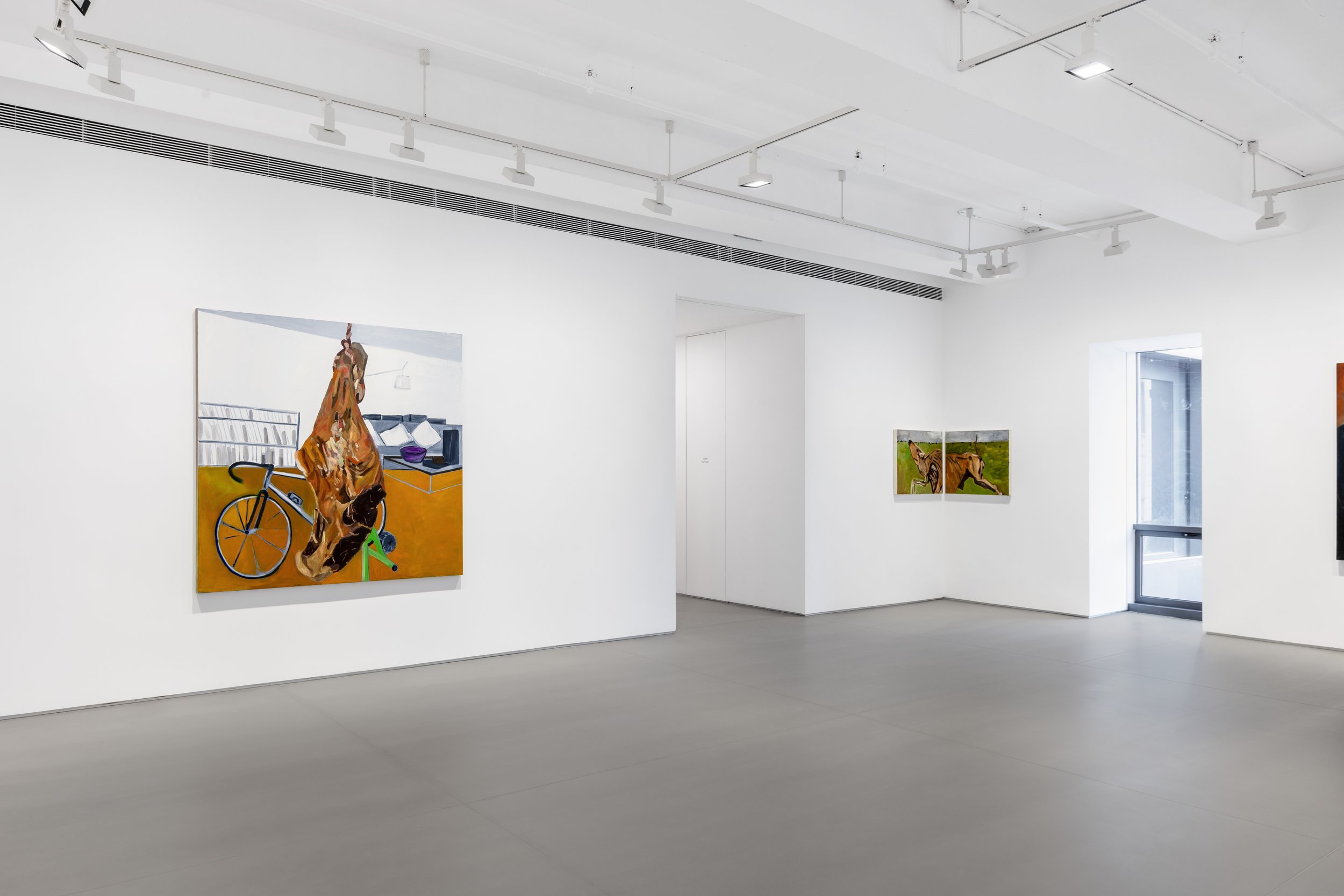
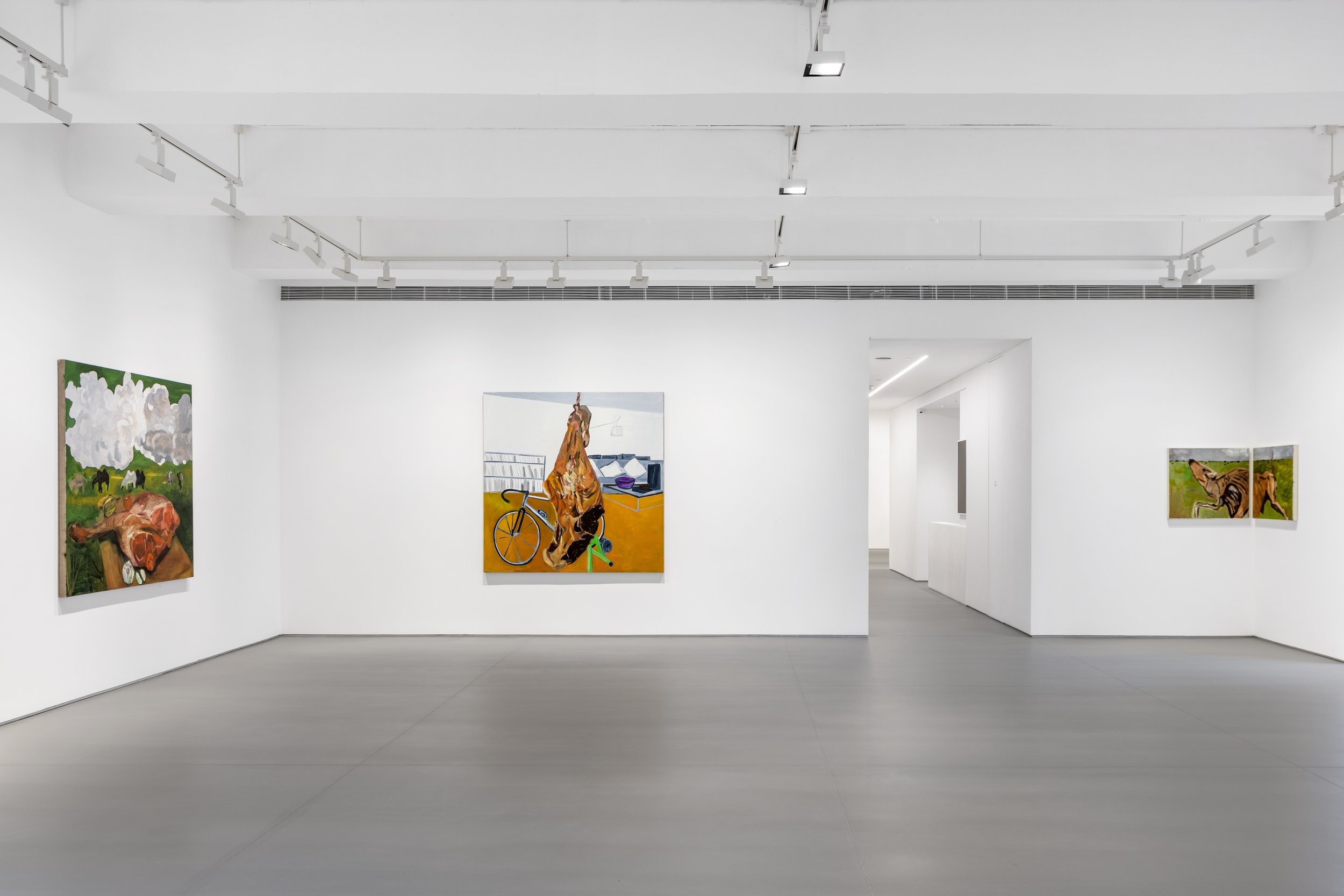
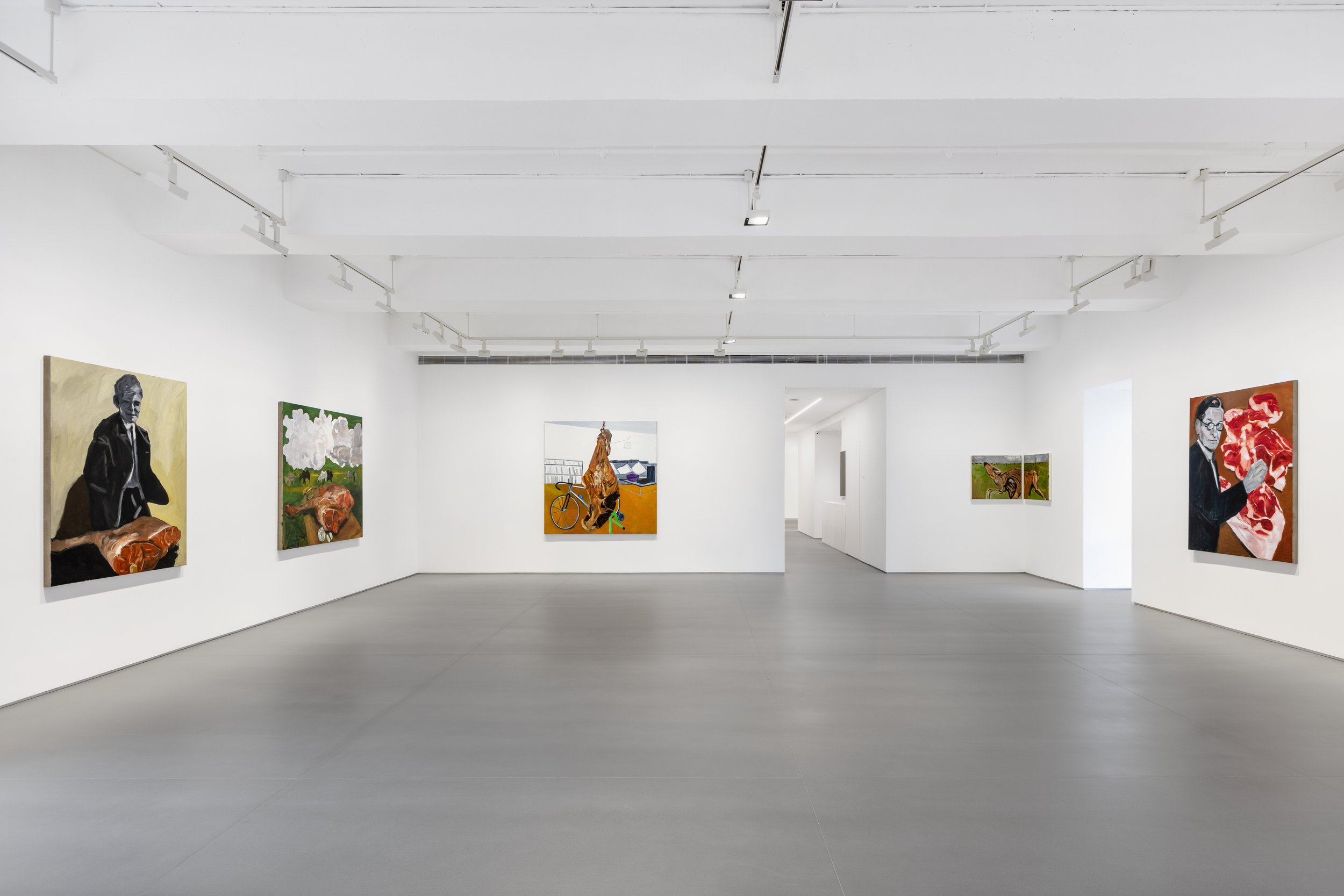
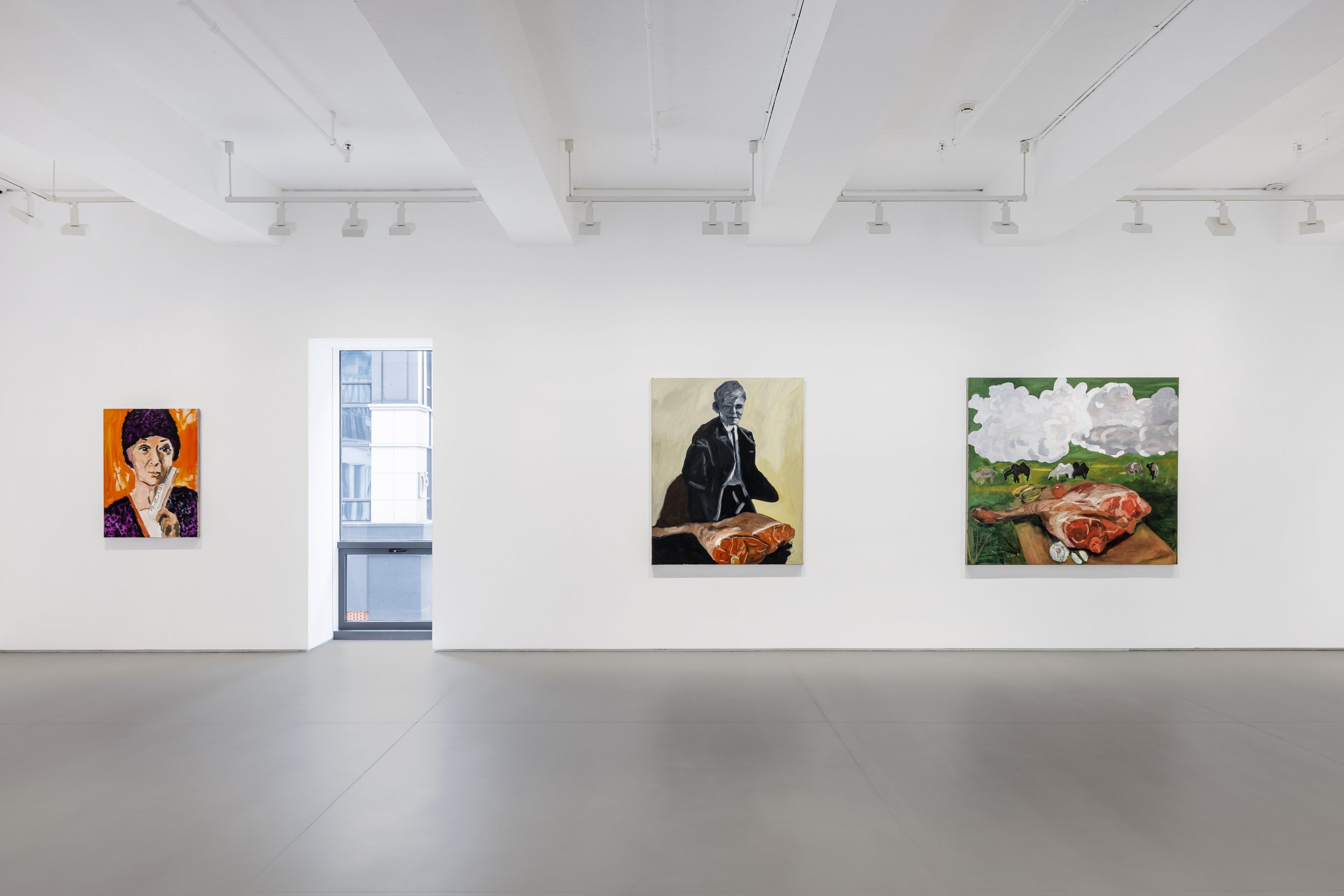
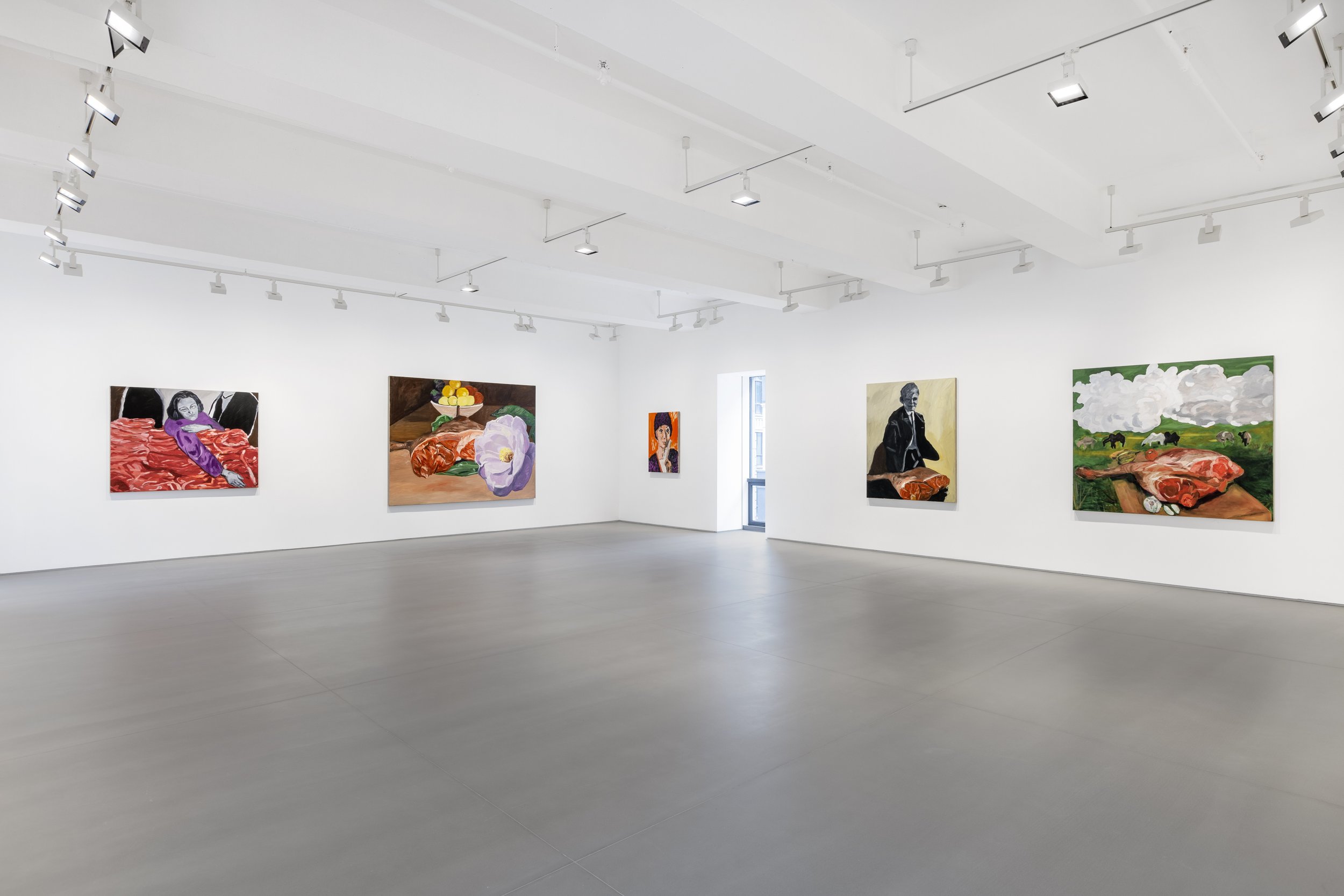
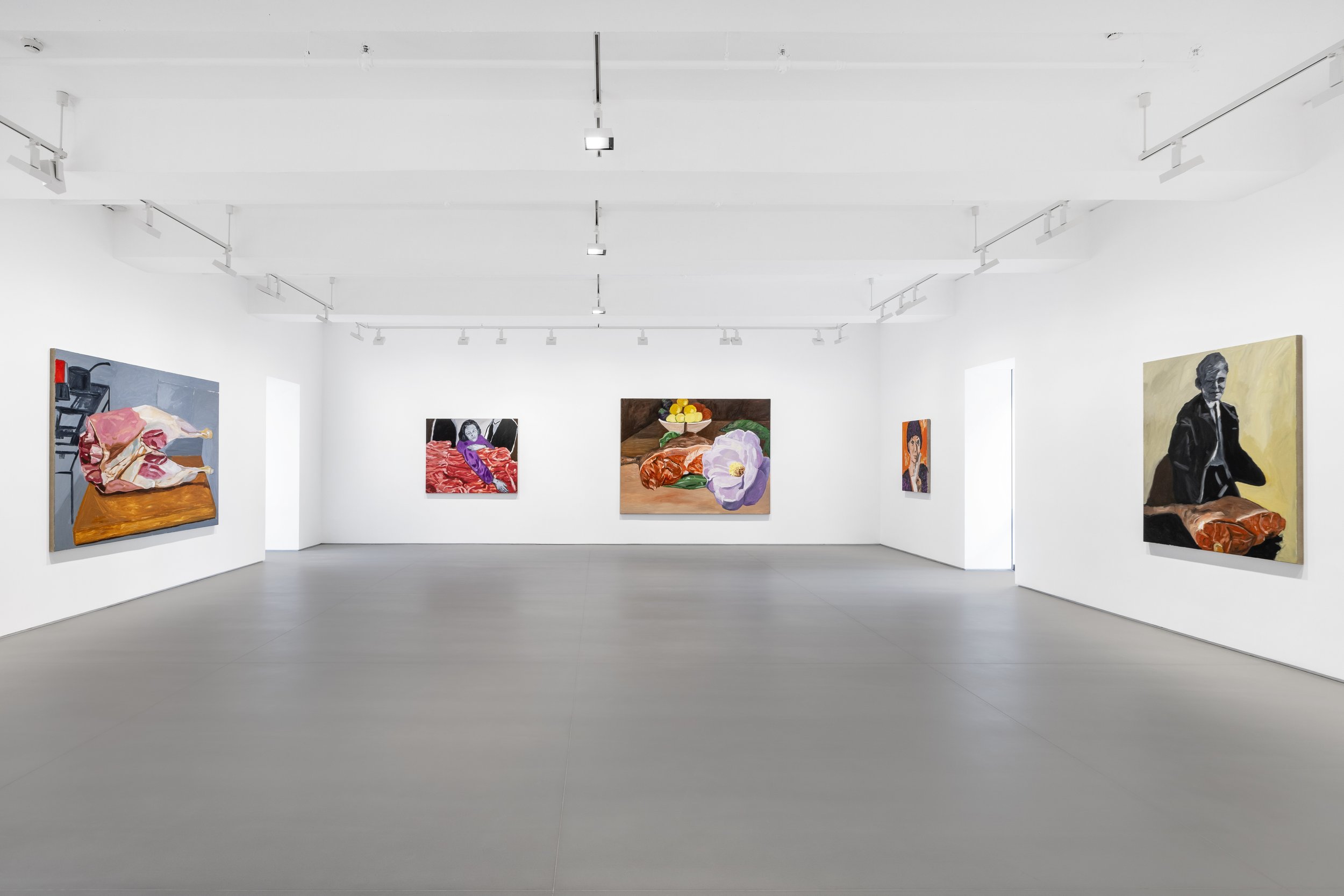

Installation view of Zhao Gang: Carnivore, Lisson Gallery, Beijing, 18 May – Autumn 2024 © Zhao Gang. Courtesy Lisson Gallery. Photography by Yang Hao 赵刚个展「肉食者」现场图,里森画廊,北京,2024年5月18日至2024年秋季 © 赵刚。图片由里森画廊提供,由杨灏拍摄
This series also portrays large animal carcasses exposed in the outdoors. The depicted grasslands and mutton are symbols of a nomadic lifestyle, echoing Zhao’s past experiences living in places scattered across the globe, intertwined with his pursuit of inner peace by traversing the prairies on motorcycle. Zhao Gang once said, "I believe the most important thing in life is, regardless of your status, you always have the ability to let go, and pick up where you left off at any given moment." With his intellectual preoccupation seeping through the canvas, Zhao reflects on what his diasporic identity means in the present, while elucidating the significance of those seemingly mundane yet deeply treasured aspects of his daily life.
About the artist
Zhao Gang delves into the fluidity of individual identities, the clash of cultures, and the intricate interplay of fragmented historical events. His works are deeply rooted in a rich and nuanced cultural heritage, drawing inspiration from both classical and contemporary, Western and Chinese influences. Within his work, patterns and concepts gracefully unfurl, expertly deconstructing visual narratives. At the age of 18, Zhao Gang became the youngest member to join the avant-garde artist group known as the ‘Star Group’, heralding the onset of the
modern art movement in China. Driven by a pursuit of artistic and political freedom, they laid the foundational stones of contemporary Chinese art. Zhao Gang’s artistic style is characterized by audacious and almost exaggerated narrative techniques and brushwork. These elements serve not only as a perpetual reaffirmation of his own existence but also as a defiant stance against the prevailing trend of artistic refinement. His works celebrate the unfettered freedom and authenticity inherent in painting. His experience of studying abroad and living overseas since 1983 has given his works a diverse style with distinctive international characteristics. Upon returning to Beijing in around 2006, Zhao Gang redirected his focus to the intricate interplay between his unique cross-cultural experiences and the annals of Chinese history. Born in this land, yet traversing the path of a new immigrant, he grapples with the sentiment of estrangement that threads through his art.
Born in Beijing in 1961, Zhao Gang currently works and lives in New York and Beijing. He attended the Maastricht Institute of Arts (formerly Stadsacademie voor Toegepaste Kunsten) in The Netherlands (1983), and Vassar College, New York (1984-1987). He obtained a Master of Arts degree from Bard College, New York in 1999. Zhao Gang has held solo exhibitions at various institutions, including the Long Museum (Chongqing Branch), Chongqing, China (2022); Long Museum (West Bund Branch), Shanghai, China (2021); Kuandu Museum of Fine Arts, Taipei (2020); Pérez Art Museum, Miami, FL, USA (2019); Museum of Contemporary Art, Santiago, Chile (2016); Ullens Center for Contemporary Art, Beijing, China (2015); Suzhou Museum, Suzhou, China (2015); Today Art Museum, Beijing, China (2011); Hong Kong Arts Centre, Hong Kong, China (2008); and He Xiangning Art Museum, Shenzhen, China (2006), among others. His works have also been featured in numerous group exhibitions, including the Solomon R. Guggenheim Museum, New York, NY, USA (2017); Beijing Minsheng Art Museum, Beijing, China (2015); OCAT Contemporary Art Terminal (Xi'an Branch), Xi'an, China (2014); Guangzhou Triennial, China (2008); Performa Biennial, New York, NY, USA (2007); and Yokohama Triennale, Japan (2005).
About Lisson Gallery
Lisson Gallery is one of the most influential and longest-running international contemporary art galleries in the world. Today the gallery supports and promotes the work of more than 60 international artists across spaces in London, New York, Los Angeles, Shanghai and Beijing. Established in 1967 by Nicholas Logsdail, Lisson Gallery pioneered the early careers of important Minimal and Conceptual artists, such as Art & Language, Carl Andre, Daniel Buren, Donald Judd, John Latham, Sol LeWitt, Richard Long and Robert Ryman among many others. It still works with many of these artists as well as others of that generation from Carmen Herrera to the renowned estate of Leon Polk Smith. In its second decade the gallery introduced significant British sculptors to the public for the first time, including Tony Cragg, Richard Deacon, Anish Kapoor, Shirazeh Houshiary and Julian Opie. Since 2000, the gallery has gone on to represent many more leading international artists such as Marina Abramović, Ai Weiwei, John Akomfrah, Susan Hiller, Tatsuo Miyajima and Sean Scully. It is also responsible for raising the international profile of a younger generation of artists led by Cory Arcangel, Ryan Gander, Van Hanos, Hugh Hayden, Haroon Mirza, Laure Prouvost, Pedro Reyes and Wael Shawky.
The exhibition opened on May 18 and will end in Autumn 2024, the opening was held from 3-6pm on May 18 2024, Lisson Gallery is located at 4/F, Building D7, Yard No.3, Jinhang East Road, Beijing.
For more information about this exhibition and others, please visit the Lisson Gallery here. The gallery can also be found on Facebook, YouTube, and Instagram.
Matisse: The Red Studio
© Succession H. Matisse 2024
In the Spring of 2024, Fondation Louis Vuitton is reaffirming its mission: promoting the art of our time to the widest possible audience. Committed to the presentation of ‘landmark works of modernity,’ the Fondation also undertakes to celebrate artists who, while having a connection with the history of modernity, have proposed new models and disrupted perceptions. At the same time, the Fondation supports contemporary creators who boldly set out to reinvent their times, while the Open Space program continues to support and disseminate emerging talent.
From May 4 to September 9, 2024, a landmark exhibition dedicated to The Red Studio (1911) by Henri Matisse (1869-1954) is being presented at the same time as a new retrospective of the work of Ellsworth Kelly (1923-2015) featuring paintings, sculptures, photographs and drawings.
In addition, in the context of the Olympic Games in Paris, the Fondation presents a selection of works from the Collection which relate to sports, offering an alternative and poetic vision of this international event.
The exhibition was organized by Ann Temkin - Marie-Josée and Henry Kravis Chief Curator of Painting and Sculpture at The Museum of Modern Art - and Dorthe Aagesen, Chief Curator and Senior Researcher at the SMK - National Gallery of Denmark, Copenhagen, with the collaboration of the Archives Henri Matisse.
Presentation in Paris
Head curator
Suzanne Pagé, Artistic Director of the Fondation Louis Vuitton
Associated curator
François Michaud, assisted by Magdalena Gemra
FONDATION LOUIS VUITTON
Bernard Arnault President of the Fondation Louis Vuitton
Jean-Paul Claverie Advisor to the President
Suzanne Pagé Artistic Director
Sophie Durrleman Executive Director
Fondation Louis Vuitton, in collaboration with The Museum of Modern Art (MoMA), New York and the SMK - National Gallery of Denmark, Copenhagen - is hosting the exhibition “Matisse: The Red Studio”, focusing on the genesis and history of this famous 1911 masterpiece, one of The Museum of Modern Art’s iconic works since its acquisition in 1949. The large canvas depicts the artist’s studio filled with his paintings and sculptures, furniture, and decorative objects. This exhibition reunites the artworks shown in The Red Studio for the first time since they left Matisse’s studio in Issy- les-Moulineaux. The presentation also includes archival material and related paintings and drawings.
© Succession H. Matisse 2024
“Now over 110 years old, The Red Studio is both a landmark within the centuries-long tradition of studio paintings and a foundational work of modern art”, says Ann Temkin, The Museum of Modern Art chief curator. “The picture remains a touchstone for any artist taking on the task of portraying their studio. Matisse’s radical decision to saturate the work’s surface with a layer of red has fascinated generations of scholars and artists, including Mark Rothko and Ellsworth Kelly. Yet much remains to be explored in terms of the painting’s origin and history.”
The core of the exhibition features The Red Studio alongside the surviving six paintings, three sculptures and one ceramic depicted in it. Created between 1898 and 1911, these objects range from familiar paintings, such as Young Sailor (II) (1906) - which will be exhibited in France for the first time in 31 years - to lesser-known works, such as Corsica, The Old Mill (1898), and objects whose locations have only recently been discovered.
Three of these paintings - Bathers (1907), Le Luxe (II) (1907-08), and Nude with a White Scarf (1909) - belong to SMK as part of a significant collection of Matisse’s works, while the artist’s 1907 ceramic plate, depicted in the foreground, comes from The Museum of Modern Art.
The exhibition also includes a number of paintings and drawings closely related to The Red Studio, such as The Museum of Modern Art The Blue Window (1913), and the MNAM/Centre Pompidou’s Large Red Interior (1948), which help us narrate the painting’s complex path from Matisse’s studio to its eventual acquisition by The Museum of Modern Art. A rich selection of archival materials such as letters and photographs - many published or exhibited for the first time in connection with this project - disclose new information on the painting’s subject, evolution, and reception. The exhibition also includes a video devoted to conservation science, which presents recent discoveries about the process of making the painting.
Matisse’s The Red Studio depicts the artist’s work environment in the town of Issy-les-Moulineaux. The Red Studio was painted as part of a sequence of works requested by Sergei Shchukin, Matisse’s most loyal and courageous early patron. Shchukin eagerly purchased the painting’s predecessor, The Pink Studio, but declined to acquire The Red Studio. The painting remained in Matisse’s possession for 16 years, during which time it traveled to the Second Post-Impressionist Exhibition in London in 1912 and to New York, Chicago, and Boston for the 1913 Armory Show.
The Red Studio was finally purchased in 1927 by David Tennant, the founder of the Gargoyle Club in London, a members-only club that catered to artists and aristocrats alike. The paining hung in the Gargoyle Club until the early 1940s; soon after, it was purchased by Georges Keller, director of the Bignou Gallery in New York. In 1949, The Red Studio was acquired for The Museum of Modern Art.
The work then got a second life. From 1949, New York artists and all those who happened to be passing through stopped in front of this painting, whose radical novelty was suddenly rediscovered. In the late 1940s, Matisse himself referred to what made the 1911 work unique: its “abstraction”, owing to the haunting prevalence of the color red, despite the precise depiction of the furniture, paintings and objects in Matisse’s Issy-les-Moulineaux studio at the time. Matisse would come up with a new series of paintings using the artist’s studio environment as their subject, particularly the 1948 Large Red Interior, which entered the collections of the Musée National d’Art Moderne in 1950 after being exhibited in New York by his son Pierre Matisse in February 1949. This work is present in the exhibition, evoking the importance of Matisse’s painting in the post-war years in Paris as well as in New York, and emphasizing the artist’s presence at the MNAM as well as at The Museum of Modern Art.
The dialogue between The Red Studio of 1911 and the Large Red Interior of 1948 will be highlighted especially in the Fondation’s exhibition, demonstrating how, within a span of nearly 40 years, Matisse reinterprets this pioneering painting at a time when his work is undergoing profound change. The two paintings go on to lead parallel lives, serving as inspiration to many American and European artists.
The exhibition was organized by Ann Temkin - the Marie-Josée and Henry Kravis Chief Curator of Painting and Sculpture at The Museum of Modern Art - and Dorthe Aagesen, Chief Curator and Senior Researcher at the SMKi- National Gallery of Denmark, Copenhagen, with the collaboration of the Archives Henri Matisse.
The exhibition “Matisse: The Red Studio” was presented from May 1 to September 10, 2022 at the The Museum of Modern Art in New York and from October 13, 2022 to February 26, 2023 at the SMK - National Gallery of Denmark in Copenhagen.
For more information about this exhibition and the Louis Vuitton Fondation please visit their site here or on Facebook, Instagram, YouTube, and TikTok.
Christopher Le Brun : Phases of the Moon
Christopher Le Brun 克里斯多夫·勒·布伦 Phases of the Moon II 月相II 2023 Oil on canvas 布面油画 Overall: 201 x 554 x 4 cm Overall: 79 1/8 x 218 1/8 x 1 5/8 in © Christopher Le Brun. Courtesy Lisson Gallery
British artist Christopher Le Brun returns to China for a solo exhibition at Lisson Beijing with a new series of paintings that highlight the musicality that is inherent in his artistic practice, weaving together a profound harmony of nature and melody. These ambitiously scaled works epitomise the artist’s classical technique of painting that nevertheless has its roots in spontaneity and intuition. Allowing each gesture to flow freely and drawing directly with tubes of paint without preliminary outline or under-painting, Le Brun evokes complex
spaces filled by his abundant pictorial imagination. This presentation follows Le Brun’s previous exhibitions at Lisson Shanghai in 2019, a solo exhibition at The Red Brick Art Museum and a dual presentation with Su Xinping at the Museum of Contemporary Art & Urban Planning, both in 2021.
Upon walking into the exhibition space, the spectator is greeted by a dense and extensive triptych entitled Lontano (2023), which shares its title with an orchestral composition by the twentieth-century avant-garde composer, György Ligeti. Mirroring its musical counterpart, Lontano – which is Italian for “far away” or “in the distance” – unfolds its rich interplay of staccato and legato passages (musical terms for disjunctive and flowing) that build and eventually merge into a harmonious whole. The relative quiet and emptiness communicated by light neutral tones are contrasted with episodes of frenetic texture and dark-hued intensity, creating a sense of narrative that is rare in the abstract realm.
Christopher Le Brun 克里斯多夫·勒·布伦 Tidings 潮汐 2023 Oil on canvas 布面油画 130 x 140 x 4 cm 51 1/8 x 55 1/8 x 1 5/8 in © Christopher Le Brun. Courtesy Lisson Gallery
Across the room from this monumental triptych is Le Brun’s latest searching venture into multi-panelled composition. Echoing the artist’s figurative beginnings, Phases of the Moon II (2023) finds inspiration from lunar references throughout art history. Episodes of sunlight and moonlight follow each other, embodied through alternating passages of warm and cool light. Emerging as if from the intervals between consciousness and sleep, Phases of the Moon II speaks in the symbolic language of memory and imagination.
Also presented in this multi-sensory dialogue is the captivating oil on canvas diptych, January Just (2024). Much like Lontano, this large panoramic work resembles an extended musical composition, challenging the viewer to engage with it over time. Through the build up of structure and material, January Just evokes a sense of imminence reminiscent of modern classical music. Painted incidents that emerge within the textured surface are like clues that invite the spectator to trace how its unique appearance came into being.
Christopher Le Brun 克里斯多夫·勒·布伦 January Just一月则刚 2024 Oil on canvas 布面油画 Overall: 160.5 x 401 x 4 cm Overall: 63 1/4 x 157 7/8 x 1 5/8 in © Christopher Le Brun. Courtesy Lisson Gallery
The exhibition also features two single paintings, Promenade (2023) and Tidings (2023). Employing similar motifs as a unifying thread, these works invite the spectator to travel further into the metaphorical landscape that Le Brun has created. In Promenade, the canvas becomes a vast expanse of potentiality akin to the sea, where each colour appears to break the surface or be submerged beneath it, waiting to see and to be seen. While Tidings draws inspiration from the artist's intimate connection to the landscape of the Somerset levels, it is not a literal depiction of a specific scene. Instead, by means of its subtle layers, the painting re-enacts the atmospheric nuances that brings these English grasslands to life.
The exhibition ‘Phases of the Moon’ invites viewers to a visual encounter that transcends the boundaries of traditional pictorial expression. Le Brun’s evocative paintings open up a profound experience of abstraction and sensory perception through his mastery of touch and colour.
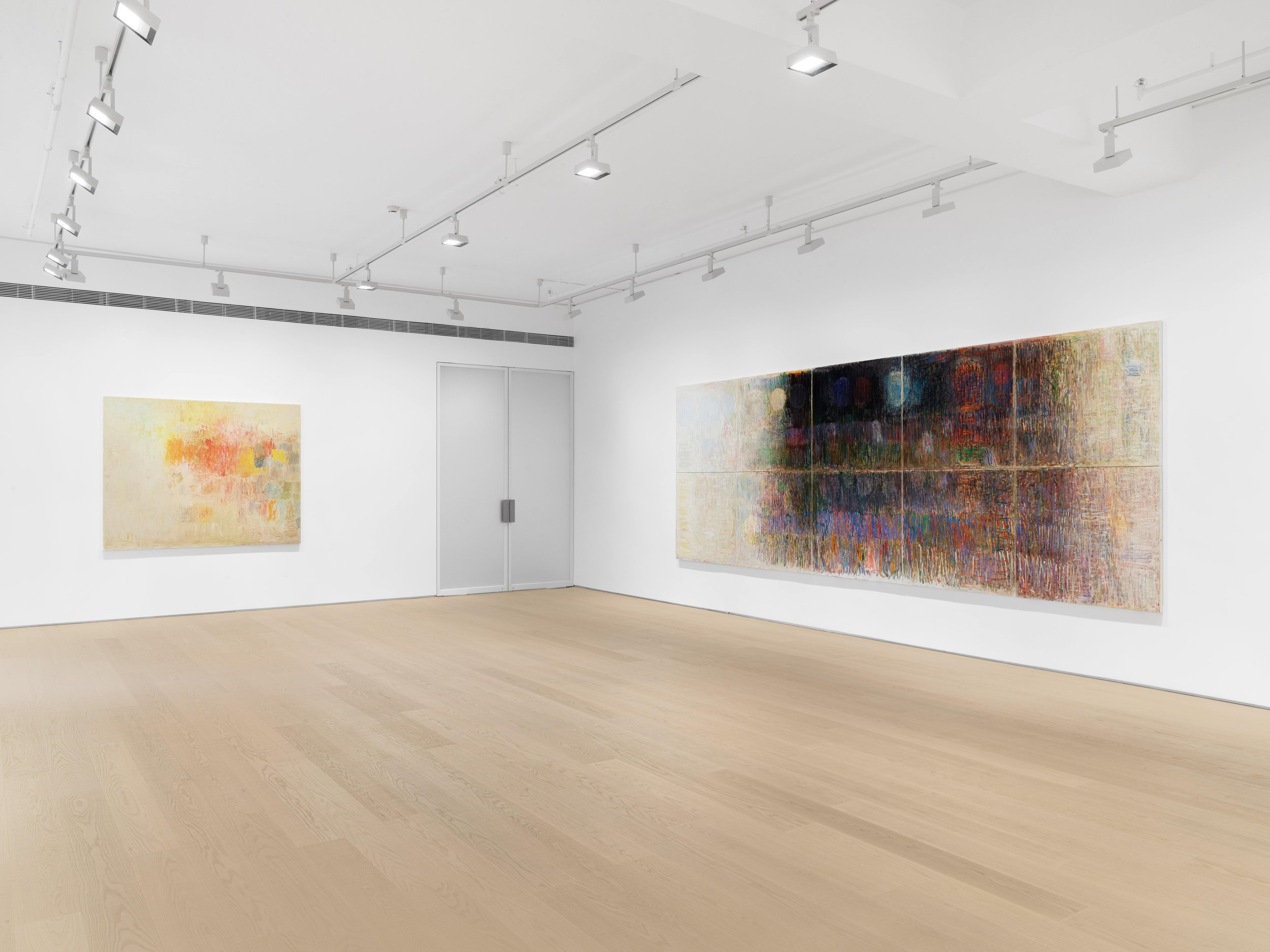

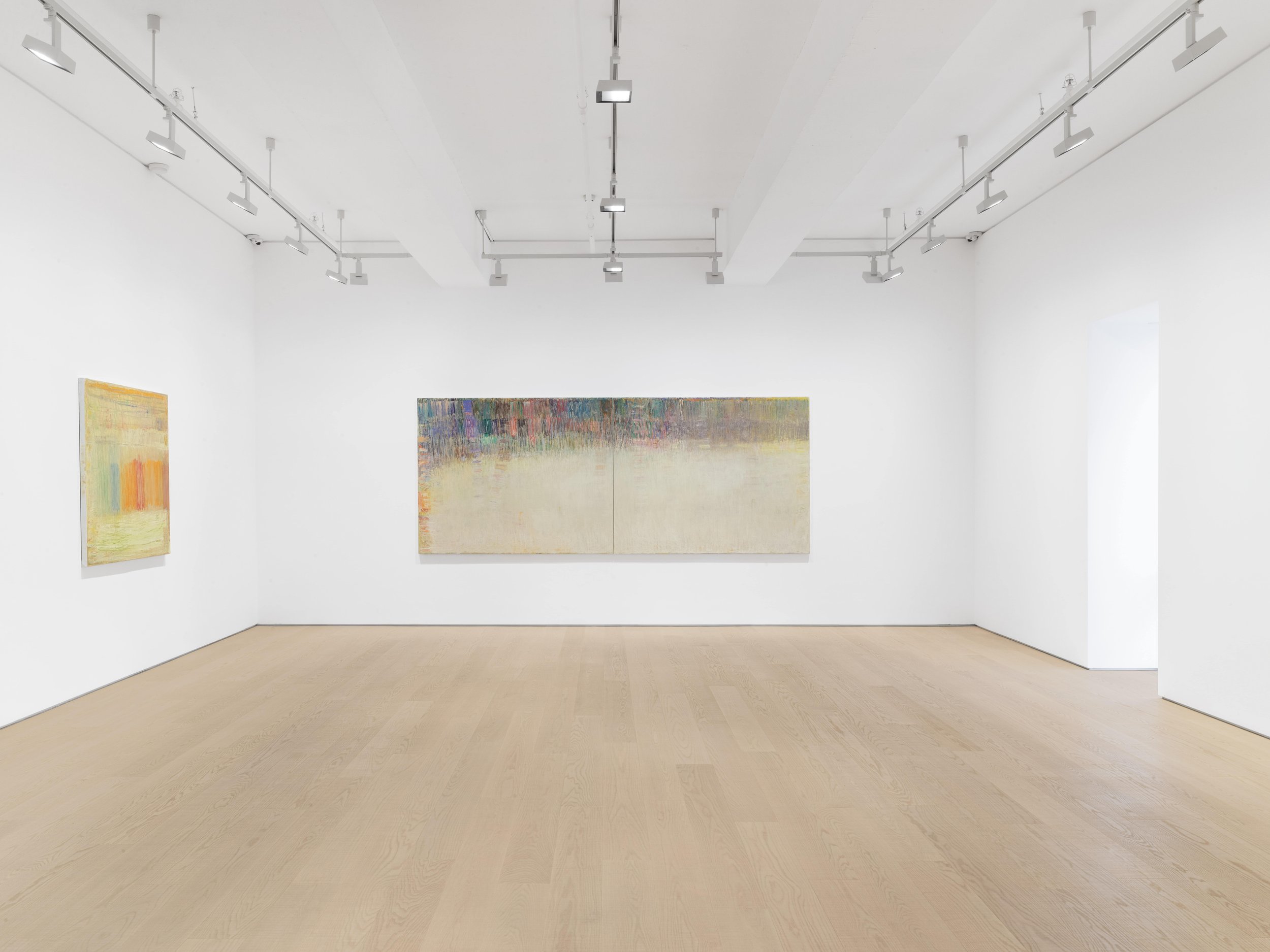

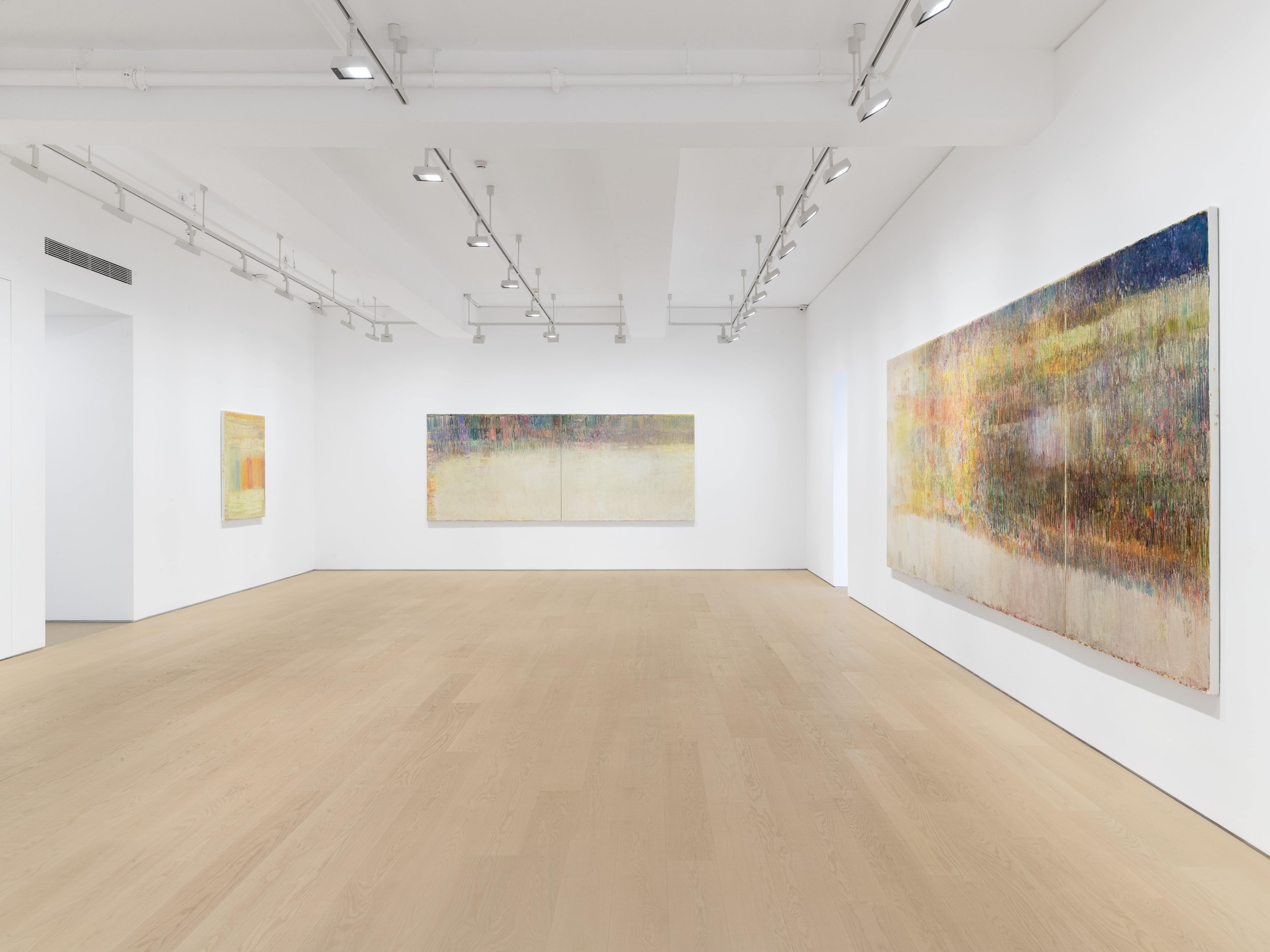
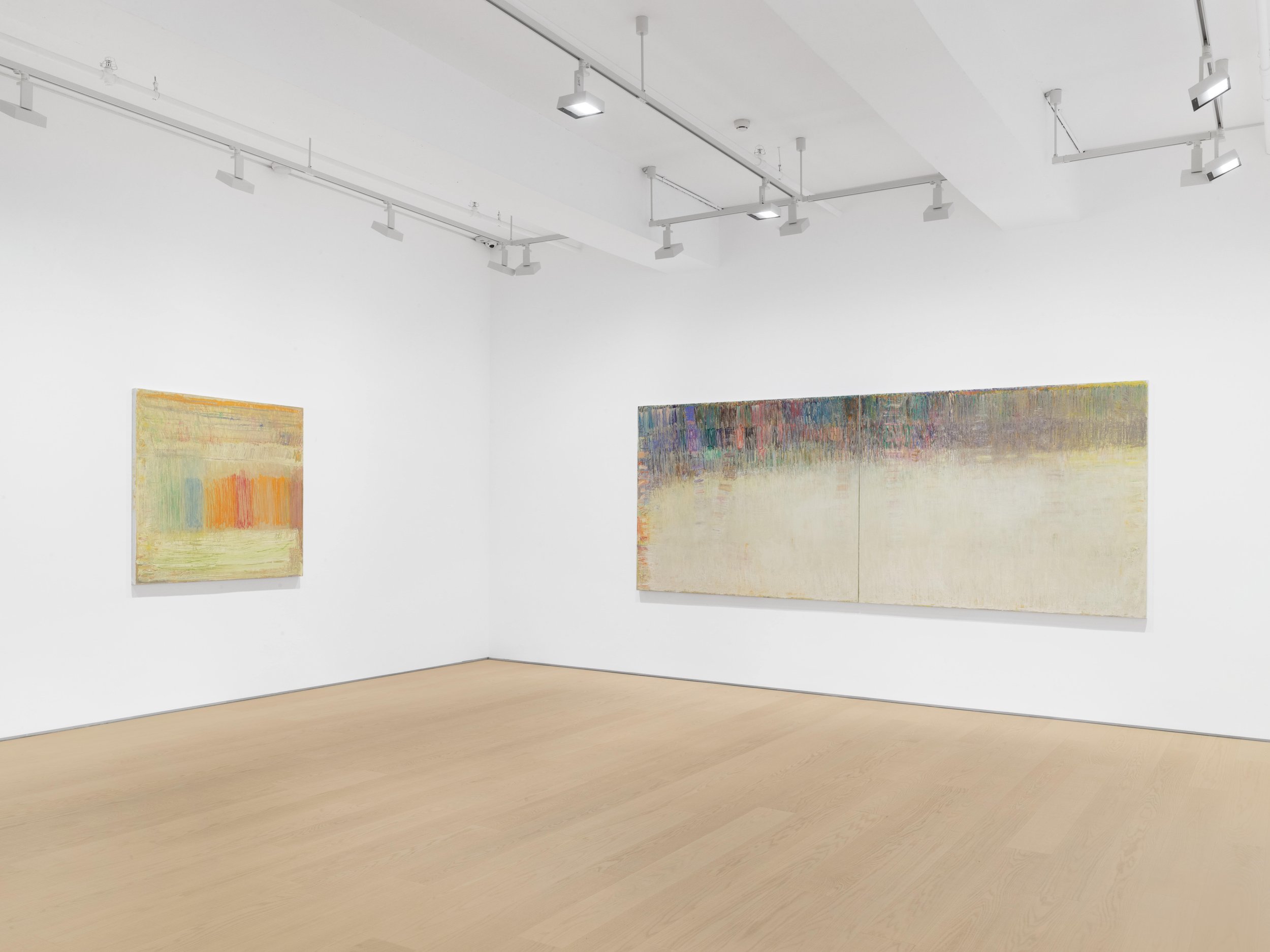
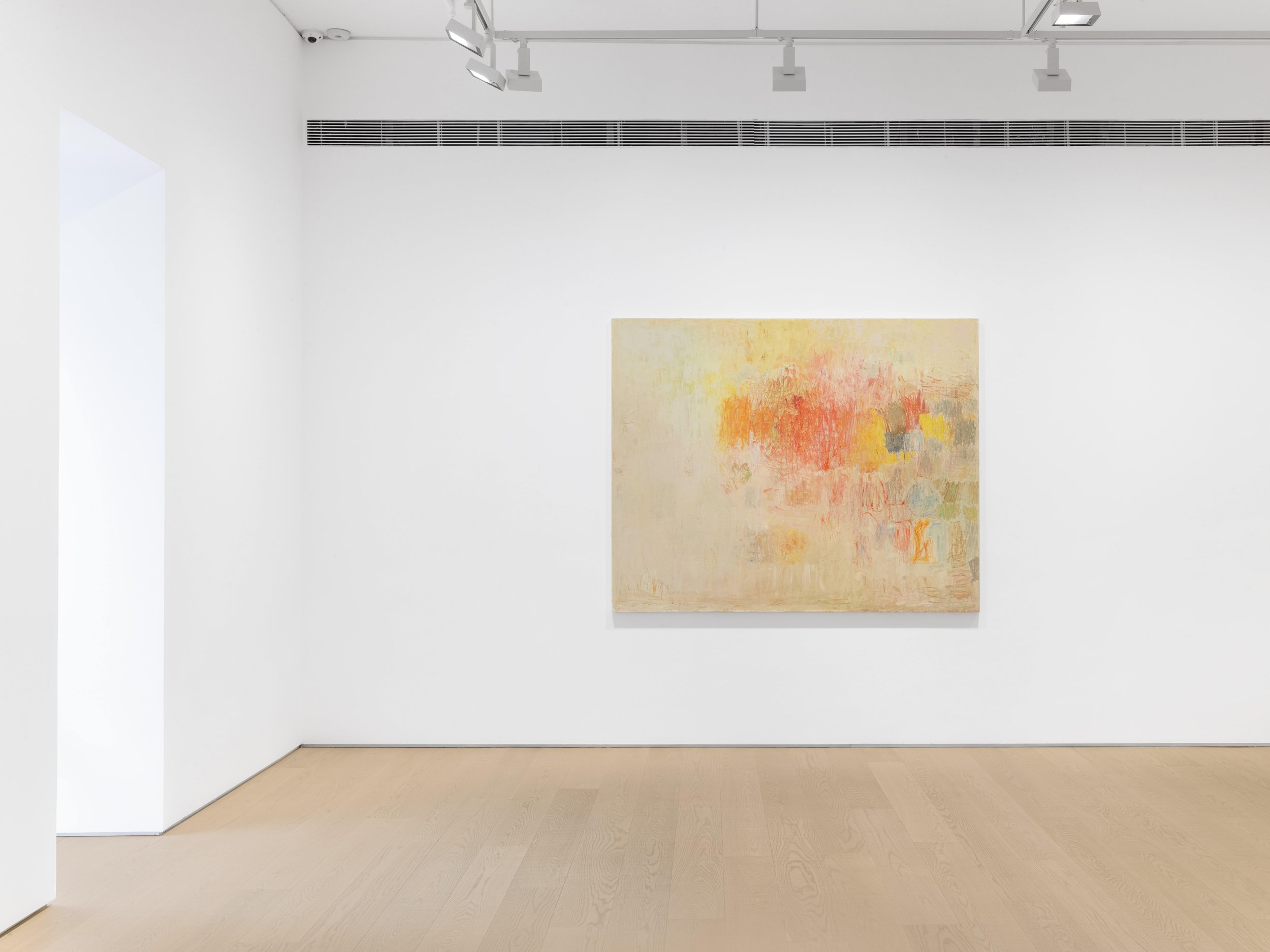

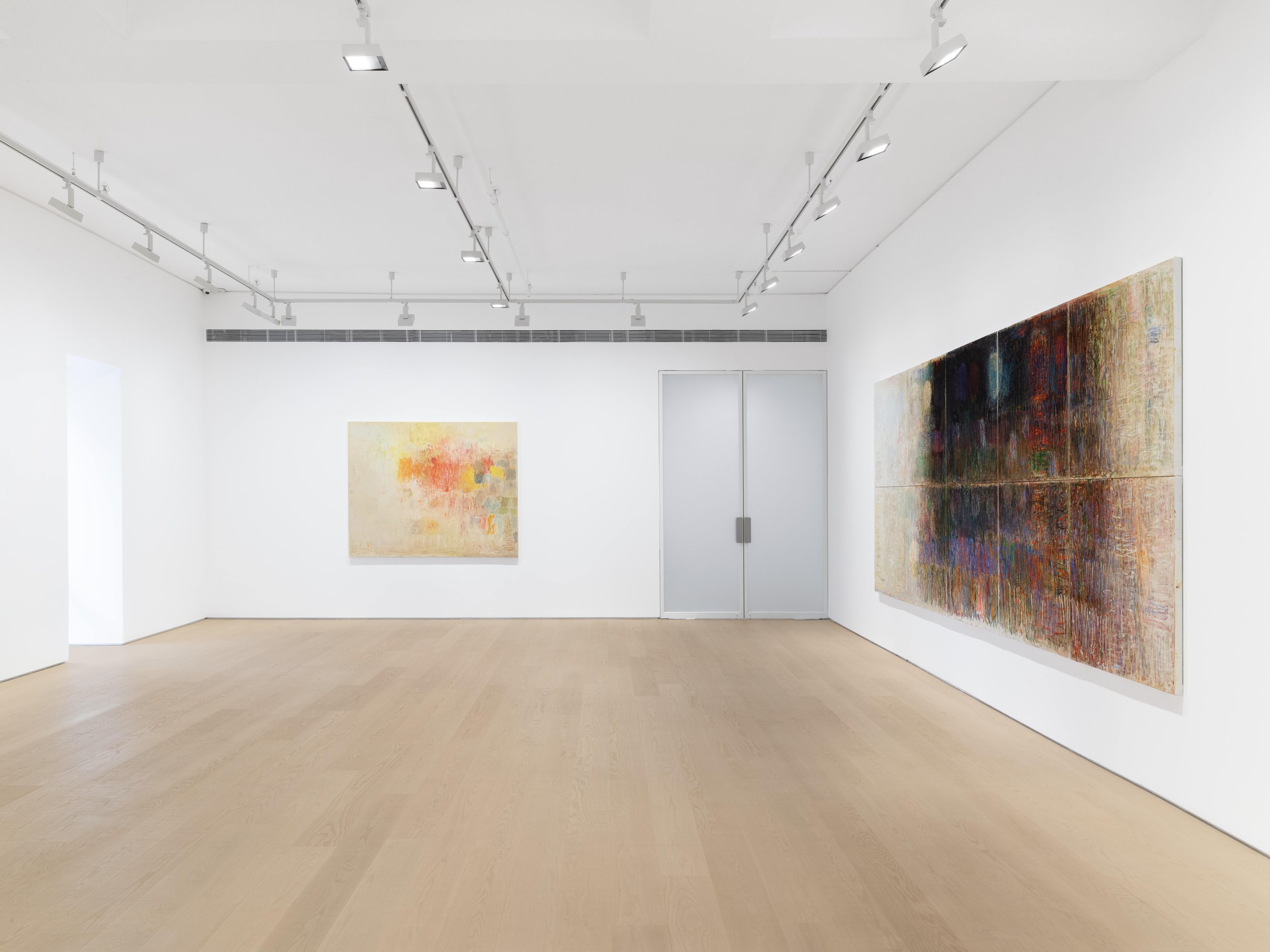
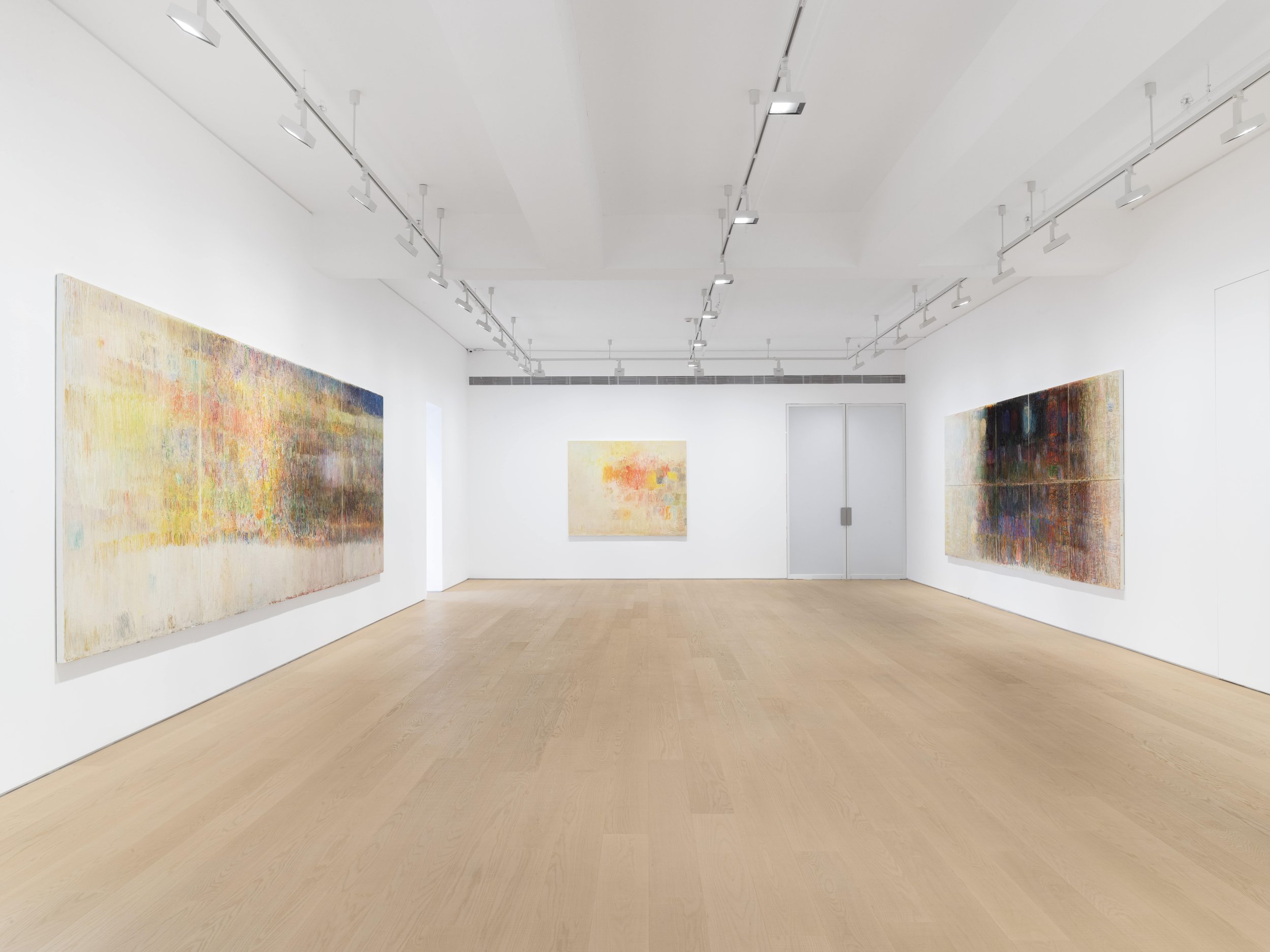
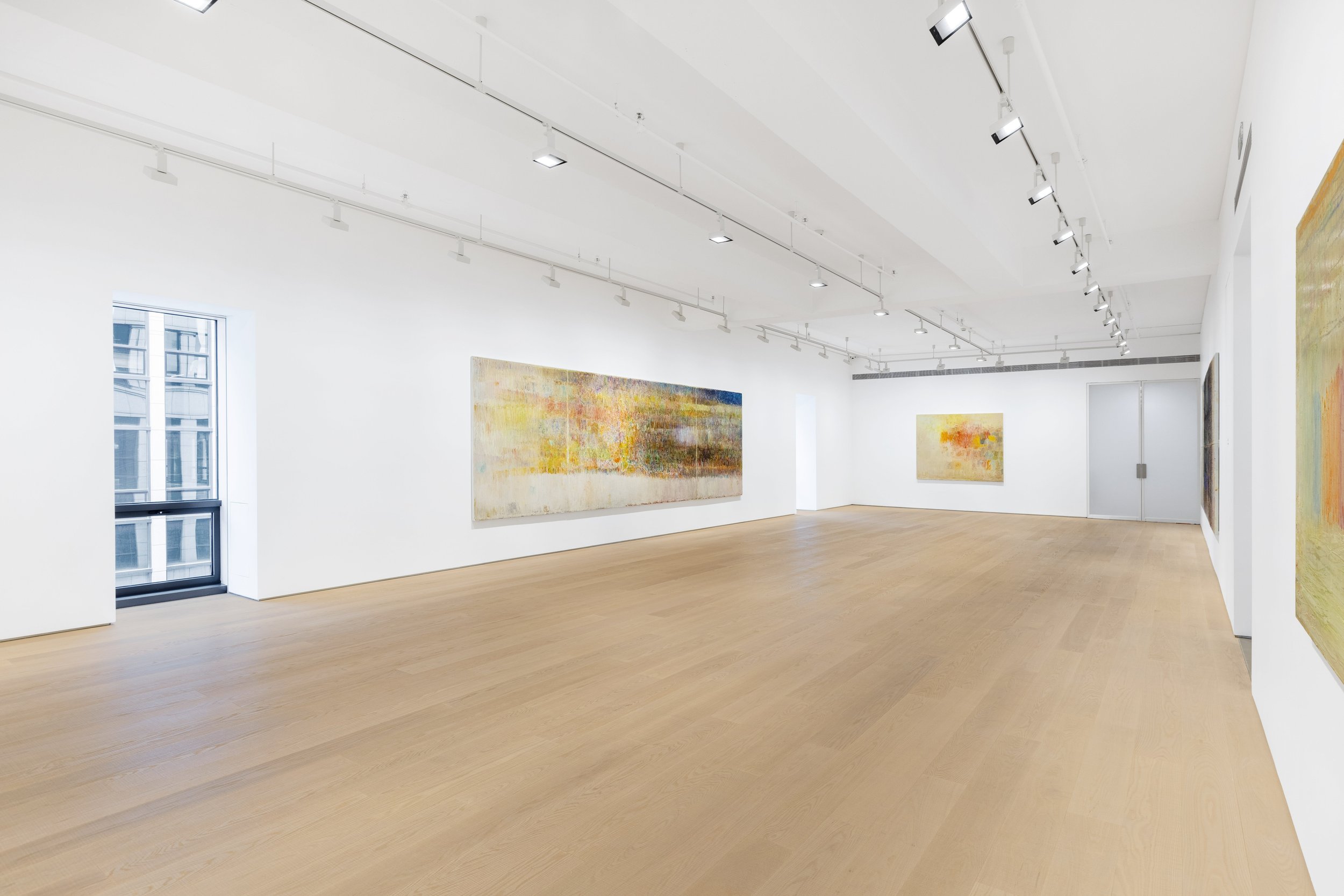
Installation view of Christopher Le Brun: Phases of the Moon, Lisson Gallery, Beijing, 18 May – Autumn 2024 © Christopher Le Brun. Courtesy Lisson Gallery. Photography by Yang Hao 克里斯多夫·勒·布伦个展「月相」现场图,里森画廊,北京,2024年5月18日至2024年秋季 © 克里斯多夫·勒·布伦。图片由里森画廊提供,由杨灏拍摄
About the artist
Sir Christopher Le Brun is one of the leading British painters of his generation, celebrated internationally since the 1980s, making both figurative and abstract work in painting, sculpture and print. He was an instrumental public figure in his role as President of the Royal Academy of Arts in London from 2011 to 2019. He was awarded a Knighthood for services to the Arts in the 2021 New Year Honours. At the beginning of 2023, a further two of his major pieces were added to institutional collections of Tate Gallery in London and the Museum of Contemporary Art & Urban Planning (MoCAUP) in Shenzhen.
Le Brun employs a mastery of touch and colour alongside a profound understanding of art history and a wide range of visual, musical and literary sources. He has remained consistent in adhering to what he feels to be the essential poetry and pleasure of painting for its own sake, led by intuition and visual imagination and resistant to external justification.
His interest in the formal possibilities of painting has led recently to the development of modular compositions from single pieces through to large and highly complex canvases, triptychs and monumental multipart paintings, extending the limits of abstract pictorial composition. A heightened awareness of the physicality of the painting process with its dramatic tension between revealing and covering, has been a central feature of his work that unites all its phases whether abstract or figurative.
Born in Portsmouth in 1951, Christopher Le Brun trained at the Slade and Chelsea Schools of Art, London. In his early career, he was a double prizewinner at the John Moores exhibitions (1978, 1980), also showing in the Venice Biennale (1980) and the ground-breaking exhibition ‘Zeitgeist’ (1982) at the Martin-Gropius Bau, Berlin. His recent solo exhibitions have been held at Albertz Benda, New York, USA (2023); Lisson Gallery, London, UK (2022); Albertz Benda, Los Angeles, USA (2022); Red Brick Art Museum, Beijing, China (2021); Albertz Benda, New York, USA (2020); Lisson Gallery, Shanghai, China (2019); Lisson Gallery, London, UK (2018); the
Southampton Art Gallery, Southampton, UK (2018); Wolfson College, Cambridge, UK (2018); Albertz Benda, New York, NY, USA (2017); The Gallery at Windsor, Vero Beach, FL, USA (2017); Colnaghi, London, UK (2015); Friedman Benda, New York, NY, USA (2014); New Art Centre, Wiltshire, UK (2010) and The New Art Gallery, Walsall, UK (2008). Le Brun served as a trustee of Tate from 1990–1995; The National Gallery from 1996–2003; the Dulwich Picture Gallery from 2000–2005; and as a founding trustee of the Royal Drawing School from 2003–2016. He was a trustee of the National Portrait Gallery between 2012-19. He was elected the first Professor of Drawing of the Royal Academy, London in 2000, where he also served as President from 2011-2021, the 26th since Sir Joshua Reynolds and the youngest since Lord Leighton in 1878.
His work is in many museum collections including Tate Gallery, London, UK; Museum of Modern Art, New York, USA; Museum of Contemporary Art & Urban Planning (MoCAUP), Shenzhen, China, the British Museum, London, UK; Art Gallery of New South Wales, Sydney, Australia; Metropolitan Museum of Art, New York, USA; Victoria & Albert Museum, London, UK; Scottish National Gallery of Modern Art, Edinburgh, Scotland; The Whitworth, Manchester, UK; Red Brick Art Museum, Beijing, China, Yale Center for British Art, New Haven, USA, and Museum of Fine Arts, Houston, USA. Le Brun’s public sculptures include Union (horse with two discs) at the Museum of London; City Wing on the site of the London Stock Exchange at Threadneedle Street; and The Monument to Victor Hugo on the quayside in St Helier, Jersey.
About Lisson Gallery
Lisson Gallery is one of the most influential and longest-running international contemporary art galleries in the world. Today the gallery supports and promotes the work of more than 60 international artists across spaces in London, New York, Los Angeles, Shanghai and Beijing. Established in 1967 by Nicholas Logsdail, Lisson Gallery pioneered the early careers of important Minimal and Conceptual artists, such as Art & Language, Carl Andre, Daniel Buren, Donald Judd, John Latham, Sol LeWitt, Richard Long and Robert Ryman among many others. It still works with many of these artists as well as others of that generation from Carmen Herrera to the renowned estate of Leon Polk Smith. In its second decade the gallery introduced significant British sculptors to the public for the first time, including Tony Cragg, Richard Deacon, Anish Kapoor, Shirazeh Houshiary and Julian Opie. Since 2000, the gallery has gone on to represent many more leading international artists such as Marina Abramović, Ai Weiwei, John Akomfrah, Susan Hiller, Tatsuo Miyajima and Sean Scully. It is also responsible for raising the international profile of a younger generation of artists led by Cory Arcangel, Ryan Gander, Van Hanos, Hugh Hayden, Haroon Mirza, Laure Prouvost, Pedro Reyes and Wael Shawky.
The exhibition opened on May 18 and will end in Autumn 2024, the opening was held from 3-6pm on May 18 2024, Lisson Gallery is located at 4/F, Building D7, Yard No.3, Jinhang East Road, Beijing.
For more information about this exhibition and others, please visit the Lisson Gallery here. The gallery can also be found on Facebook, YouTube, and Instagram.
THE COLLECTION: A Sports Meeting
Jean-Michel Basquiat & Andy Warhol Olympic Rings, 1985 Acrylic and silkscreen ink on canvas 208 x 466 cm Collection Éditions Enrico Navarra © Estate of Jean-Michel Basquiat. Licensed by Artestar, New York © 2024 - The Andy Warhol Foundation for the Visual Arts, Inc. / Licensed by ADAGP, Paris Photo: © Fondation Louis Vuitton / David Bordes
In recognition of the Olympic flame’s passage through the Fondation, the Louis Vuitton building opened on May 4th and will be on view until the 9th of September 2024.
Select works from our Collection will be displayed on the second level, with creations from five international artists united in Galleries 9 through 11. The depth and breadth of these œuvres provide an uncommon, poetic perspective on the theme of sports.
Abraham Poincheval Walk on Cloud, 2019 [Marche sur les nuages] Digital video, color, sound, 14 min 05 s Fondation Louis Vuitton, Paris © Andreas Gursky / Courtesy Sprüth Magers / ADAGP, 2024
In Gallery 9 is the spectacular installation Walk on Clouds, 2019, by Abraham Poincheval (b. 1972) showing the artist strolling across a cloud canopy. Seeming to hang in thin air, he is actually supported by a hot-air balloon fitted with drones, making it possible for him to be filmed. The video is the product of this performance, one that demanded the artist’s total commitment of mind and body - and such risk-taking that this “walk” appears to be as much an athletic feat as a dream.
Andreas Gursky Engadin, 1995 Chromogenic Print 186 x 291 cm Fondation Louis Vuitton, Paris ©ADAGP, Paris 2024
In the photo Engadin, 1995 by Andreas Gursky (b. 1955), grandiose Swiss peaks are surrounded by an intensely blue sky, creating a sublime, panoramic vision. Humankind - represented by a slender strand of cross-country skiers rendered miniscule by contrast - all but disappears before the power of nature and only seems to exist in man’s determination to challenge the elements.
Gallery 11 holds the installation by Roman Signer (b. 1938), Installation mit Kajaks (“Installation with Kayak”) from 2003, featuring a kayak, an important element of the artist’s visual vocabulary since the late 1980s. This vessel, usually symbolic of movement and speed, is deprived of all utility by being suspended from the ceiling, but thereby also acquires the status of sculpture, showcasing its streamlined beauty.
Omar Victor Diop Diaspora, 2014-2015 Inkjet prints 60 x 40 / 60 x 60 cm chaque (x18) [Albert Badin, 2014 ; Kwasi Boakye, 2014 ; Dom Nicolau, 2014 ; Olaudah Equiano, 2014 ; Juan de Pareja, 2014 ; Jean-Baptiste Belley, 2014 ; Ayuba Suleiman Diallo, 2014 ; Angelo Soliman, 2014 ; August Sabac El Cher, 2014 ; St Bénédicte de Palerme, 2014 ; Don Miguel De Castro, 2014 ; El Moro, 2014 ; Pedro Camejo, 2015 ; Omar Ibn Saïd, 2015 ; Malick Ambar, 2015 ; Ikhlas Khan, 2015 ; Henrique Dias, 2015 ; Frédérick Douglass, 2015], 2014-2015 Fondation Louis Vuitton, Paris © Omar Victor Diop
The work of Omar Victor Diop (b. 1980), Diaspora, resembles a portrait gallery of African figures from the 16th to the 19th centuries, all of whom played an important role outside their home continent. It is, in fact, the artist - costumed and staged - who embodies them all in a sweeping history of the genre, from Mughal miniatures to European court portraits. A red card, a ball, goalie gloves, a whistle: a number of unexpected accessories, symbolic items from the sports world, disrupt the seemingly traditional portrayal of these figures.
Jean-Michel Basquiat Napoleonic Stereotype Circa 44, 1983 Acrylic, oil, and pencil on canvas 167.6 x 152.4 cm Fondation Louis Vuitton, Paris © Estate of Jean-Michel Basquiat Licensed by Artestar, New York Photo: © Fondation Louis Vuitton / Marc Domage
Jean-Michel Basquiat’s desire to bring the “invisible man” into existence and his fascination with heroes are recurrent themes in his works. Boxers like Sugar Ray Robinson and Mohammad Ali feature in this artistic pantheon. Napoleonic Stereotype Circa 44 (1983) is a nod to another boxer, Joe Louis, whose hitherto victorious career was tarnished by a highly symbolic defeat in 1936 against Max Schmeling, who fought on behalf of Nazi Germany.
The official emblem of the Olympic Games - five circles representing the five continents - served as a motif for Warhol, who collaborated with Jean-Michel Basquiat (1960-1988) to produce several works on this theme. In 1985’s Olympic Rings, the geometric acronym of the rings is painted by Andy Warhol (1928-1987) in his consummate style, while Basquiat’s striking contribution is a black, mask-like face in the composition’s centre. This work, on loan from the Éditions Enrico Navarra collection, was a highlight of the 2023 Basquiat x Warhol. Painting Four Hands exhibition at the Fondation Louis Vuitton, and the loan has been generously extended to celebrate the Olympic and Paralympic Games in Paris 2024.
This project has been labeled by Paris 2024 as part of the Olympiade Culturelle.
For more information about this exhibition and the Louis Vuitton Fondation please visit their site here or on Facebook, Instagram, YouTube, and TikTok.
Lu Yang — Open Space #14
Lu Yang, DOKU The Flow (2023) film still, courtesy the artist and Société, Berlin
Lu Yang is a multimedia artist who graduated from the China Academy of Art’s New Media Art Department in Hangzhou. The artist was born in China in 1984 and lives and works in Shanghai and Tokyo. Lu Yang has a multidisciplinary practice and particularly favours the use of advanced digital technologies, and wide-ranging collaborations, including designers, composers, psychologists, dancers, engineers and scientists, through which he creates virtual worlds that unfold in immersive video installations. His fantastic imaginary realm, one with postapocalyptic overtones, is born of a syncretism in which Japanese popular culture - video games, manga, anime, pop music - dovetails with Buddhist spirituality, transhumanist theories and neuroscientific research. From this concoction, the artist brings to life hybrid creatures that transcend identity concepts of gender, sex and nationality to better understand what it means to be human in the 21st century.











Lu Yang, DOKU The Flow (2023) film still, courtesy the artist and Société, Berlin
For Open Space #14, his first solo exhibition in a French institution, Lu Yang conceives a unique video installation centered around his new film DOKU The Flow, the second chapter of the “DOKU” series. Derived from the Japanese word DOKUSHO DOKUSHI, meaning “We are born alone, and we die alone”, DOKU is a virtual character created from the digitization of the artist’s own body. The film depicts the solitary adventures of this multi-faced avatar through which Lu Yang transcends the boundaries of the physical body, exploring a new form of freedom through digital reincarnation. DOKU The Flow was produced with the support of the Fondation Louis Vuitton.
Lu Yang, DOKU The Flow (2023) film still, courtesy the artist and Société, Berlin
Curators: Claudia Buizza and Ludovic Delalande (Fondation Louis Vuitton)
As a partner venue of the Fondation Louis Vuitton (Paris), K11 will host DOKU The Flow by Lu Yang in K11 Shenzhen next spring 2025.
Lu Yang, DOKU The Flow (2023) film still, courtesy the artist and Société, Berlin
Lu Yang (1984, China)
Lives and works in Shanghai (China) and Tokyo (Japan) Recent solo exhibitions: Mudec, Milano; Kunsthalle Basel, Basel; Palais Populaire, Berlin; ARoS Museum, Aarhus; M Woods, Beijing; MOCA Cleveland; Ullens Center for Contemporary Art, Beijing; Zabludowicz Collection, London; Mori Art Museum, Tokyo and Kunstpalais Erlangen. Recent group exhibitions: Centre Pompidou-Metz; Muzeion, Bolzano; La Biennale di Venezia; Rockbund Art Museum, Shanghai; CCA, Tel Aviv; ICA, London; Muzeum Sztuki, Poland; Centre Pompidou, Paris; Hamburger Bahnhof, Berlin; Fridericianum, Kassel. Lu Yang is represented by Société, Berlin.
For more information about this exhibition and the Louis Vuitton Fondation please visit their site here or on Facebook, Instagram, YouTube, and TikTok. for more information about Lu Yang’s work, please visit Lu Yang’s website here and follow them on Instagram.
ELLSWORTH KELLY: SHAPES AND COLORS, 1949-2015
Ellsworth Kelly, Spectrum VIII, 2014 Acrylic on canvas, 12 joined panels 635 × 584,2 cm Fondation Louis Vuitton, Paris © Ellsworth Kelly Foundation Photo: © Fondation Louis Vuitton / Marc Domage
In the Spring of 2024, Fondation Louis Vuitton is reaffirming its mission: promoting the art of our time to the widest possible audience. Committed to the presentation of ‘landmark works of modernity,’ the Fondation also undertakes to celebrate artists who, while having a connection with the history of modernity, have proposed new models and disrupted perceptions. At the same time, the Fondation supports contemporary creators who boldly set out to reinvent their times, while the Open Space program continues to support and disseminate emerging talent.
From May 4 to September 9, 2024, a landmark exhibition dedicated to The Red Studio (1911) by Henri Matisse (1869-1954) is being presented at the same time as a new retrospective of the work of Ellsworth Kelly (1923-2015) featuring paintings, sculptures, photographs and drawings.
In addition, in the context of the Olympic Games in Paris, the Fondation presents a selection of works from the Collection which relate to sports, offering an alternative and poetic vision of this international event.
This exhibition is organized with Glenstone Museum, Potomac, Maryland, United States in collaboration with the Ellsworth Kelly Studio in the context of “Ellsworth Kelly at 100”.
Head curator
Suzanne Pagé, Artistic Director of the Fondation Louis Vuitton
Curators
Emily Wei Rales, Nora Severson Cafritz, Yuri Stone
Curator for the presentation in Paris
Olivier Michelon, assisted by Clotilde Monroe
FONDATION LOUIS VUITTON
Bernard Arnault President of the Fondation Louis Vuitton
Jean-Paul Claverie Advisor to the President
Suzanne Pagé Artistic Director
Sophie Durrleman Executive Director
Ellsworth Kelly, Upper Manhattan Bay, 1957 Collage on postcards 8.6 x 13 cm Private Collection © Ellsworth Kelly Foundation
To celebrate the centenary of the artist’s birth, “Ellsworth Kelly. Shapes and Colors, 1949-2015” will be the first exhibition in France to offer a broad overview of the work of this significant artist of the second half of the 20th century - both in terms of its chronology and in terms of the media on display. Organized with Glenstone Museum (Potomac, Maryland) and in collaboration with the Ellsworth Kelly Studio, the exhibition brings together more than 100 works: paintings and sculptures as well as drawings, photographs and collages. The exhibition has been supported by loans from international institutions (the Art Institute of Chicago, Kröller-Müller Museum, The Museum of Modern Art, San Francisco Museum of Modern Art, Tate, Whitney Museum) as well as private collections.
Ellsworth Kelly is regarded as one of the most significant American abstract painters and sculptors. His career, which spanned seven decades, was marked by his artistic independence from any school or movement, and by his groundbreaking contributions to 20th century painting and sculpture.
Kelly drew inspiration from nature and the world around him to create a singular style which revitalized abstraction in the 20th and 21st centuries. Ten years after his passing, his works still elicit the same fascination, well beyond the habitual boundaries of painting. Fondation Louis
Vuitton has the opportunity to witness this every day: its Auditorium houses the final work ever to have been commissioned from the artist. Designed in a dialogue with the elements of Frank Gehry’s architecture, it extends from the stage curtain (Spectrum VIII) to the walls of the concert hall, which are lifted and animated by a series of red, yellow, blue, green and violet monochromes.



















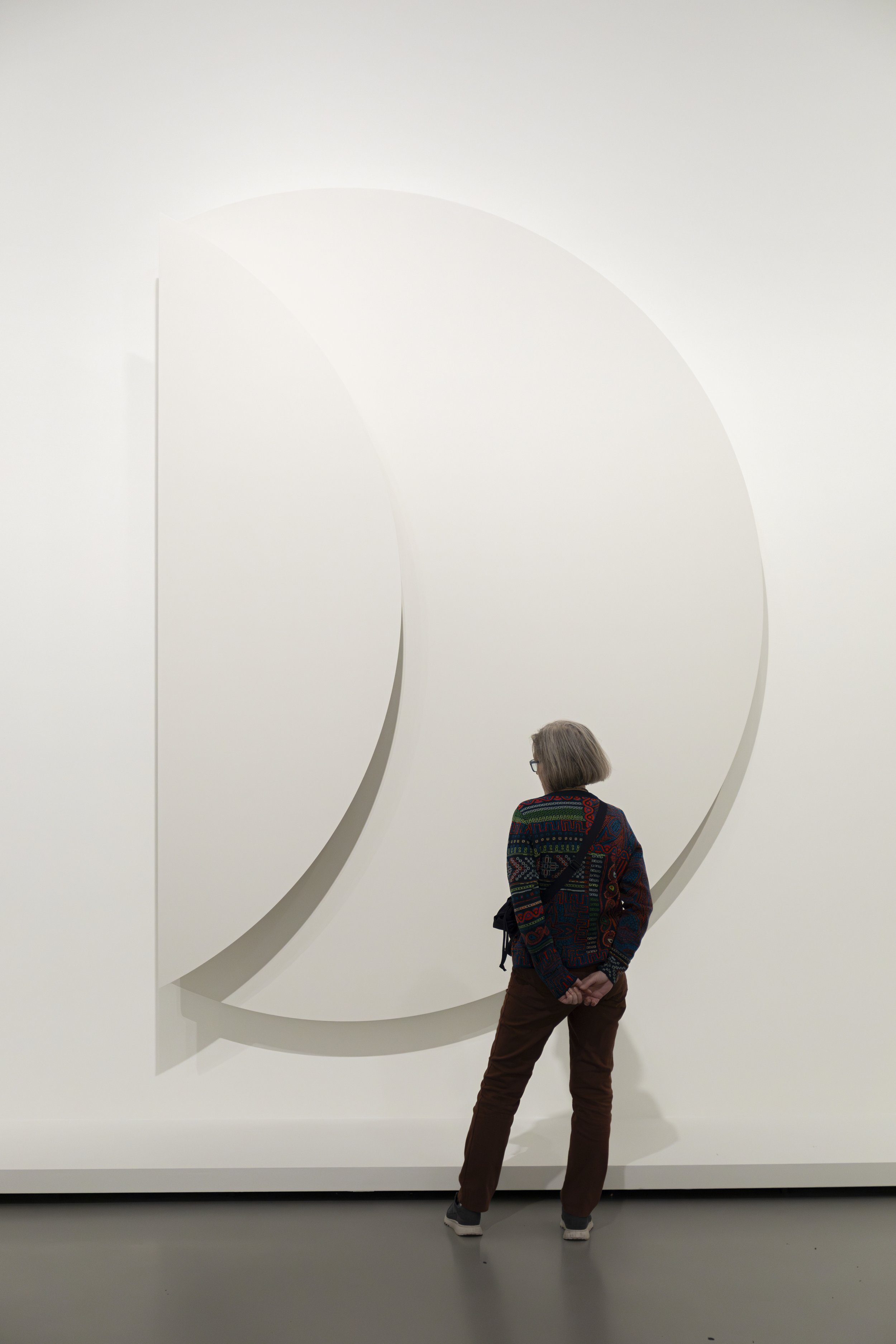










Installation View: Ellsworth Kelly: Shapes and Colors, 1949-2015, May 4 to September 9, 2024, Fondation Louis Vuitton, Paris © Ellsworth Kelly Foundation Photo: © Fondation Louis Vuitton / Marc Domage
The exhibition “Ellsworth Kelly. Shapes and Colors, 1949-2015” traces the artist’s exploration of the relationship between shape, color, line and space through key works from pivotal periods in his career.
The range of works, presented on two floors of the building and across nearly 1,500 square meters, urges the viewer to overlook the deceptive simplicity of Ellsworth Kelly’s artistic vocabulary and to appreciate a body of works that features surprising vitality and richness. Often monochrome, and seemingly rigid in their composition, these works don’t emerge from a system or from adherence to particular rules. They are the result of a visual quest in which shapes and colors go hand in hand with hedonism.
Presented in the Fondation’s ground and first floors, the exhibition includes around 100 works from the collections of the Glenstone Museum, the Fondation Louis Vuitton and major international museums, particularly the Centre Pompidou, Art Institute of Chicago, Philadelphia Museum of Art, Kröller-Müller Museum (The Netherlands), San Francisco Museum of Modern Art, Tate (London), Walker Art Center (Minneapolis) and the Whitney Museum of American Art (New York). Major works have also been generously loaned by the Ellsworth Kelly Studio and by private collections.
The exhibited works cover the wide range of media used by the artist: from painting to sculpture to works on paper - collage and photography. Exhibition highlights include paintings from the artist’s youth, such as Tableau Vert (1952) - the first monochrome made after Ellsworth Kelly’s visit to Giverny - or Painting in Three Panels (1956), a key example of the painter’s commitment to architecture. These early works are exhibited ahead of examples from the now canonical Chatham and Spectrum series. Prominently featured are a selection of drawings of plants produced throughout the artist’s career, as well as a collection of rarely exhibited photographs.
Striking works in the exhibition include Yellow Curve (1990), the first in a series of large-scale floor paintings by Ellsworth Kelly, displayed in a specially-designed space. The installation, which extends over more than 60 square meters, is the first presentation in Europe of Yellow Curve since its creation in 1990 for an exhibition in Portikus, Frankfurt am Main.
Ellsworth Kelly, Atlantic, 1956 Oil on canvas, two panels 203.5 x 289.6 cm Whitney Museum of American Art, New York; purchase © Ellsworth Kelly Foundation
Another monumental work - a permanent one in this case - is the commission completed in 2014 by Ellsworth Kelly for Fondation Louis Vuitton’s Auditorium, in a dialogue with the architect Frank Gehry. Integrated in the exhibition, it will be presented to viewers in a documentary room that looks back on this project and its inclusion in the artist’s œuvre.
The exhibition “Ellsworth Kelly. Shapes and Colors, 1949-2015” is presented as part of “Ellsworth Kelly at 100,” a travelling exhibition organized by Glenstone Museum (Potomac, Maryland) where it was held until March 17, 2024. The French version of the exhibition has been adapted especially in light of Ellsworth Kelly’s contribution to the Fondation Louis Vuitton’s Auditorium. After Paris, where Ellsworth Kelly developed some of his most radical ideas as a young artist, a new presentation will be held at M7 in Doha (Qatar), marking the first exhibition of the artist’s work in the Middle East.
Ellsworth Kelly, Blue Curves, 2014 Painted aluminum 228.6 x 161.3 x 10.5 cm Ellsworth Kelly Studio, Spencertown © Ellsworth Kelly Foundation
This exhibition is accompanied by a fully illustrated catalogue, co-published by Glenstone Museum, Fondation Louis Vuitton, and Les Éditions Hazan, with contributions by Suzanne Hudson, Jean-Pierre Criqui, Peter Eleey, Alex Da Corte, Yuri Stone, Corey Keller and Sarah Rogers.
For more information about this exhibition and the Louis Vuitton Fondation please visit their site here or on Facebook, Instagram, YouTube, and TikTok.
Patternmaker's Maze 编织者迷宫
Wang Ye王也 Woman with Pails: Dynamic Arrangement 提桶的女人:动态组合 2021 Silk on silk handmade embroidery 手工刺绣 19.8 x 19.9 x 4.5 cm 7 3/4 x 7 7/8 x 1 3/4 in © Wang Ye. Courtesy Lisson Gallery
“Assuming that the global art industry, which revolves around everything from creation to collection, is a maze, then are the practitioners the ones setting it up or the ones finding a way out? Are we able to choose? How do we navigate through the tangled paths in this maze?”

















Installation view of Patternmaker’s Maze, Chapter I: Maze, Lisson Gallery, Shanghai, 20 July – 24 August 2024. Courtesy Lisson Gallery. Photography by Alessandro Wang
Taking its name from the labyrinth in the fantasy novel series A Song of Ice and Fire by George R. R. Martin, the group exhibition Patternmaker’s Maze attests to the complexity with which art and the artists engage in reality and the spiritual world. Extending beyond their physical existence, the artworks in this exhibition are recognized as both receivers and active contributors within a maze of socio-political, economic, and natural forces. They interact with the existing world of signs, visuality, and materiality while simultaneously questioning its structures and boundaries, breaking new grounds for interpreting the past, experiencing the present, and shaping the future.
In A Song of Ice and Fire, it is said that “only those who learn to walk [the maze] properly will find wisdom.” Presented in two chapters, ‘Maze’ and ‘Patternmakers’ , this exhibition brings together a group of artists who speak to the challenges and inspirations in the process of navigating and transforming the art world, utilising and being subject to the power dynamics within and across distinct social fields. The artworks presented in Lisson’s Shanghai gallery share a space of conversation, interweaving into a larger collective narrative while preserving their unique perspectives of being in the world. Ding Hongdan’s personal encounters in Estonia have informed the creation of the Toy Museum series, which points to the possibility of different choices made in distinct situations through figures wearing masks with multiple faces. Dressing Mirror (2024) examines human beings’ imagination for fortune and status via the stereotype perfect female image and the multi-dimensional worlds – the physical world, the world of fantasy and desire – divided by the mirror frame depicted in the composition and the frame of this painting.
Ryan Gander瑞安·甘德 Irresistible Force Paradox (LY1A) 不可抗拒的力量悖论 (LY1A) 2023 Paint on aluminium 颜料、铝材 180 x 122 x 5 cm 70 7/8 x 48 x 2 in © Ryan Gander. Courtesy the artist and Gallery Hyundai
Ryan Gander’s practice follows an associative process that bridges the mundane with the mysterious, challenging established notions of language and knowledge while reimagining the presentation and creation of artworks. In recent pieces he approaches “small things that may seem forgettable and insignificant but command our attention without requesting it, etching themselves into our memories.” In Natural Sign / Time Management (Solemn estranged moon) (2021), the artist depicts a full moon witnessed during the pandemic, a period when he experienced a drought of difference and inspiration; while the bold and colourful painting Irresistible Force Paradox (LY1A) (2023) is inspired by the cartoon Tintin – a childhood obsession and longstanding reference for Gander. Here, expressions of energy are visualised in a circle of instinctively comprehensible ‘action marks’ that signify movement, emotions and interactions between characters.
Channa Horwitz夏纳·霍维兹 Rhythm of Lines, 6-7 线条的韵律,6-7 1988 Casein and 23 karat gold leaf on Mylar 酪酸涂料、23克拉金箔、聚酯薄膜 76.2 x 101.6 cm 30 x 40 in © Channa Horwitz. Courtesy Lisson Gallery
Channa Horwitz's Rhythm of Lines, 6-7 (1988) highlights the artist’s rigorous conceptual structures and self- determined rules to capture space, movement and time with numerical sequence and lines. Each work from the Rhythm of Lines series is composed of a pairing of two sets of angled lines, creating intricate moiré patterns. The areas where the sets of lines cross are filled in with twenty-three-karat gold leaf. While the work may appear to be machine-generated, it was entirely hand-made.
Huang Tinglan黄婷岚 Behind the Reflection 镜面的背面 2024 Tapestry with cotton and wool yarn 单面织 100 x 90 cm 39 3/8 x 35 3/8 in © Huang Tinglan. Courtesy Lisson Gallery
Huang Tinglan’s practice centres around different scenes in daily life. The concept of “boxes”, to which she compares spaces, appears throughout her textile works. Characterised by two distinctive dominant colours, Place, Non-place 1 (2022) and The Exit (2022) depict her experience living in New York. The multiple textile layers resulting from the double-weave technique allude to compacted and enfolding spaces. Elsewhere, Behind the Reflection (2024) is inspired by Huang’s experiences of travel since returning to China. The boundary of “boxes” no longer exists, which is evidenced by the vibrant colour palette, the motifs of scenery and dancelike human bodies.
Christian Jankowski presents The Hunt (1992/1997), one of his earliest video works. This piece shows the artist’s one-week supermarket shopping experience during which, with an intention to rebel against modern society and to return to nature, he 'hunts down' groceries, shooting each item with a bow and arrow. Through comic incongruities, Jankowski humorously suggests that 'natural ways’, such as the act of hunting, and capitalist circulation, are not necessarily mutually exclusive.
Richard Long理查德·朗 Untitled 无题 2010 White china clay on black card 高岭土、黑色卡纸 101 x 143 cm 39 3/4 x 56 1/4 in © Richard Long. Courtesy Lisson Gallery
Richard Long makes a striking image in Untitled (2010) using white China Clay and the most elemental of means, his own hands, demonstrating his primeval fascination with mark-making. “All my work is simple. I like the primal energy of just handprints or fingerprints. It’s like cave painting.” Known for creating works that trace his physical movement through space, Untitled (2010) emphasises Long’s preoccupation with the physical engagement of the body in his work.
Otobong Nkanga奥托邦戈·恩坎加 Silent Anchor I 沉默的锚I 2023 Hand-blown glass and hand woven rope 手工吹制玻璃、手工编织绳索 Installed/装置后尺寸: 16 x 73 x 86 cm, 6 1/4 x 28 3/4 x 33 7/8 in © Otobong Nkanga. Courtesy Lisson Gallery
Otobong Nkanga’s Silent Anchor I (2023) presents a circuitry of hand-dyed rope and biomorphic glass forms, conceived as a spatial cleanser or talisman. A shallow well on the surface of the glass holds an offering of lavender oil, a substance believed to have healing, soothing and anti-inflammatory properties. The sculpture amplifies and extends the concept of energetic intervention beyond the body and into the spatial realm, suggesting a permeable boundary between the two domains.
Ren Jie任倢 Night Watch: The Origin of the World 3 夜巡:世界的起源3 2023 Wood frame with hand-woven reflexive textile and felt 木框、手工编织反光织物和毛毡 30.5 x 30.5 x 2 cm 12 x 12 x 0 3/4 in ed. 1 of 3 + 1 AP © Ren Jie. Courtesy Lisson Gallery
Ren Jie’s Night Watch series coalesces materials, everyday images as well as visual and physical experiences of contemporary life through the lens of the entanglement between textile techniques and modern computer technology. This series invites viewers to engage with the dialogue between space and materiality in a world dominated by fleeting digital viewing experiences, generating new interpretations on the subjects of labour and gender and unleashing the imagination around these topics from a literature perspective.
Shen Ruijun沈瑞筠 Swan Lake 天鹅湖 2016 Mixed-media with plinth综合材料、底座 45 x 120 x 45 cm 17 3/4 x 47 1/4 x 17 3/4 in © Shen Ruijun. Courtesy Lisson Gallery
Shen Ruijun’s mixed media installation Swan Lake (2016) depicts a state of multi-dimensionality, change, and unity of opposites. The piece’s utilisation of one-way mirror glass leads to different images appearing from different viewing angles. Referencing the duality and underlying, multi-faceted nature of the female characters in its namesake ballet masterpiece, the work highlights the perpetual change and repetition in time, places and contexts.
Shi Zheng 施政 BINE 蔓 2019 Single channel video installation, LED screen 单频影像装置、LED屏幕 © Shi Zheng Courtesy Lisson Gallery
Shi Zheng removes the images and texts from the front page of The New York Times, then trains an Artificial Neural Network to learn the data set consisting of lines between the columns. In the resulting single-channel video BINE (2019), the shifting and orderly lines appear and diminish to compose a body that continuously grows. Once acting as "the silhouette" that divided information, event, and time, the work explores “latent space” and delineates time by tracing its varying boundaries and framework.
Cheyney Thompson切尼·汤普森 Caning [4, interval] 藤茎 [4, 子域] 2023 Acrylic on canvas 布面丙烯 Installed/装置后尺寸: 118.1 x 118.1 x 2.2 cm, 46 1/2 x 46 1/2 x 7/8 in Square/画布大小: 83.5 x 2.2 cm, 32 7/7 x 32 7/8 x 7/8 in ©Cheyney Thompson. Courtesy Lisson Gallery
Cheyney Thompson started creating his Caning paintings series in 2004. In Caning [4, interval] made in 2023, the artist continues his exploration of structure through a weaving motif. Living in a highly structured world, Thompson considers the notion that structures are themselves built on contradictions. If a motif carries with it a trace of motivation, then these paintings are concerned with what can happen when structures are strained to a point of failure.
Wang Ye王也 Seated Bather 女坐浴者 2020 Silk on silk handmade embroidery 手工刺绣 19.9 x 15.7 x 4.5 cm 7 7/8 x 6 1/8 x 1 3/4 in © Wang Ye. Courtesy Lisson Gallery
Wang Ye develops his narratives by using traditional, hand-made embroidery techniques, originated in Hunan in the artist’s Embroidernity series. Moth (2022) was inspired by a giant moth he saw on a rusty window in his childhood. Having never seen the same type of moth again, he questioned whether such an experience was a dream or a missing memory. Subsequently, Wang identified the potential species by remembrance. Through this representation, the artist furthers his explorations of Chinese folk art technique and aesthetics.
About Lisson Gallery
Lisson Gallery is one of the most influential and longest-running international contemporary art galleries in the world. Today, the gallery supports and promotes the work of more than 70 international artists across spaces in London, New York, Los Angeles, Shanghai, and Beijing. Established in 1967 by Nicholas Logsdail, Lisson Gallery pioneered the early careers of important Minimal and Conceptual artists, such as Art & Language, Carl
Andre, Daniel Buren, Donald Judd, John Latham, Sol LeWitt, Richard Long and Robert Ryman among many others. It still works with many of these artists and others of that generation, from Carmen Herrera and Olga de Amaral to Hélio Oiticica and Lee Ufan. In its second decade the gallery introduced significant British sculptors to the public for the first time, including Tony Cragg, Richard Deacon, Anish Kapoor, Shirazeh Houshiary and Julian Opie. Since 2000, the gallery has gone on to represent many more leading international artists such as
Marina Abramović, Ai Weiwei, John Akomfrah, Liu Xiaodong, Otobong Nkanga, Pedro Reyes, Sean Scully, Hiroshi Sugimoto and Wael Shawky. It is also responsible for raising the international profile of a younger generation of artists including Dana Awartani, Cory Arcangel, Garrett Bradley, Ryan Gander, Josh Kline, Hugh Hayden, Haroon Mirza, Laure Prouvost and Cheyney Thompson.
Artists:
Ding Hongdan | Ryan Gander | Channa Horwitz | Huang Tinglan | Christian Jankowski | Richard Long | Otobong Nkanga | Ren Jie | Shen Ruijun | Shi Zheng | Cheyney Thompson | Wang Ye
Chapter I: Maze | 20 July – 24 August 2024
Chapter II: Pattern Makers | 31 August – 12 October 2024
There was an opening on July 20th of this year
For more information about this exhibition and others, please visit the Lisson Gallery here. The gallery can also be found on Facebook, YouTube, and Instagram.
DANIEL CHEN:PROCESS
Valise, Checkmate, Frequency
Radian Gallery is pleased to present “PROCESS,” the crystalline and pixelated landscape paintings of California artist Daniel Chen. The show opened on Wednesday June 24th is available for viewing through Saturday, August 31st. There was an opening reception on August 1 2024 from 5:00pm - 7:30pm PT at the gallery.


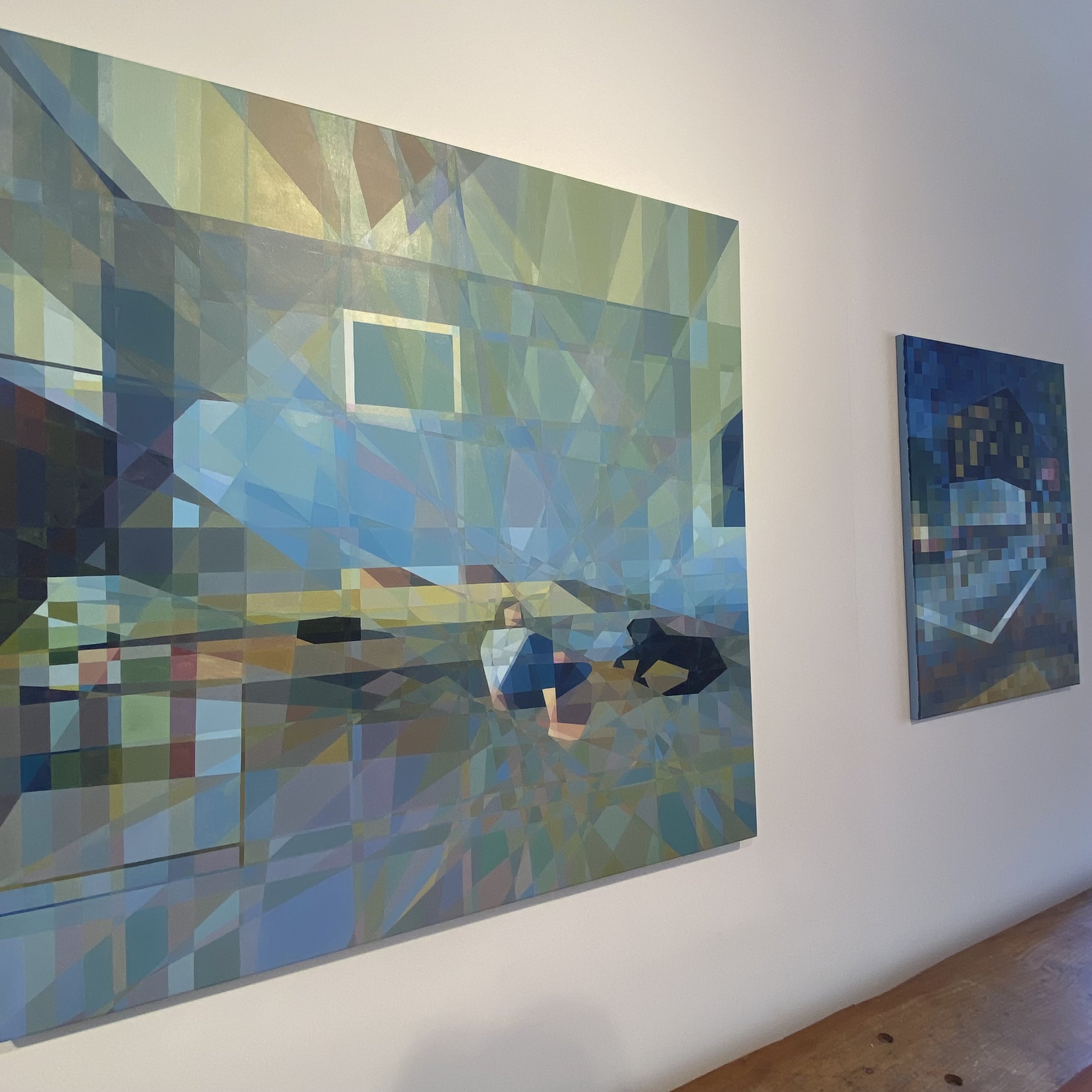
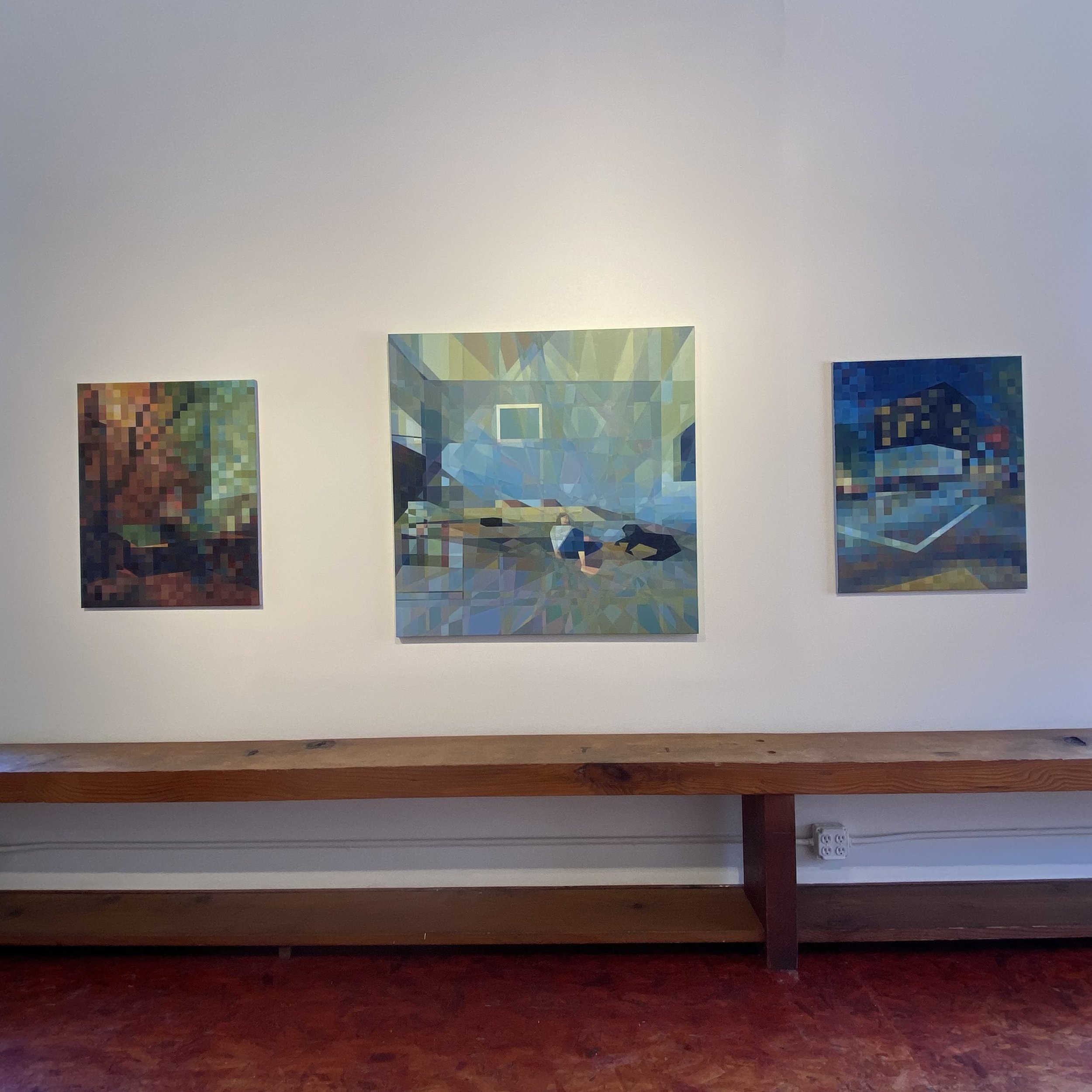

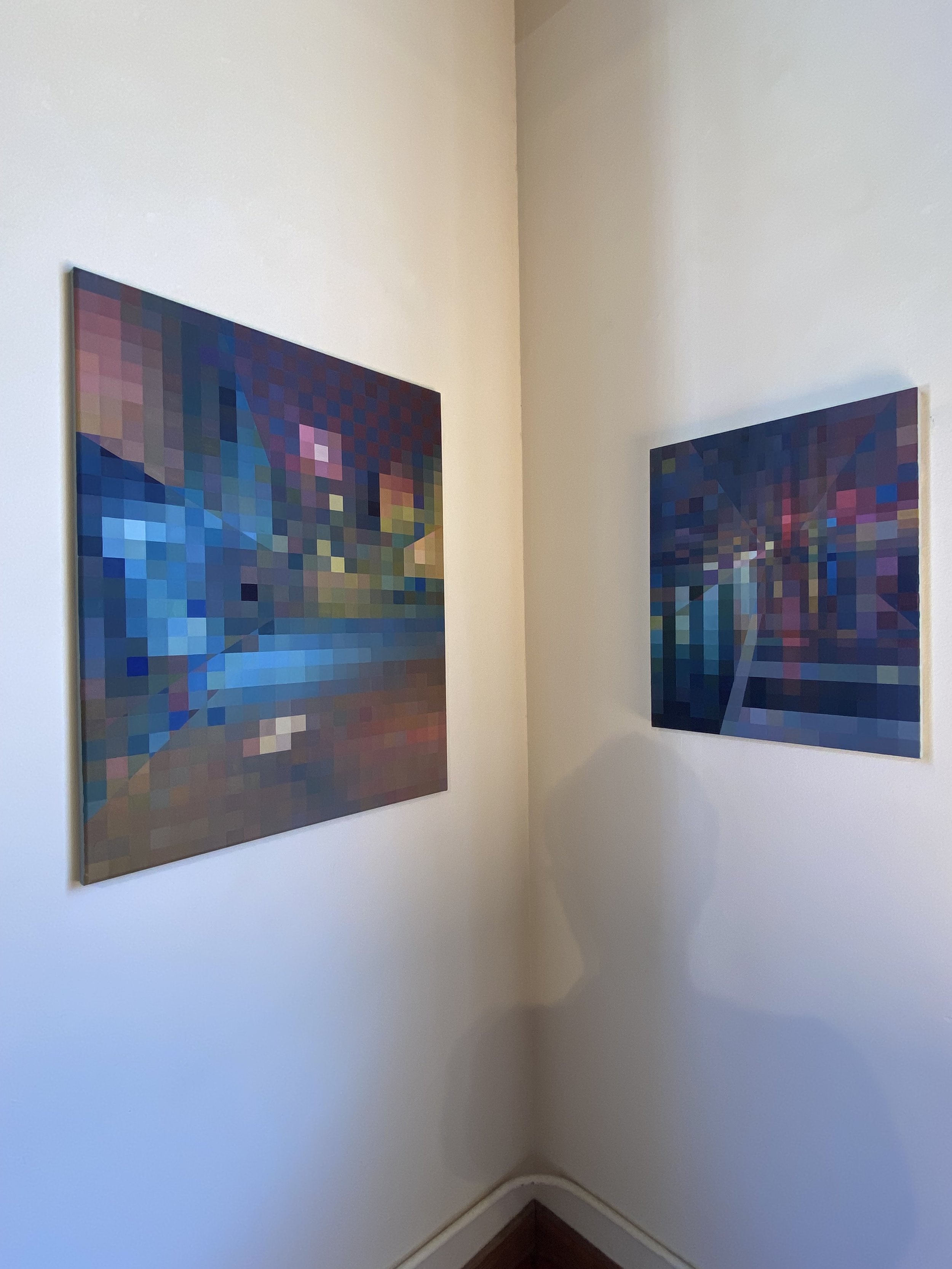


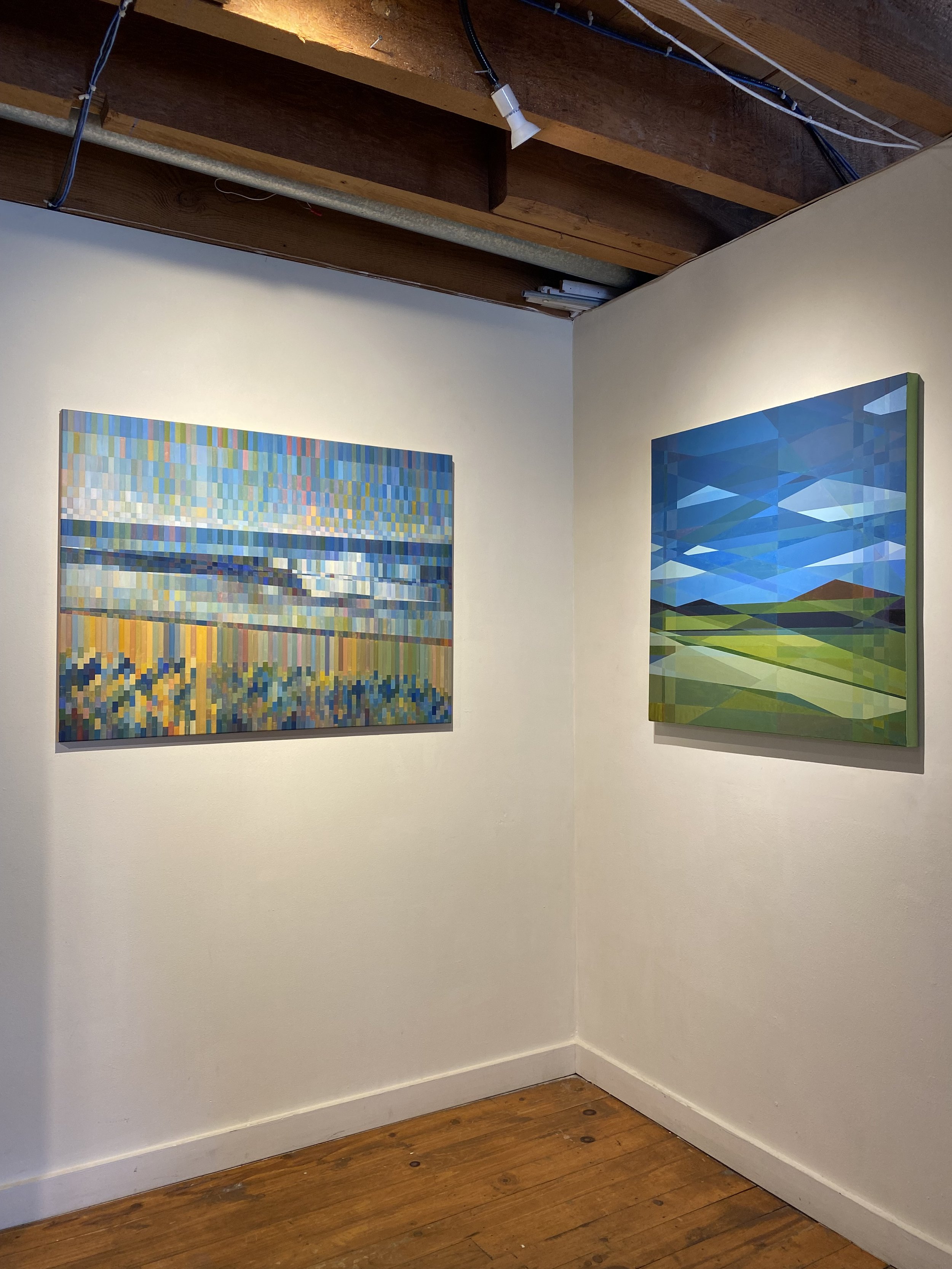

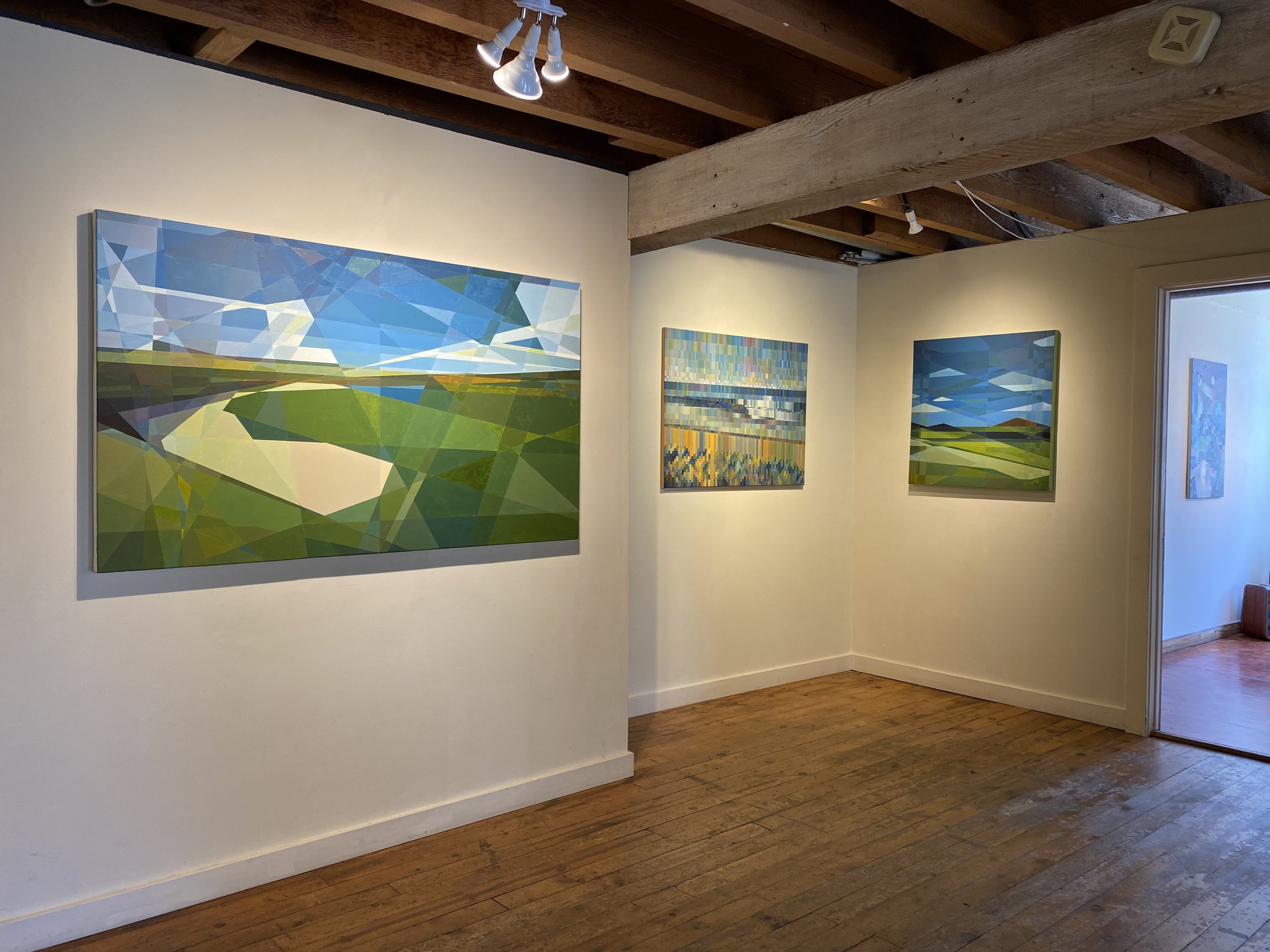
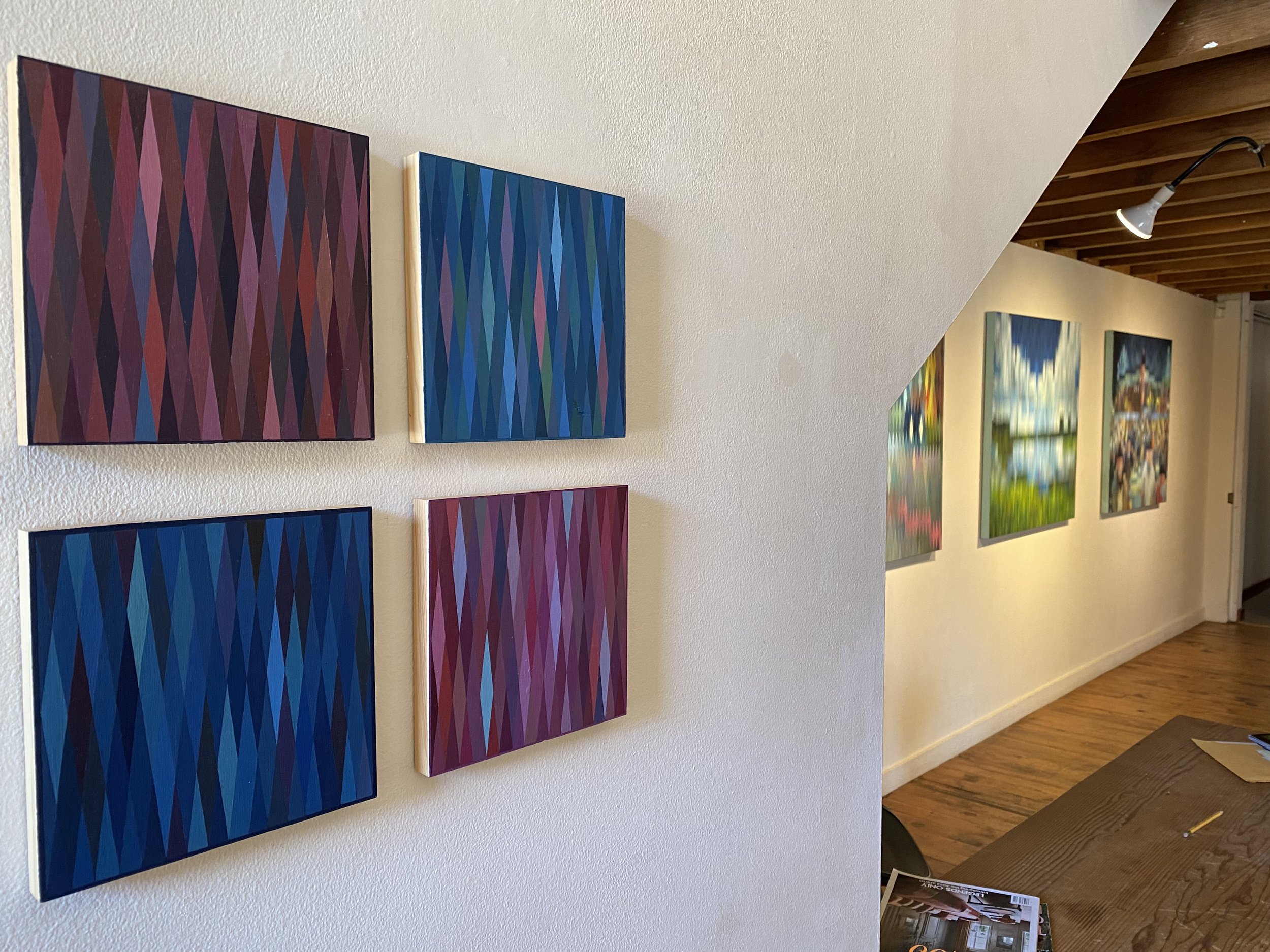
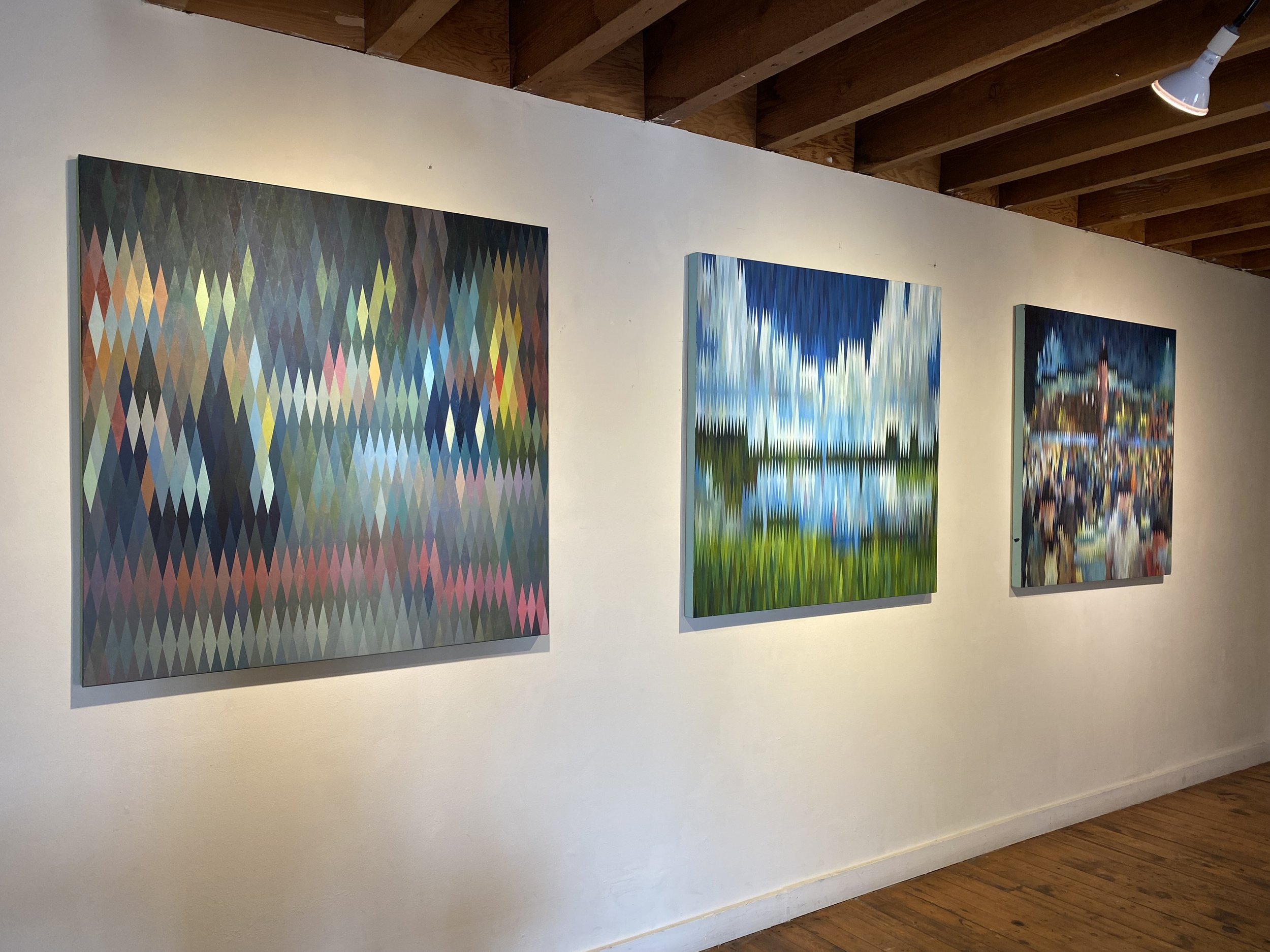
PROCESS, 2024, installation view © Courtesy Radian Gallery
PROCESS is Radian Gallery’s first solo show of Chen’s oil paintings. In PROCESS, Daniel Chen asks the viewer to consider both the artist’s technical and conceptual approach (his process), as well as the way they regard, internalize, and contextualize their own experience with his work (their process).
About Daniel Chen
Daniel Chen is a painter based in San Francisco, California, who spent his formative years between the SF Bay Area and Taiwan. Instead of pursuing a legal career after college, he chose to follow his true passion. Daniel holds degrees from the Academy of Art University and the California College of the Arts. Daniel's artistic practice revolves around the exploration of space, color, and memory. Using oil on canvas, he employs linear planes, pixels, and striking color shifts to create enigmatic landscapes and memories. His work draws significant inspiration from Impressionists and currently encompasses two series: 'Pixels' and 'Interiors and Exteriors.' Influenced by artists like Claude Monet, Francis Bacon, and David Choe, Daniel's work represents a unique fusion of diverse artistic elements. His first lessons in painting came from his maternal grandfather, a traditional calligraphy painter and art teacher. In addition, his mother, based in Kaohsiung, Taiwan, is also an oil painter.
About Radian Gallery
Radian is dedicated to showing California contemporary art. Located in San Francisco’s SoMa District, the gallery, under Founding Director Tony Wessling, a University of Michigan School of Art graduate and successful creative agency entrepreneur, has been steadily building a folio of highly talented rising artists whose work engages viewers with the combination of technical skill and conceptual exploration that is the hallmark of the Golden State’s ethos. “Radian” is the mathematical term for the angle that underpins an arc, and Radian, the gallery, aims to provide California artists with an angle of approach to the broader contemporary art conversation that underpins an upward arc of their career.
Please visit our website here or our Instagram here. For more information about Daniel’s artwork please visit his site here, and you can also find him on Instagram here. His interview with the magazine can be found here also.
Christina Kent: CAPTURE








San Francisco, CA - Radian Gallery is pleased to present “CAPTURE,” the atmospheric and introspective landscape paintings of California artist Christina Kent. The show is opened on June 24th and will on view through August 31st 2024, there was an opening reception on August the 1st from 5:00pm - 7:30pm.
Fog on Haight Street 40x30, Oil on Canvas
CAPTURE is Radian Gallery’s first solo show of Kent’s oil paintings. Throughout CAPTURE, Christina collects ephemeral slivers of the sublime created by the infinite permutations of light upon cityscapes and landscapes, channeling them through the brush and palette knife onto her deeply evocative canvases. Observing the shifts of light and color throughout the year, Kent’s impressionistic and atmospheric paintings highlight the bittersweet nature of fleeting moments.
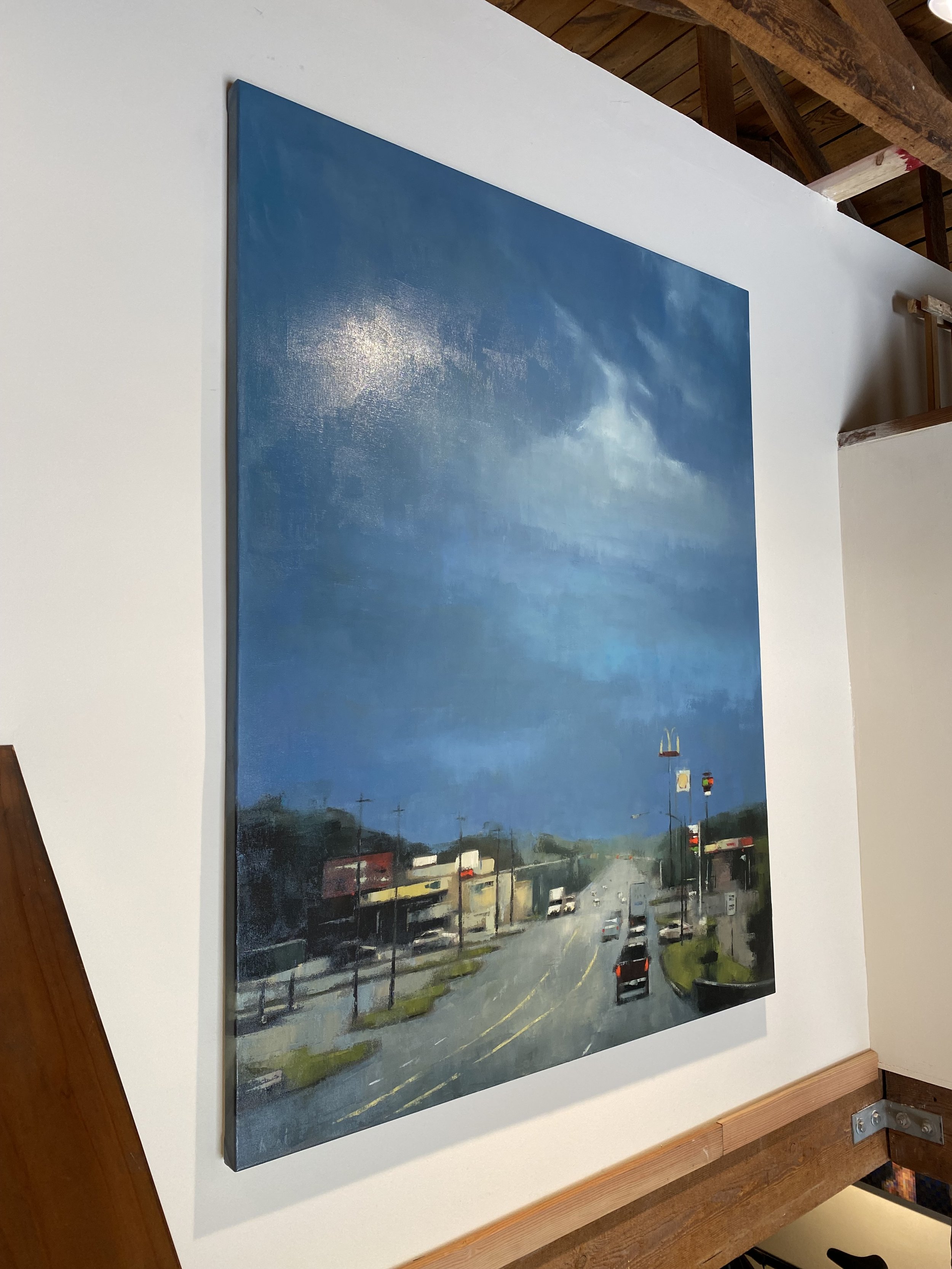


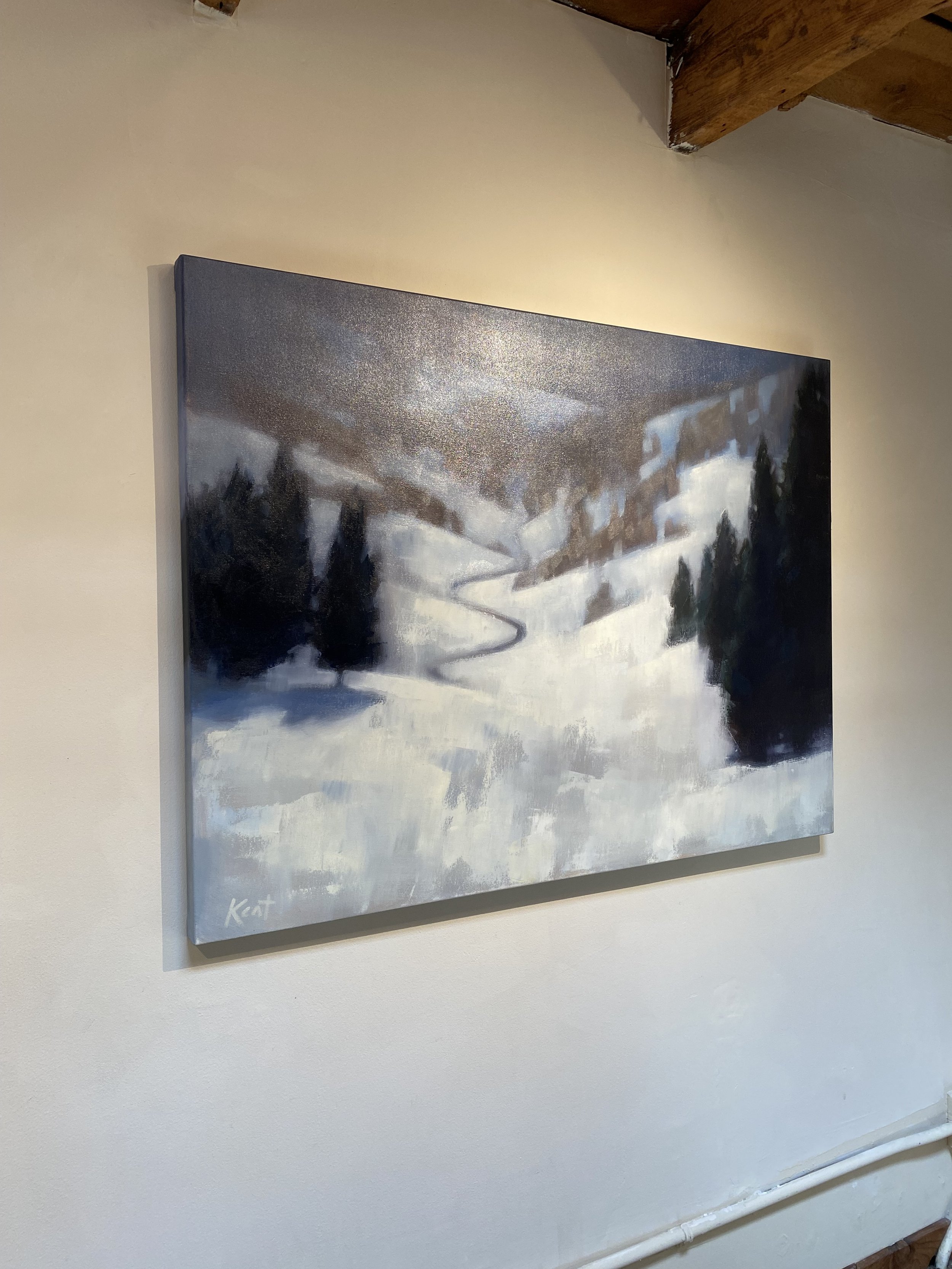
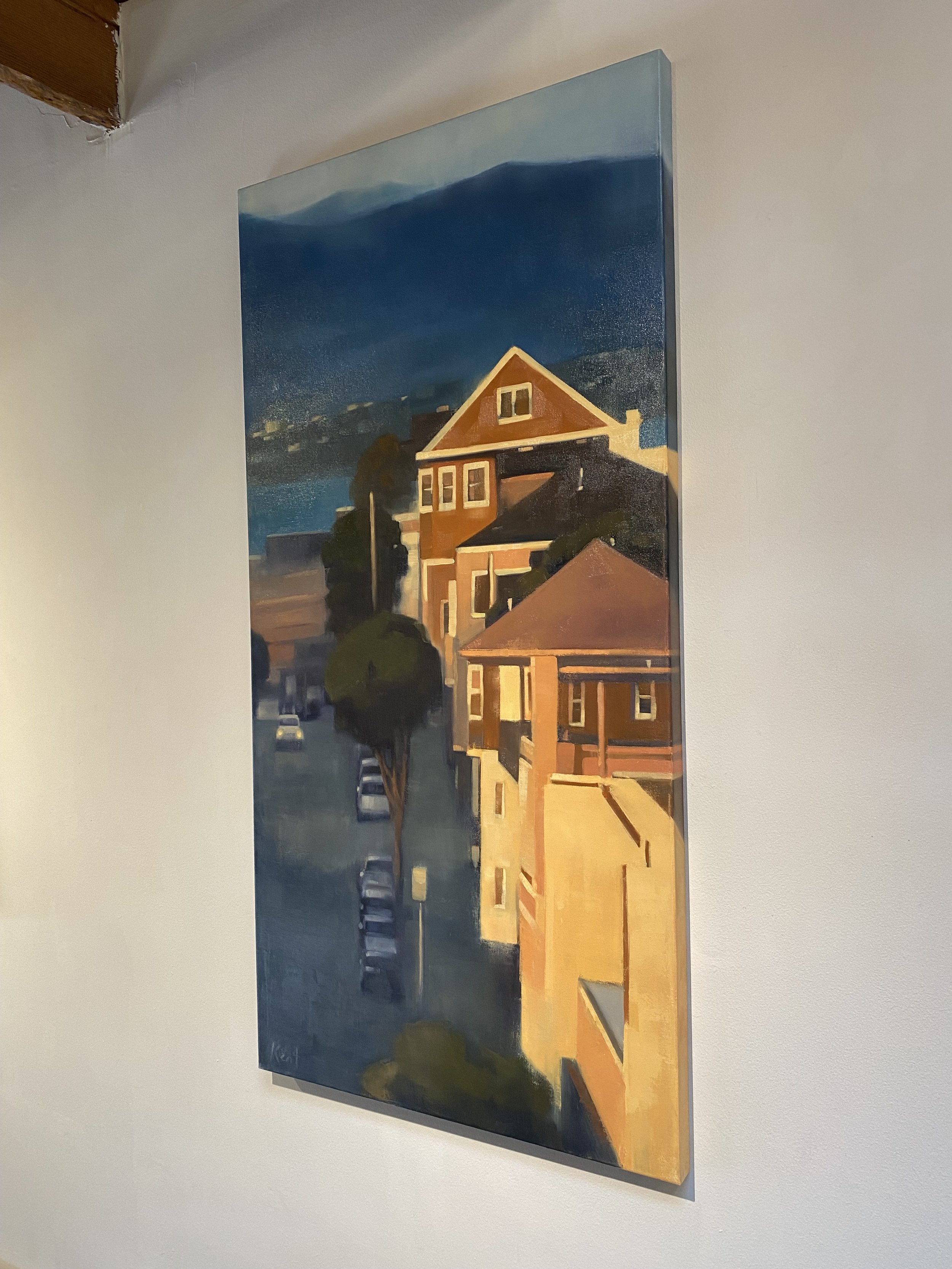
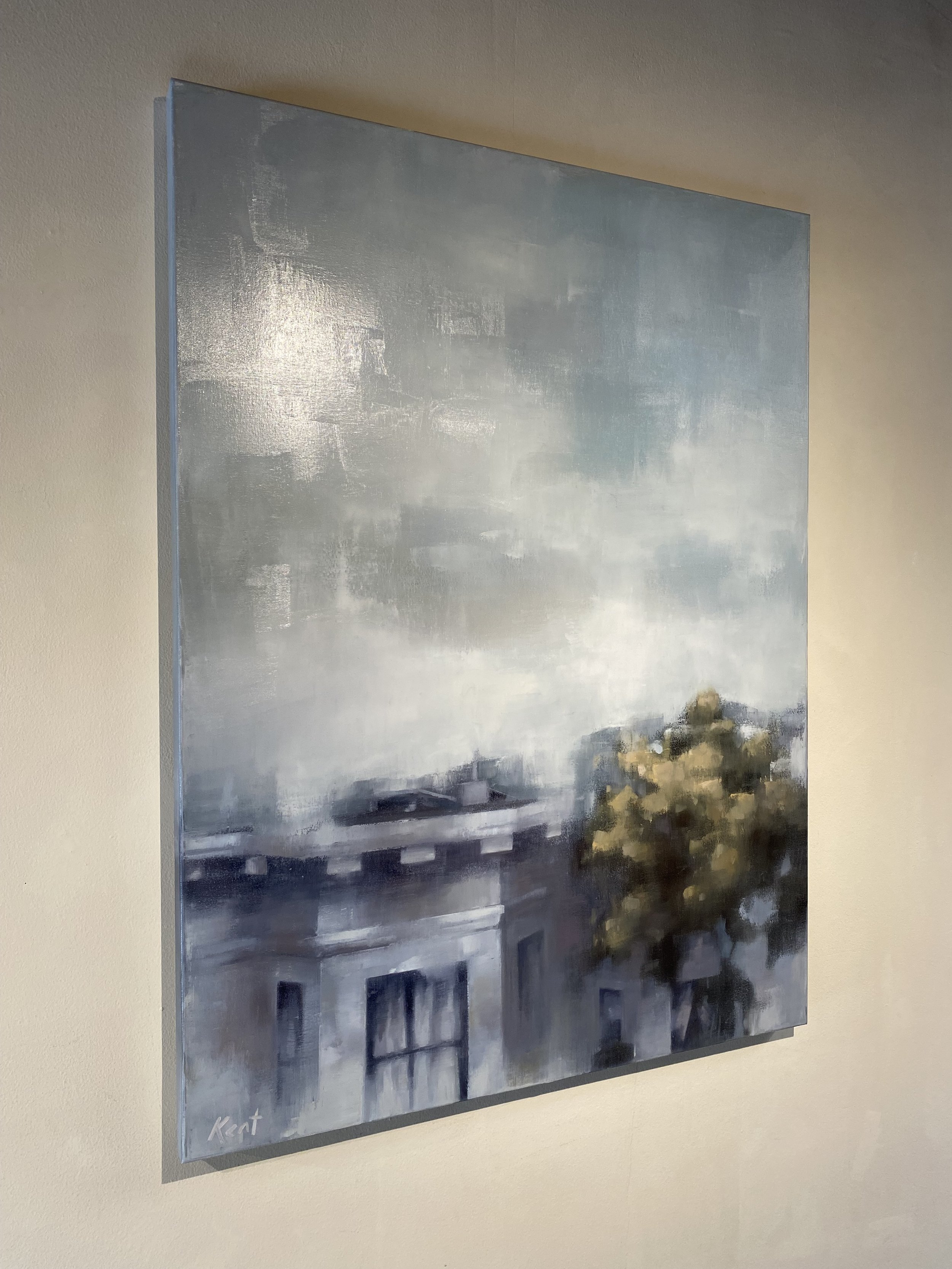
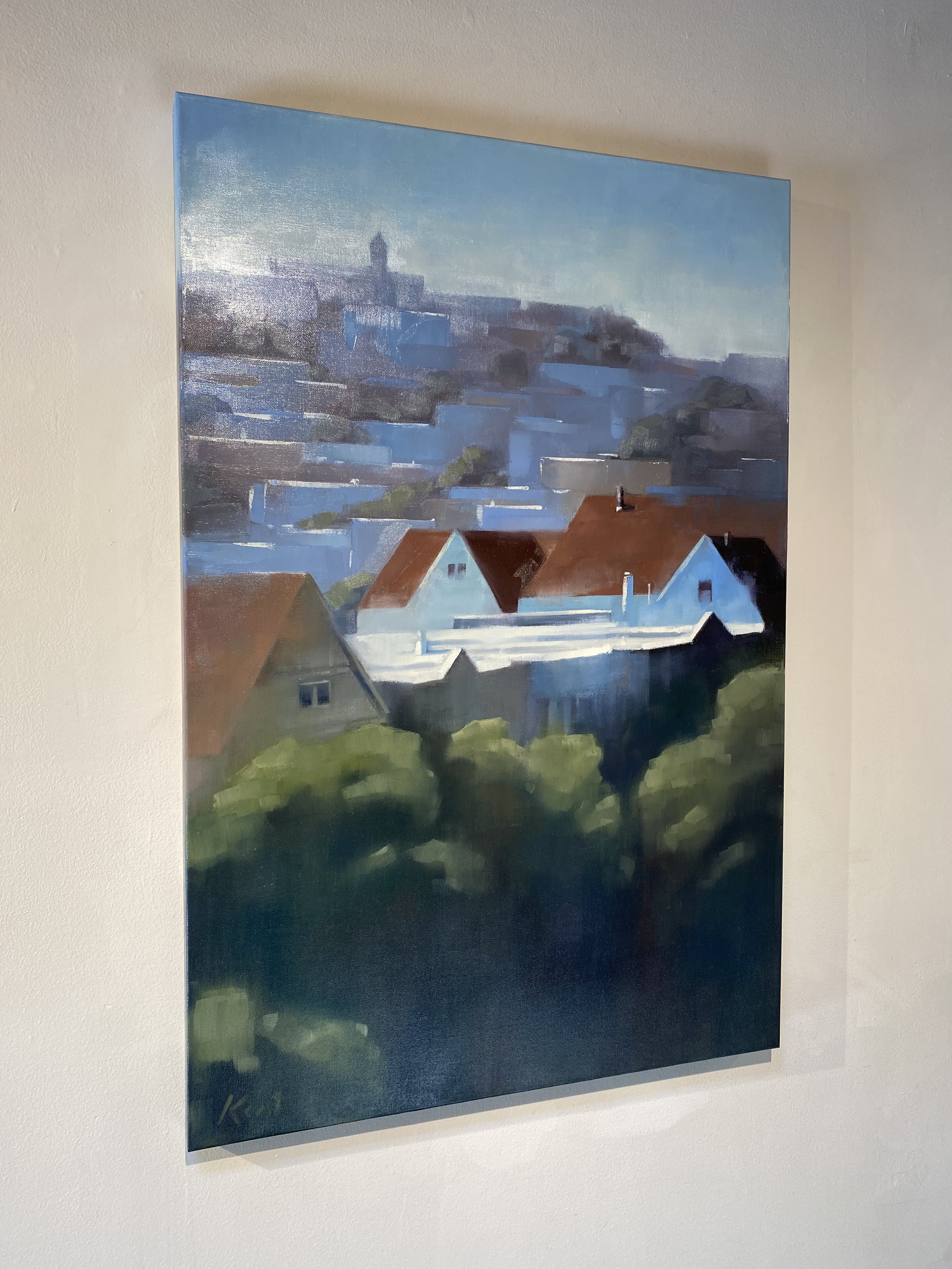
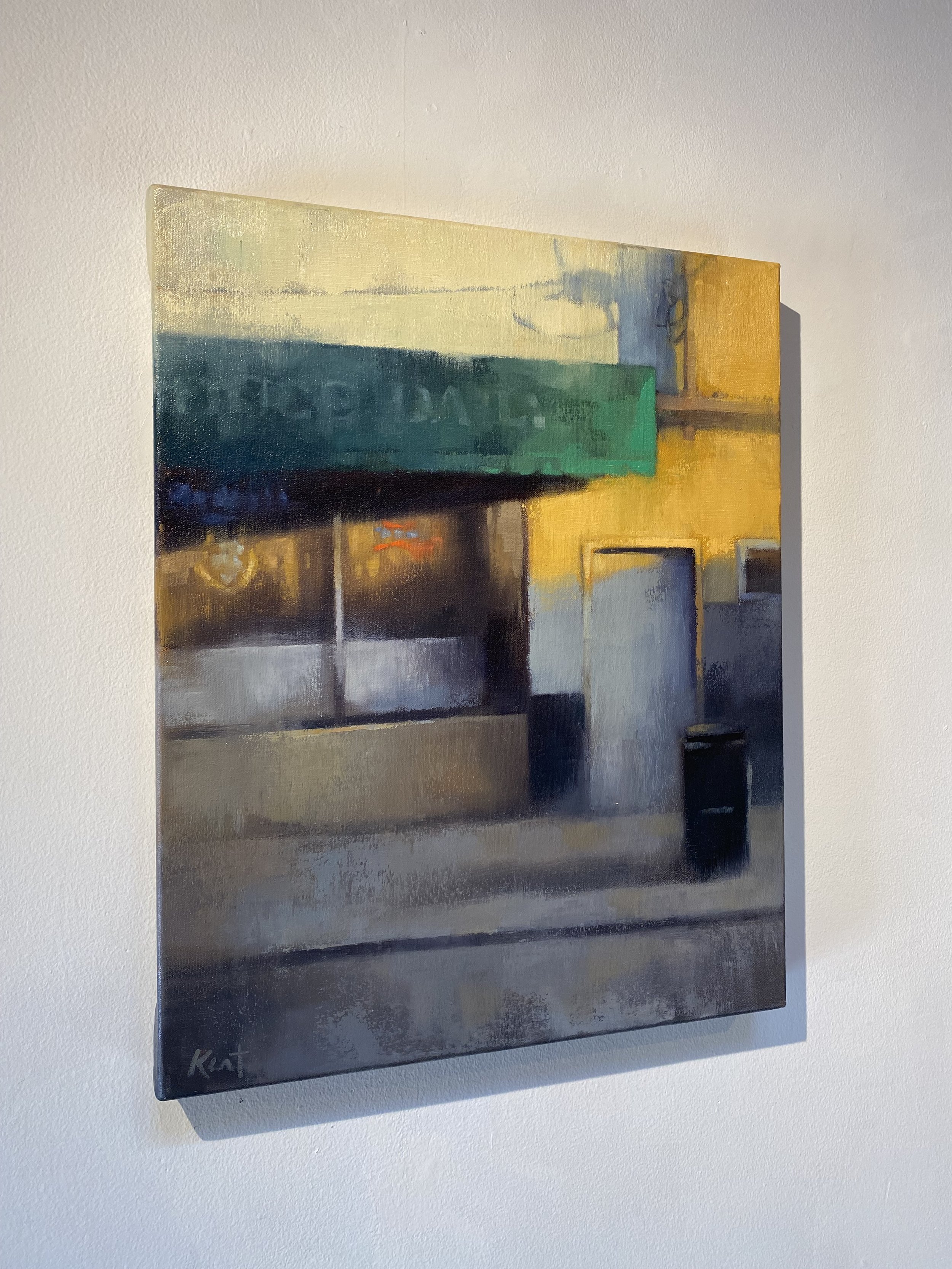
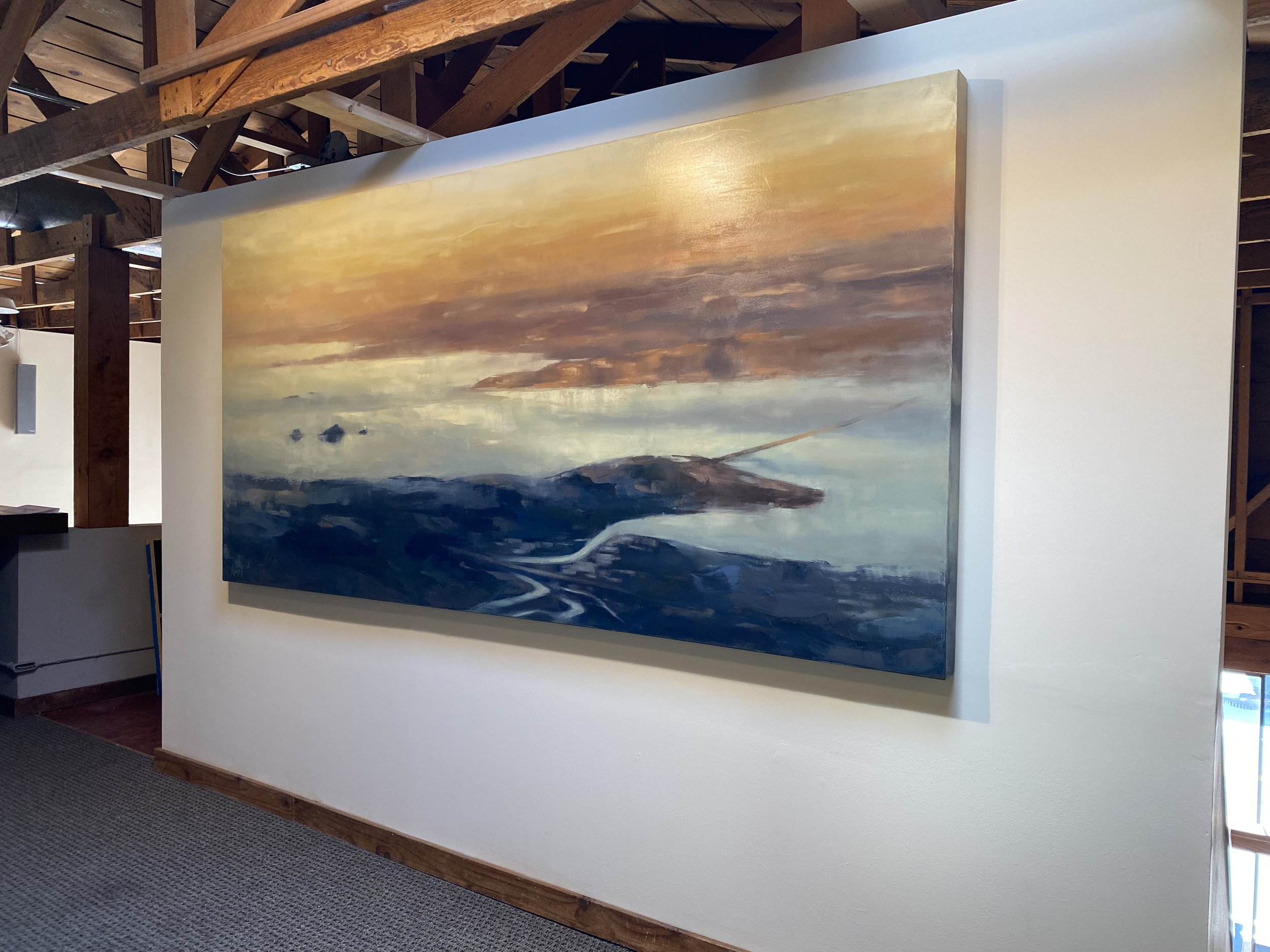
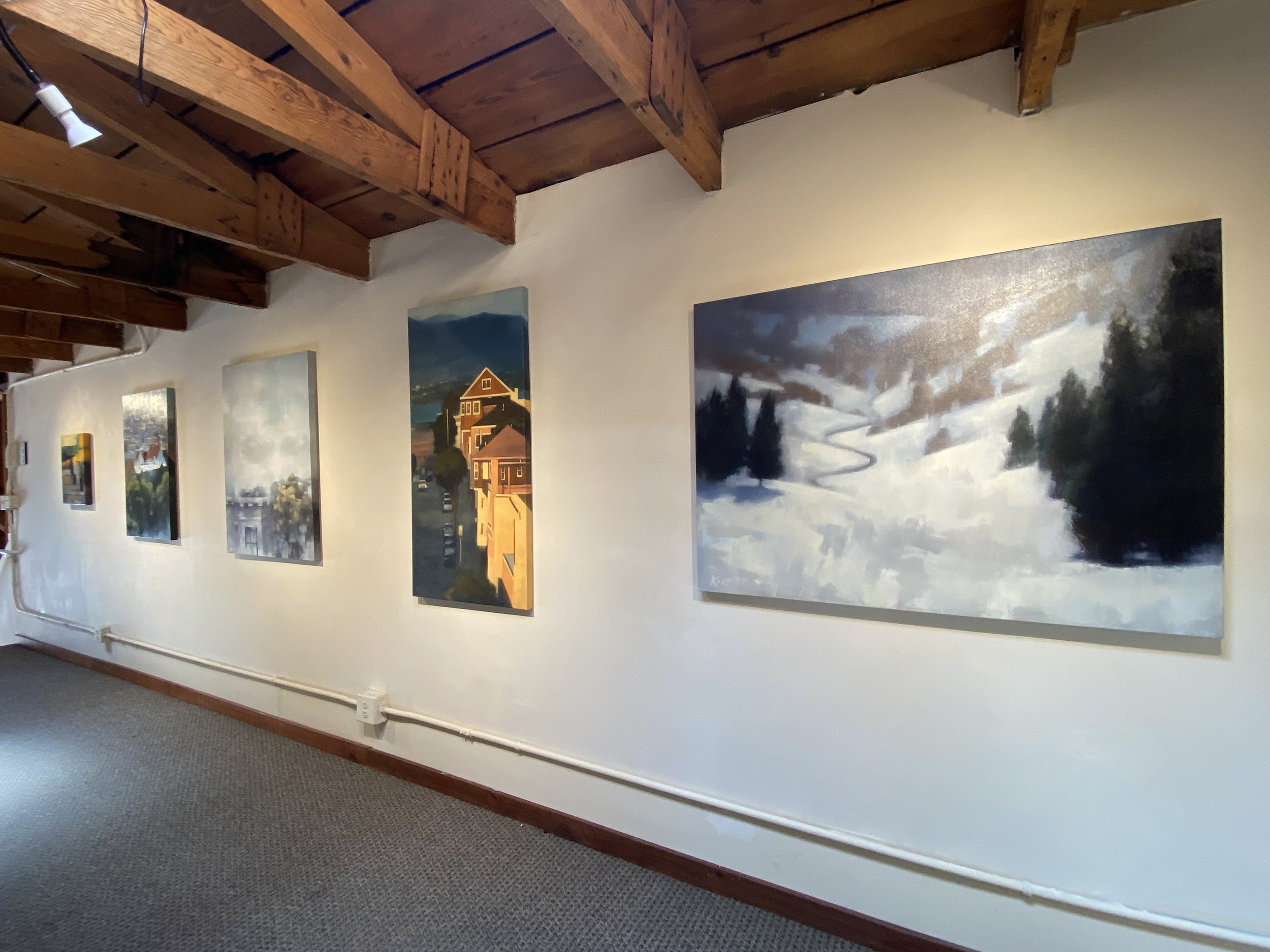
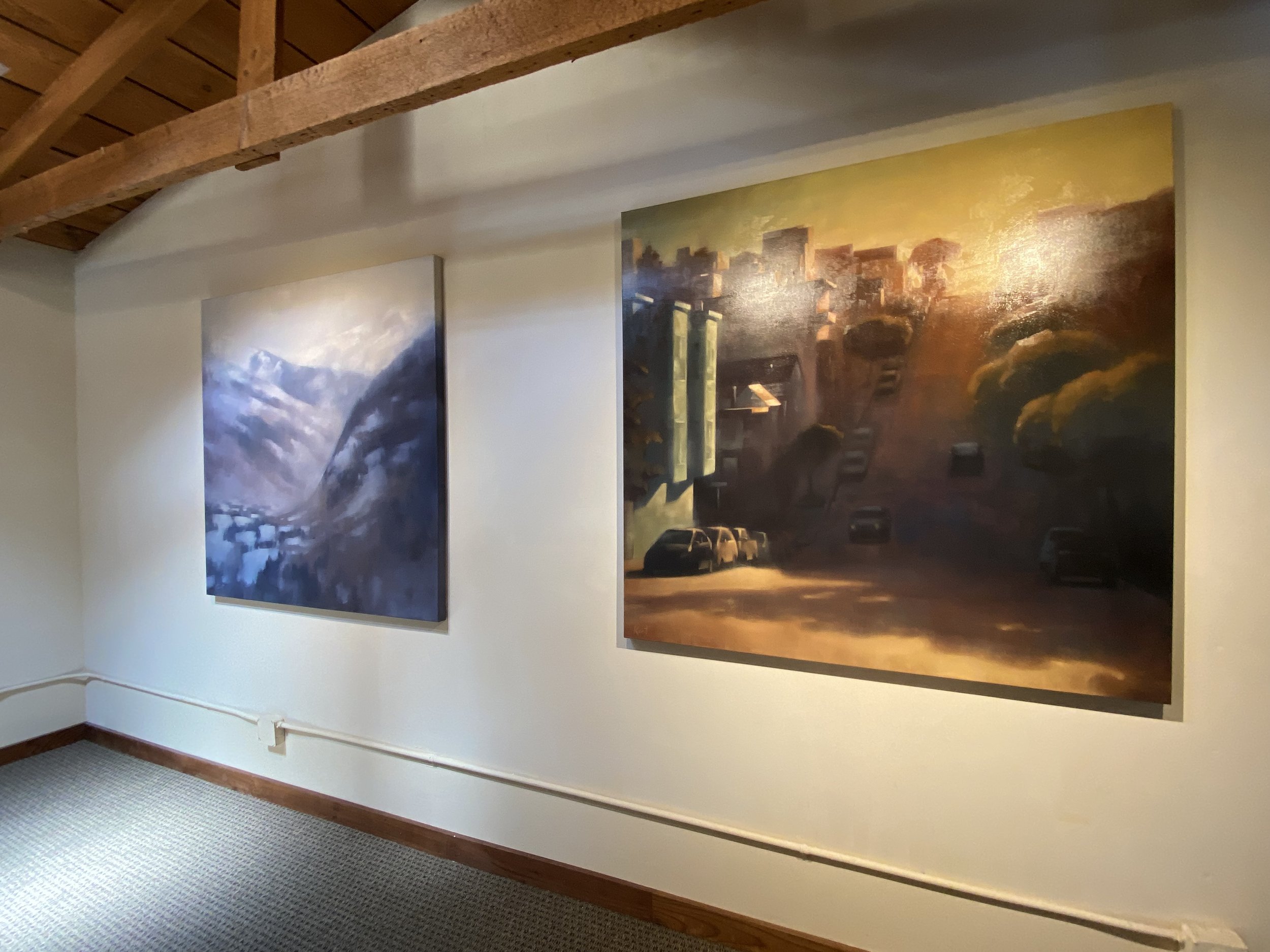
Installation Views: Capture, 440 Brannan Street San Francisco, CA 94107 June 24 through August 31, 2024, Photography courtesy Radian Gallery
About Christina Kent
A former PhD economist, Kent’s transition to painting was catalyzed by a realization that the rational economic lens was insufficient to capture the profound complexity inherent in human experience. Through her paintings, she reflects on the subtle nuances hidden in mundane moments of everyday life.
Texas Storm 60x48 Oil on Canvas
About Radian Gallery
Radian is dedicated to showing California contemporary art. Located in San Francisco’s SoMa District, the gallery, under Founding Director Tony Wessling, a University of Michigan School of Art graduate and successful creative agency entrepreneur, has been steadily building a folio of highly talented rising artists whose work engages viewers with the combination of technical skill and conceptual exploration that is the hallmark of the Golden State’s ethos. “Radian” is the mathematical term for the angle that underpins an arc, and Radian, the gallery, aims to provide California artists with an angle of approach to the broader contemporary art conversation that underpins an upward arc of their career.
Please visit our website here or our Instagram here. For more information about Christina’s artwork please visit her site here, and also you can find her on Instagram here.
The Art of the Olympics
The Art of the Olympics, 2024, installation view © Marc Newson; © Andreas Gursky, VG Bild-Kunst, Bonn, Germany Photo: Thomas Lannes Courtesy Gagosian
“Art enlightens the intelligence, captivates thought, and incites ambition. —”
PARIS,—Gagosian is pleased to announce The Art of the Olympics, a two-part group exhibition organized in association with the Olympic Museum to celebrate the Olympic and Paralympic Games Paris 2024.
The Art of the Olympics, 2024, installation view © Nam June Paik Estate Photo: Thomas Lannes Courtesy Gagosian
The gallery at rue de Castiglione features artworks in various mediums that explore sport’s rich cultural, iconographic, social, and emotional tapestry. Among the selections is Andreas Gursky’s monumental photograph Amsterdam, Arena I (2000), which presents a panoramic aerial view of a football match, reducing the uniformed players and manicured turf to an abstract composition of line and color. Man Ray’s similarly playful Jeux Nocturnes (c. 1970) infuses the soccer ball itself with a spirit of mystery that suggests a hidden dynamic, while Duane Hanson’s polychrome bronze sculpture Bodybuilder (1989–90) portrays an unnamed muscular, shirtless man encountered by the artist at a gym in Hollywood, Florida; the subject’s skin is sheened with sweat and his expression conveys a state of deep self-immersion. Jonas Wood’s Scholl Canyon (2005) transforms the serene landscape of a sprawling golf course into a multilayered abstract composition and Christo’s drawing for Running Fence (1974), a 39.4-kilometer public sculpture, communicates a sense of shared exhilaration akin to a marathon in its nurturing of cultural exchange and unity. The repurposing of fabric used in the artist’s Arc de Triomphe, Wrapped (1961–2021) in tents for the Paris Olympic Games extends his enduring legacy. A further selection includes works by Keith Haring, Takashi Murakami, Marc Newson, Ed Ruscha, Andy Warhol, and others.
Marc Newson Black Surfboard, 2017 Aluminum 72 7/8 x 16 3/8 x 5 3/4 inches (185 x 41.5 x 14.5 cm) Edition of 3 + 2 AP © Marc Newson Photo: Rob McKeever Courtesy Gagosian
The second-floor gallery at rue de Ponthieu features a selection of posters drawn from the Olympic Museum’s collection, which were designed by internationally renowned artists to promote and commemorate previous editions of the Olympic Games. Among the highlights are David Hockney’s summery design for the 1972 Games in Munich, which features an image of an athlete diving into
the undulating blue-and-green waters of a swimming pool; Robert Rauschenberg’s Star in Motion (1982), a fragmented photographic collage selected as the official poster for the 1984 Summer Olympic Games in Los Angeles; Cy Twombly’s poster for the 1984 Winter Olympics in Sarajevo, which draws on the ancient origins of the games in a characteristic scrawl; and Rachel Whiteread’s playful abstract interpretation of the Olympic Games London 2012, which comprises a constellation of overlapping rings of bright colored paint. Other artists represented by specially commissioned graphics include Christo, Michael Craig-Martin, Tracey Emin, Howard Hodgkin, Roy Lichtenstein, Henry Moore, Nam June Paik, Park Seo-Bo, Pablo Picasso, James Rosenquist, Pierre Soulages, Andy Warhol, and Zao Wou-Ki. On view alongside the posters is an array of infrequently exhibited items of correspondence and other artifacts closely related to previous editions of the Olympic Games.
The Art of the Olympics, 2024, installation view © The Estate of Howard Hodgkin. All rights reserved, DACS/Artimage 2024; © Tracey Emin. All rights reserved / Adagp, Paris, 2024; © Michael Craig-Martin; © Rachel Whiteread Photo: Thomas Lannes Courtesy Gagosian
Together, the two parts of The Art of the Olympics celebrate the dynamic interplay between art and sport, fostering a vibrant dialogue that continually rejuvenates and enriches both realms. This exhibition, which pays tribute to the cultural significance of sport in contemporary society, continues a gallery tradition, established in 2019 with An Exhibition for Notre-Dame at rue de Ponthieu, of responding directly to key events in the city.
The Art of the Olympics, 2024, installation view © Keith Haring Foundation Photo: Thomas Lannes Courtesy Gagosian
The display at rue de Castiglione will be visible from the street twenty-four hours a day, while the whole exhibition will remain open to visitors for an extended period through the summer during the Olympic and Paralympic Games.
A portion of proceeds from sales will be donated to the Olympic Refuge Foundation, a nongovernmental organization founded in September 2017 by the International Olympic Committee and based in Lausanne, Switzerland. The foundation’s primary stated goals are to support the protection, development, and thriving of displaced young people worldwide, through sport.
Andreas Gursky Amsterdam, Arena I, 2000 (detail) Diasec-mounted chromogenic print, in artist's frame Framed: 109 1/8 x 81 1/2 x 2 1/2 inches (277 x 207 x 6.2 cm) Edition of 6 © Andreas Gursky, VG Bild-Kunst, Bonn, Germany Courtesy Gagosian
About the Olympic Museum
Located in the Olympic Capital of Lausanne, Switzerland, the Olympic Museum is the official home of the world’s largest and most comprehensive collection of Olympic heritage, including artifacts, archives, images, books, and film. The museum’s international exhibitions and programs connect people of all ages with the diverse stories, art, history, and culture of the global phenomenon that is the Olympic Games. Through educational initiatives inspired by peace, solidarity, and the Olympic values of respect, friendship, and excellence, the Olympic Museum brings together athletes, visitors, students, artists, and an affiliated network of museums across the world. For more information, please visit olympics.com.
Robert Rauschenberg Robert Rauschenberg’s poster for the 1984 Los Angeles Summer Olympics, featuring "Star in Motion" (1982)
Offset-printed poster 24 1/4 x 35 7/8 inches (61.5 x 91 cm), Olympic Museum Collections, Lausanne, Switzerland © Robert Rauschenberg Foundation / Adagp, Paris, 2024 Photo: © International Olympic Committee. All rights reserved. Courtesy Olympic Museum, Lausanne, Switzerland
THE ART OF THE OLYMPICS
In association with the Olympic Museum
The exhibition opened on June 6 and will be on view until September 7, 2024*
9 rue de Castiglione and 4 rue de Ponthieu, Paris
* Both galleries will be closed from Saturday, August 10, through Monday, August 26.
The Art of the Olympics, 2024, installation view © Ed Ruscha; © Man Ray 2015 Trust / Adagp, Paris 2024; © Jonas Wood Photo: Thomas Lannes Courtesy Gagosian
For more information about this exhibition and others presented by Gagosian please visit the gallery’s site here. The gallery can also be found on Pinterest, X, YouTube, Facebook, Instagram, and Artsy. For more information about the Olympic Museum, please visit their site here, and also on Instagram, Facebook, and Youtube.
“Don’t we touch each other just to prove we are still here?”: Photography and Touch
“Don’t we touch each other just to prove we are still here?”: Photography and Touch, 2024. Courtesy of the Princeton University Art Museum. Photo by: Joseph Hu.
PRINCETON, NJ – “Don’t we touch each other just to prove we are still here?”: Photography and Touch, opened on May 11 at the Princeton University Art Museum’s Art at the Hulfish gallery it will be on view until August 4, 2024, and it will explore the role that physical touch plays in our lives and how it is represented in the work of contemporary photographers.
Originally conceived in the depths of the COVID-19 pandemic, when lockdowns and other restrictions led to widespread feelings of isolation and loneliness, the exhibition is devoted to the ways in which lens-based artists have represented touch—the embodiment of connection. The exhibition includes works by the artists Lisa Sorgini, Clifford Prince King, Katrine de Blauwer, Richard Renaldi, Odette England, and Tabitha Soren, among others.
Richard Renaldi(born 1968, Chicago, IL; activeNewYork, NY), Touching Strangers - Chris and Amaira, IL, 2013. Inkjet print; 127 × 152.4 cm. Collection of the artist © Richard Renaldi
While exploring this subject, guest curators Susannah Baker-Smith and Susan Bright became interested in the relationship between touch and the medium of photography. The exhibition proposes that this connection is both inclusive—spanning all possible kinds of relationships— and diverse—relevant to many different approaches and lens-based processes. As such, Photography and Touch includes photographs and snapshots, videos, artist books, fine art prints, and works made for Instagram.
Core themes explored in the exhibition include materiality, affect, embodiment, collaboration, and how the medium of photography can explore touch as a broader sensory and material experience. The exhibition takes its title from Ocean Vuong’s poem “On Earth We’re Briefly Gorgeous,” which also explores themes of touch and intimacy.


























“Don’t we touch each other just to prove we are still here?”: Photography and Touch, 2024. Courtesy of the Princeton University Art Museum. Photo by: Joseph Hu.
“Photography, perhaps more than any other medium, is primed as a way for artists to focus on relationships,” Baker-Smith and Bright said. “To view images about touch encourages the untold stories that gesture can evoke and considers what exactly touch is, who can experience it, and who can’t. Touch is a mutual tool for social connection, a way to communicate, and our means of feeling embodied.”
Among the works in the exhibition are photographs by Lisa Sorigni depicting mothers and children that show the deep emotional bonds forged by touch; works by Clifford Prince King exploring how touch is a vehicle for connection and affirmation; images by Patrick Pound of people with their beloved pets; and a work by Richard Renaldi depicting strangers embracing one another, raising questions about when and where intimacy flourishes.
Lisa Sorgini (born 1980, Adelaide, Australia; active New South Wales), Mother, 2016–2022, printed 2024. Inkjet print; 101.6 × 69.8 cm. Collection of the artist © Lisa Sorgini
“Photography and Touch is both a moving study of the role touch plays in our relationships and a fascinating path of inquiry into how the physical act of touch can transform the photographic medium,” said Juliana Ochs Dweck, chief curator of the Princeton University Art Museum.
“Don’t we touch each other just to prove we are still here?”: Photography and Touch, 2024. Courtesy of the Princeton University Art Museum. Photo by: Joseph Hu.
Photography and Touch is cocurated by Susan Bright, an independent curator who has organized exhibitions at Tate Britain, the National Portrait Gallery, London, and Galleria Nazionale d'Arte Moderna, Rome; and Susannah Baker-Smith, a lens-based artist, curator, and practicing psychotherapist.
About Art@Bainbridge
Art@Bainbridge is made possible through the generous support of the Virginia and Bagley Wright, Class of 1946, Program Fund for Modern and Contemporary Art; the Kathleen C. Sherrerd Program Fund for American Art; Joshua R. Slocum, Class of 1998, and Sara Slocum; Rachelle Belfer Malkin, Class of 1986, and Anthony E. Malkin; Barbara and Gerald Essig; Gene Locks, Class of 1959, and Sueyun Locks; and Ivy Beth Lewis. Additional support for this exhibition is provided by the Africa World Initiative; the Program in African Studies; the Graduate School—Access, Diversity, and Inclusion; the Department of African American Studies; the Princeton African Humanities Colloquium; the Department of Music; and the Program in Linguistics.
Clifford Prince King (born 1993, Tucson, AZ; active New York, NY), Poster Boys, 2000. Inkjet print; 121.9 × 81.3 cm. Quite_Liberace Collection by Shawneil Campbell © Clifford Prince King / courtesy of the artist and STARS, Los Angeles
About the Princeton University Art Museum
With a collecting history that extends back to 1755, the Princeton University Art Museum is one of the leading university art museums in the country, featuring collections that have grown to include more than 115,000 works of art ranging from ancient to contemporary art and spanning the globe. Committed to advancing Princeton’s teaching and research missions, the Art Museum also serves as a gateway to the University for visitors from around the world.
The main Museum building is currently closed for the construction of a bold and welcoming new building, slated to open in 2025.
Art on Hulfish, a gallery project of the Art Museum located at 11 Hulfish Street, is open daily. Art@Bainbridge, a gallery project at 158 Nassau Street, is open Tuesday through Sunday. Admission to both galleries is free.
Please visit the Museum’s website for digital access to the collections, a diverse portfolio of programs, and details on visiting our downtown galleries here. The Museum Store in Palmer Square, located at 56 Nassau Street in downtown Princeton, is open daily, or shop online here.
The Museum can also be found on YouTube, Facebook and Instagram.





